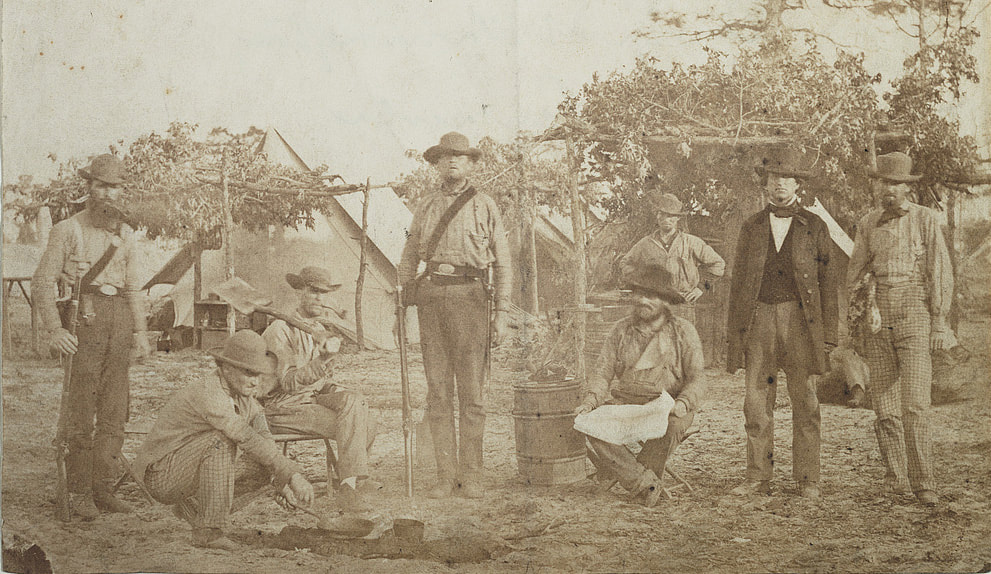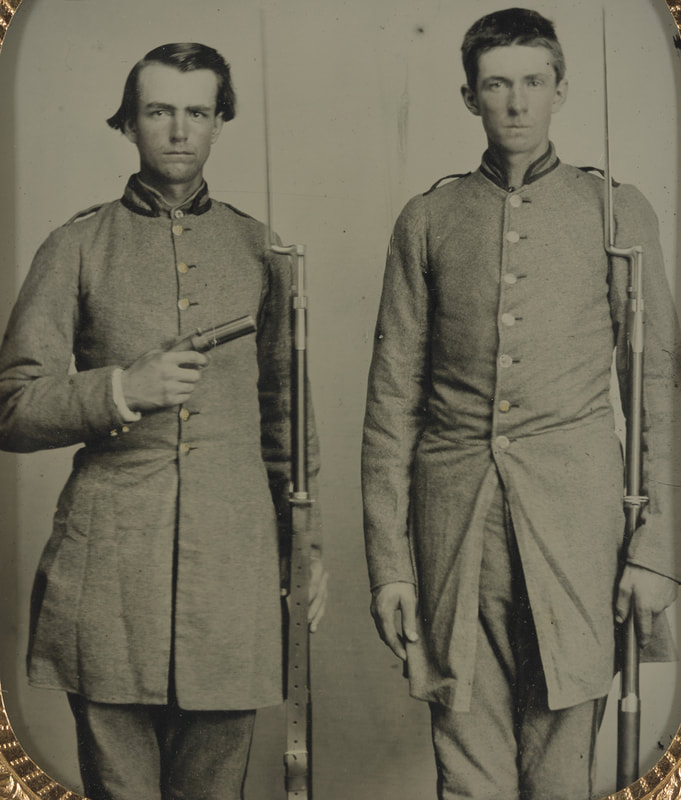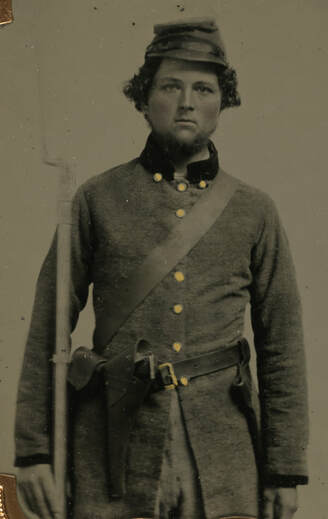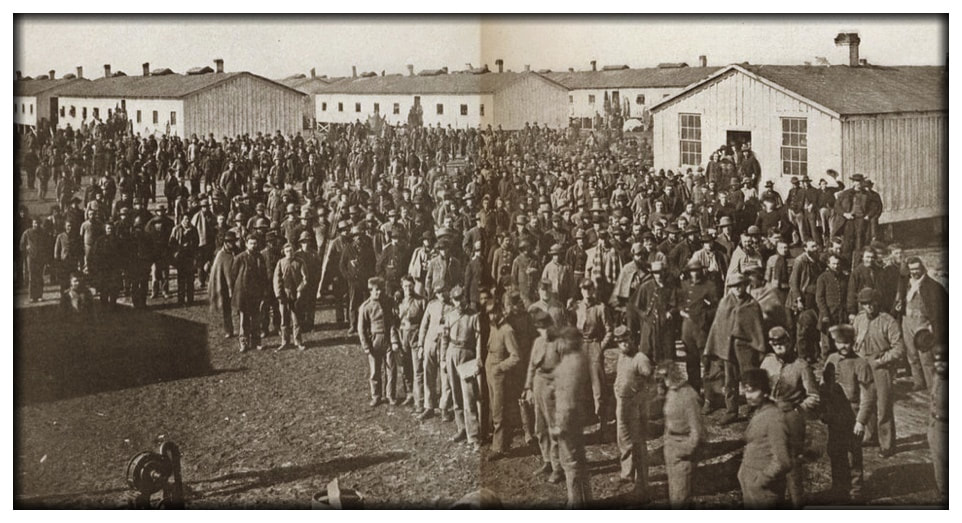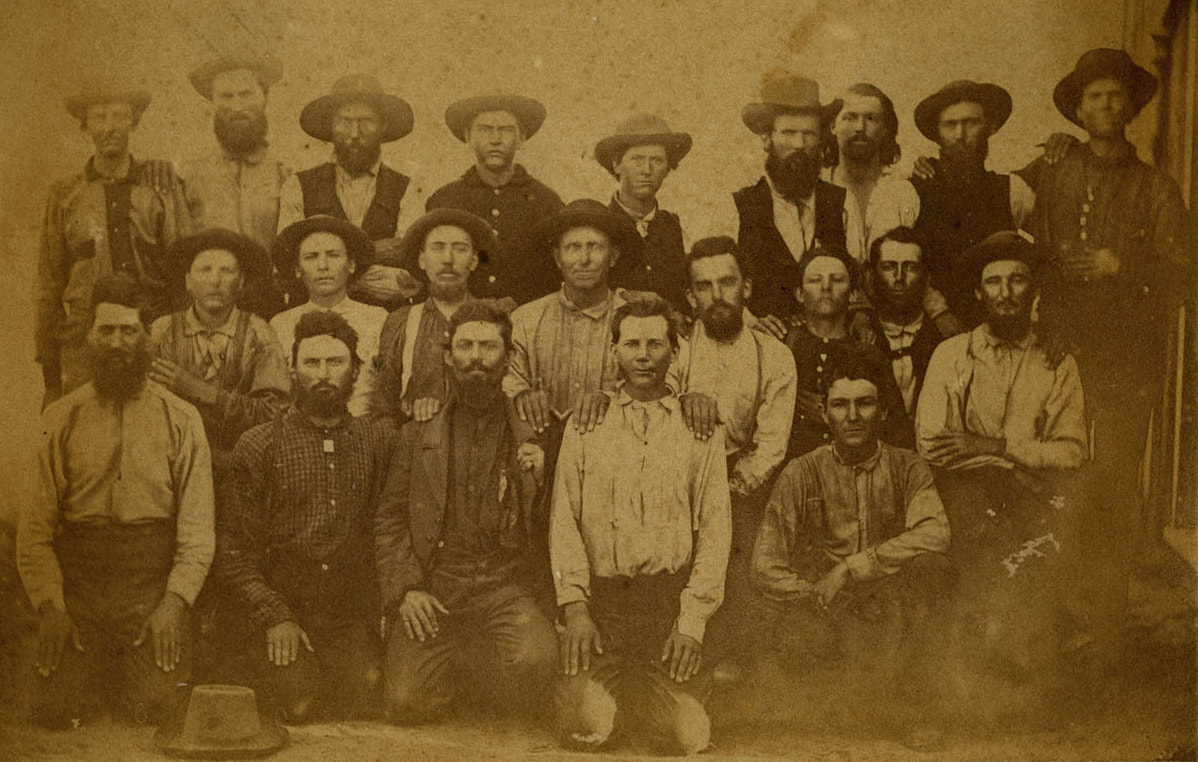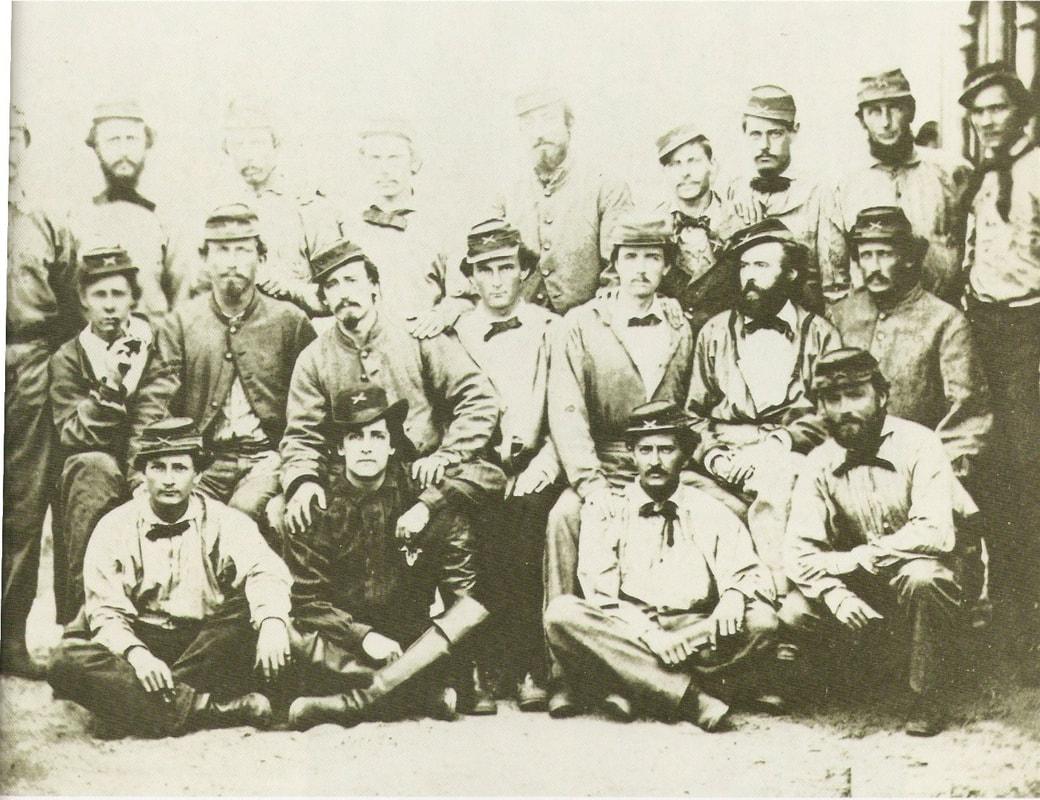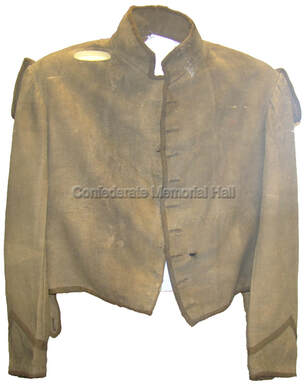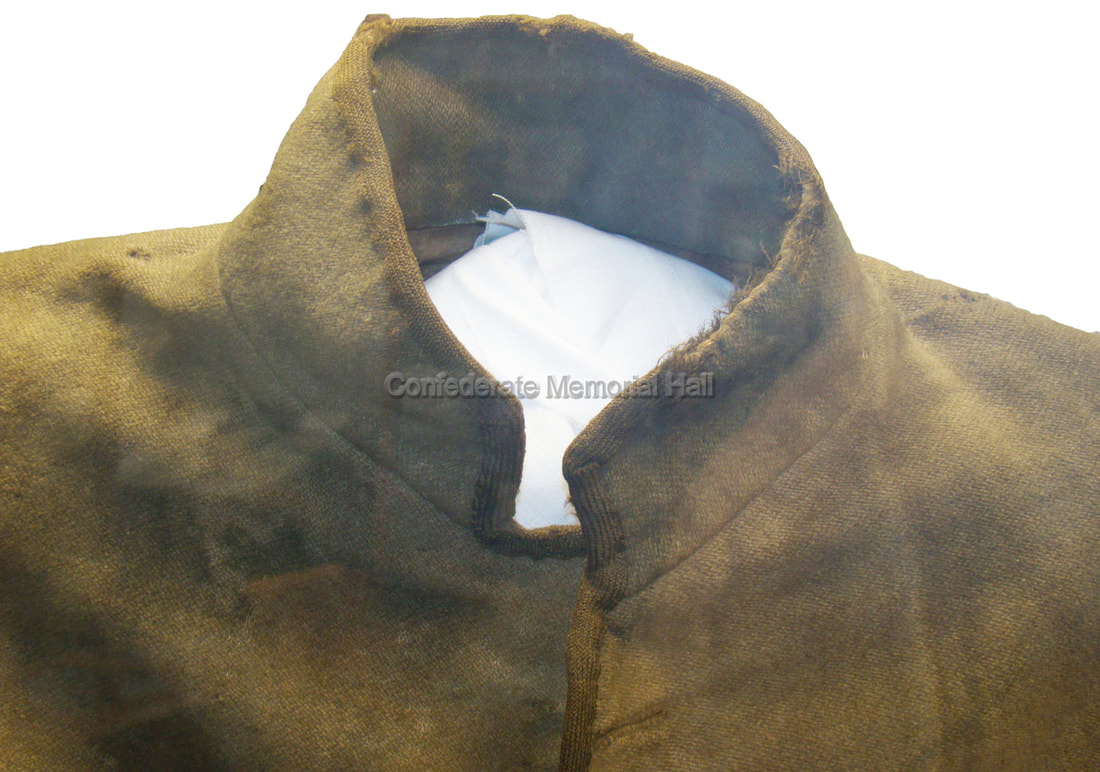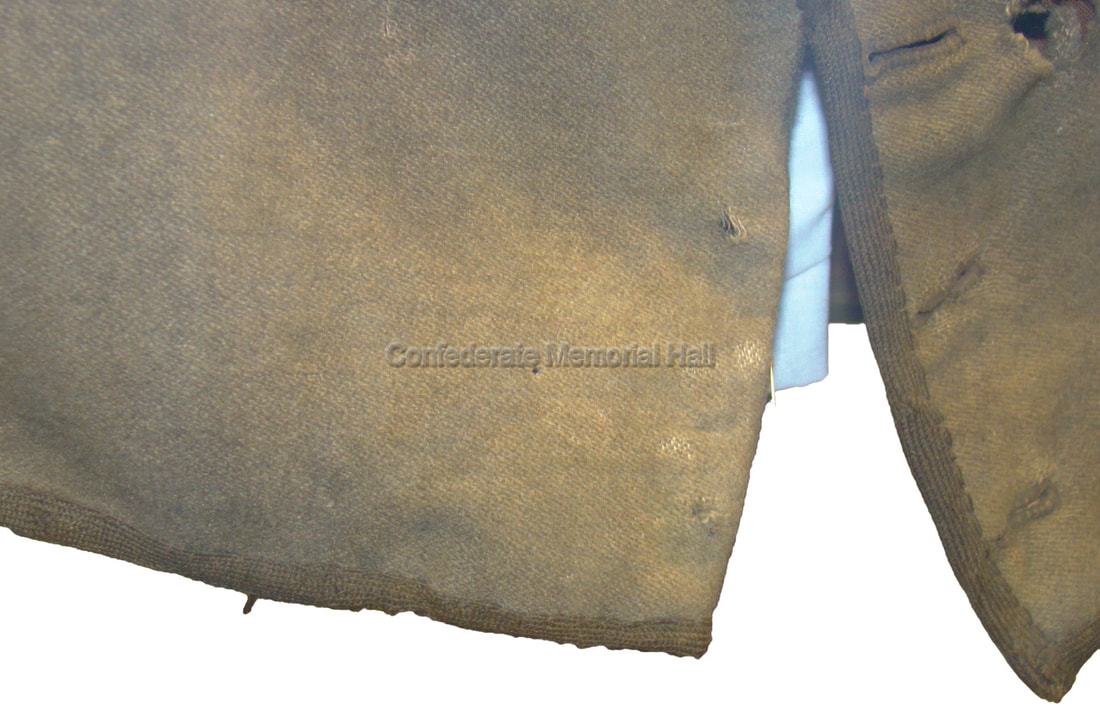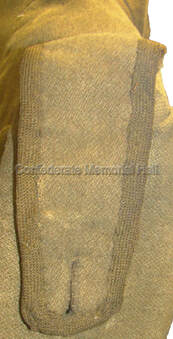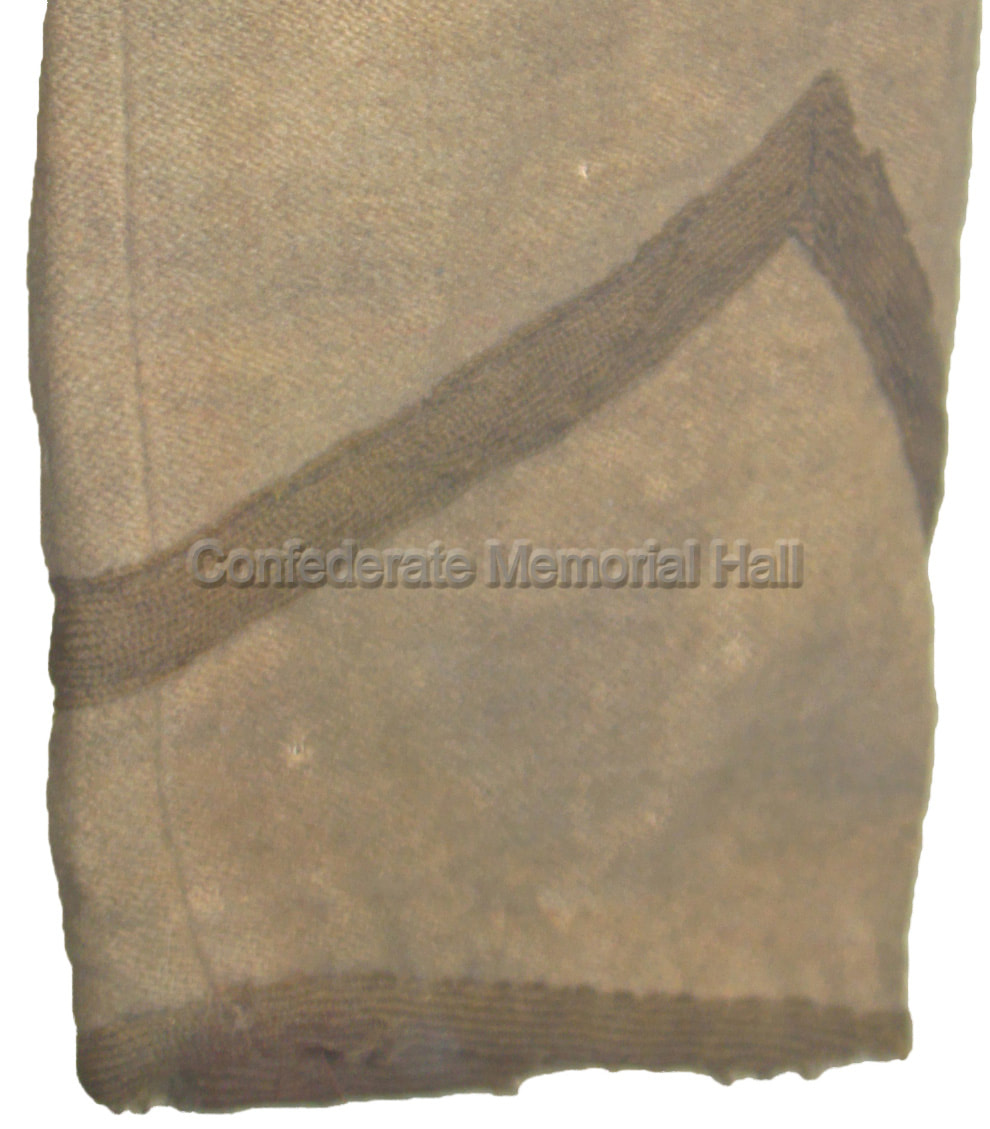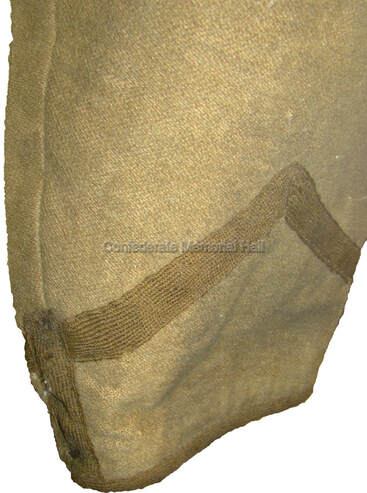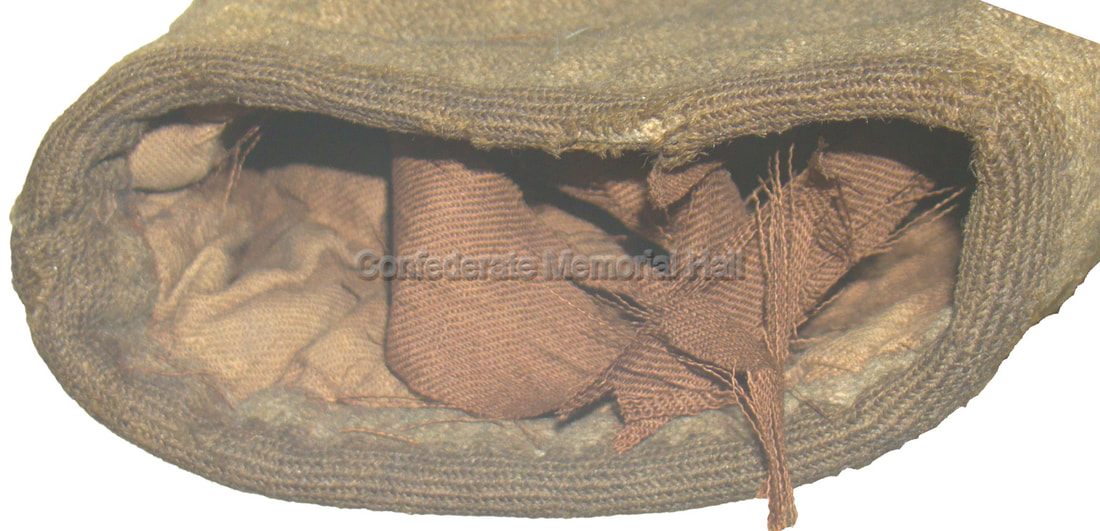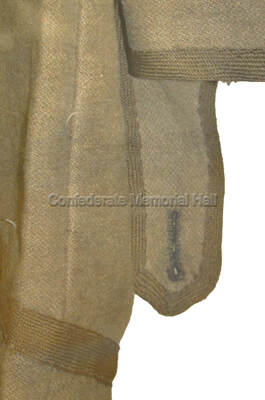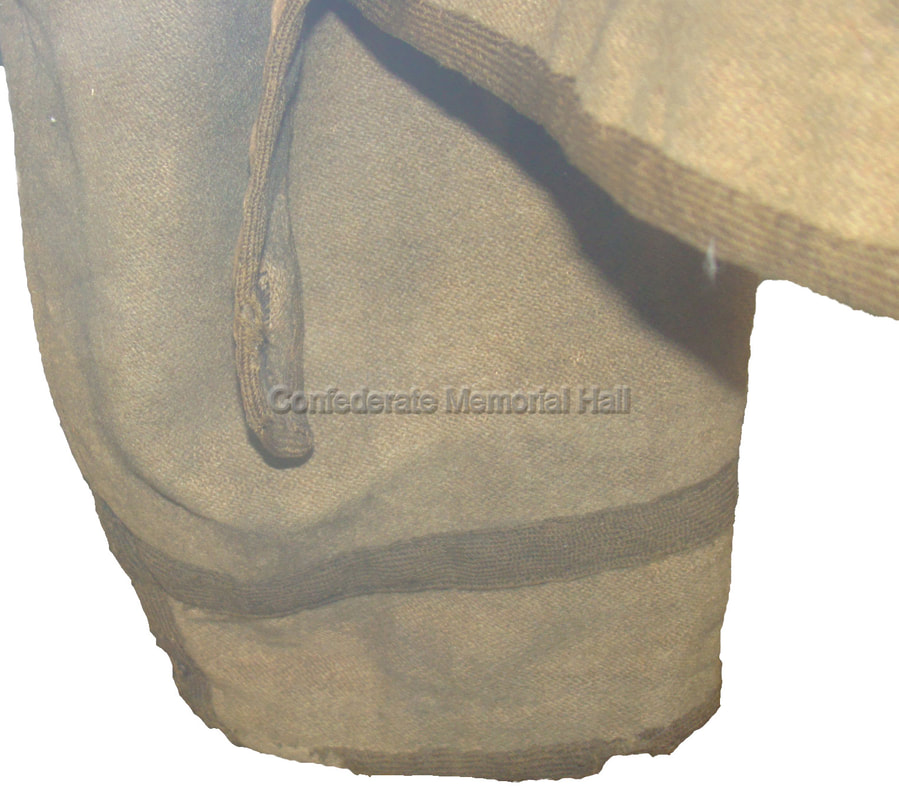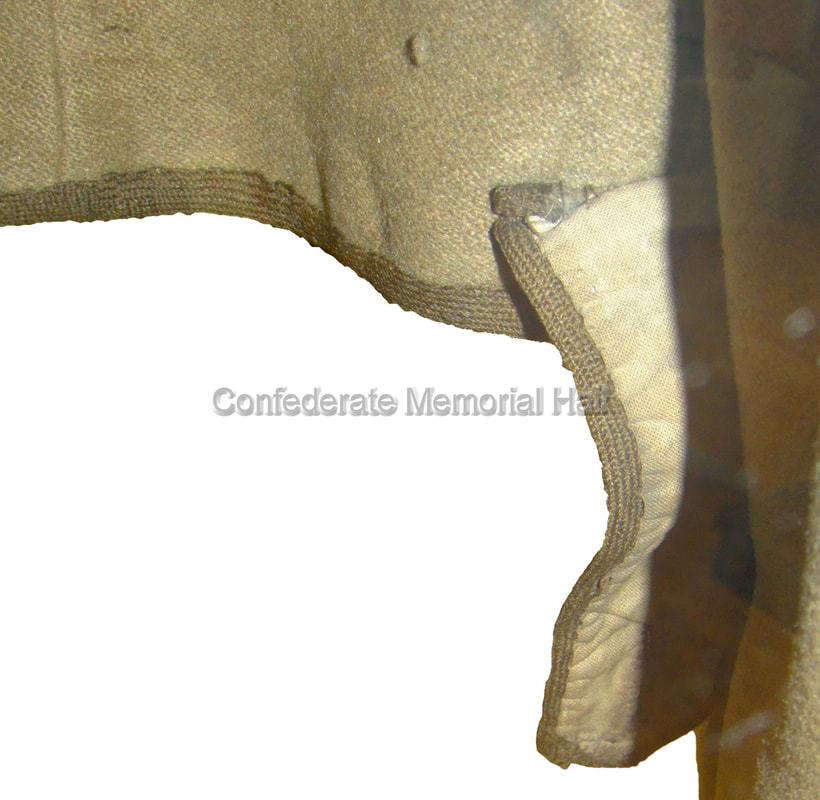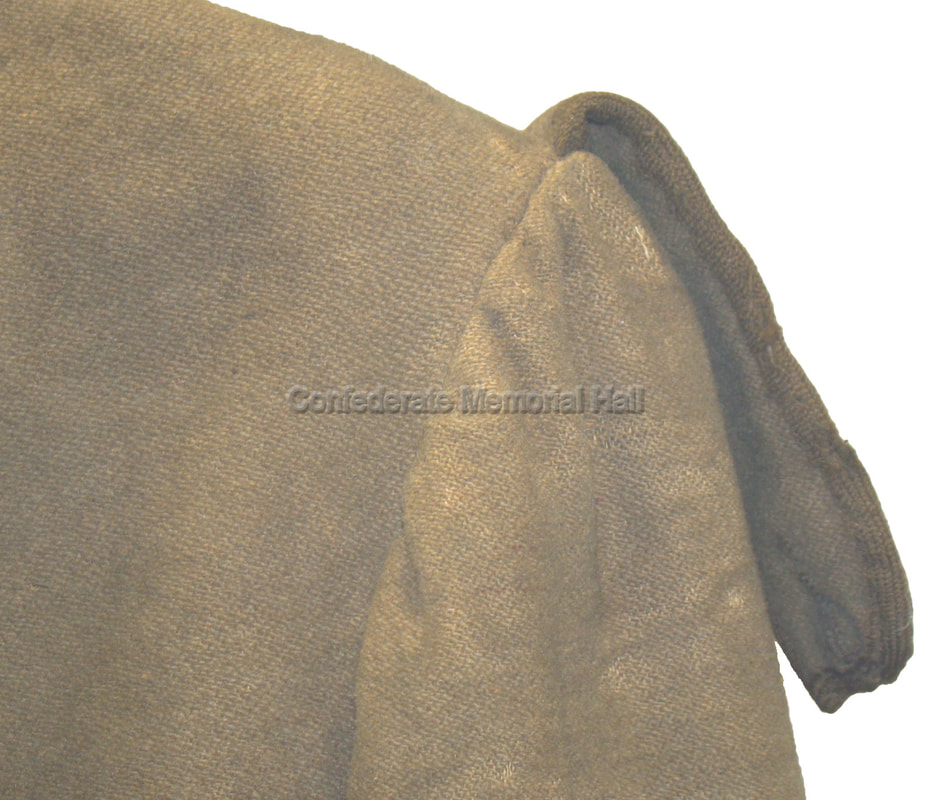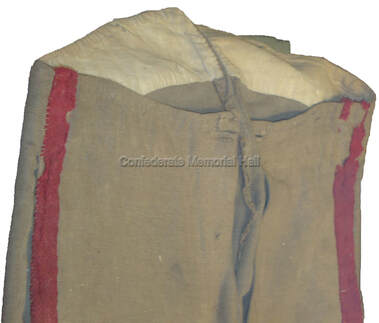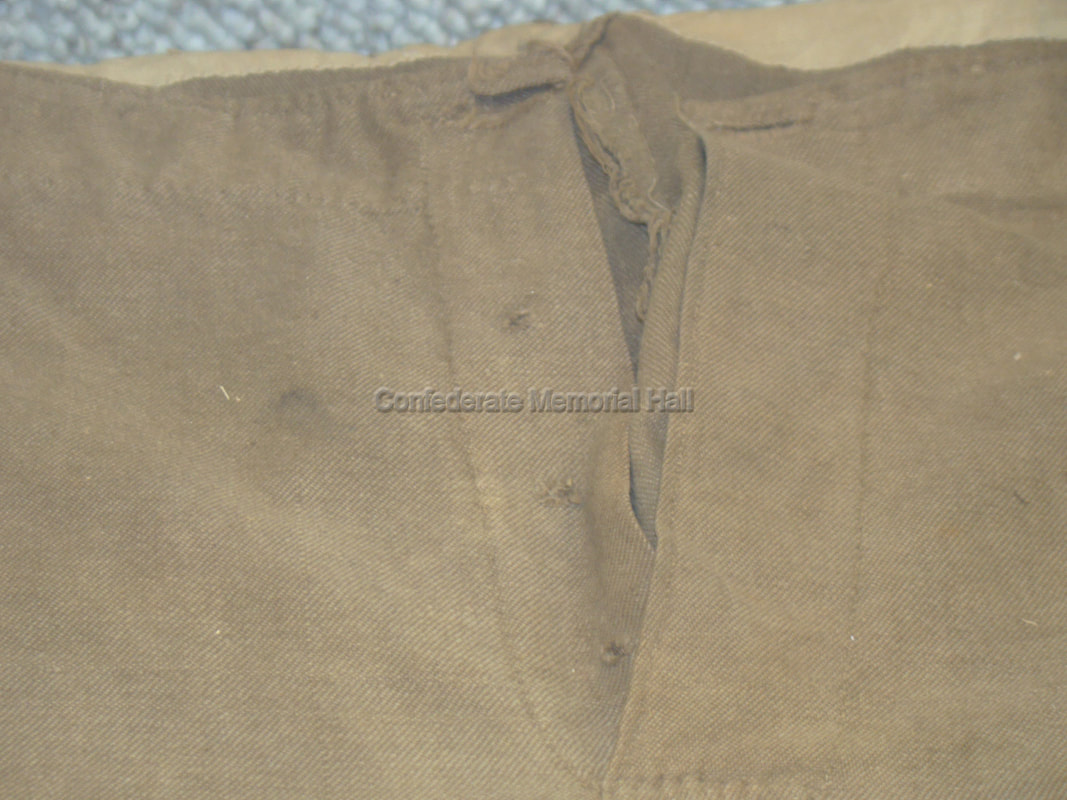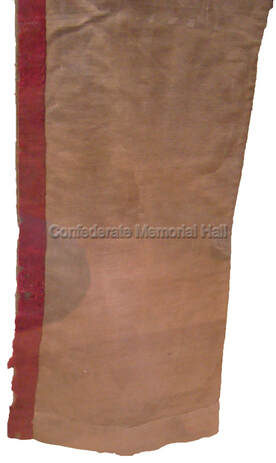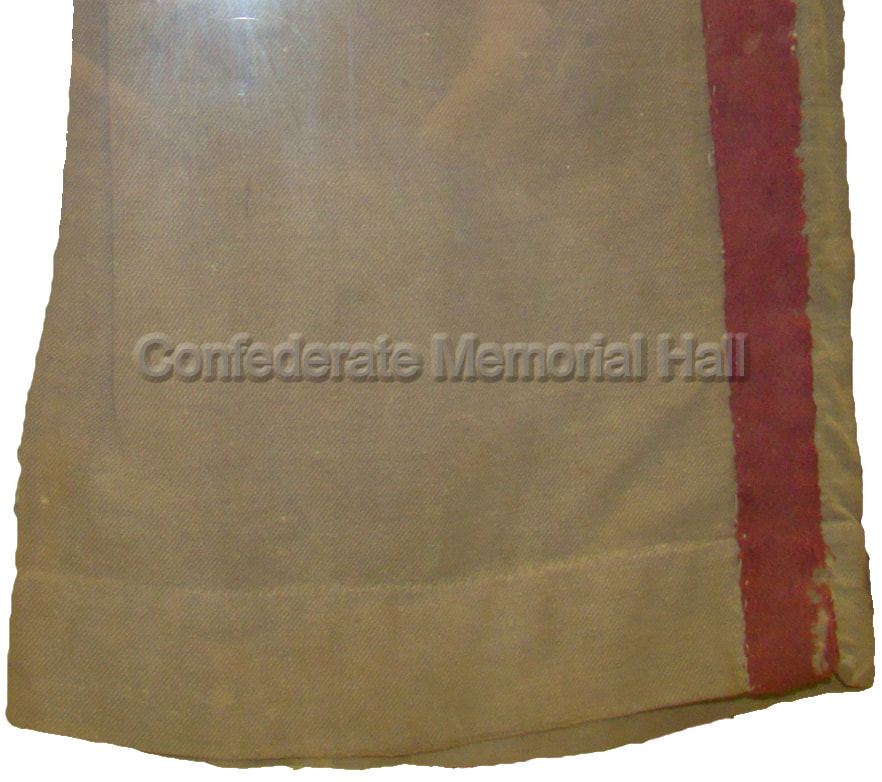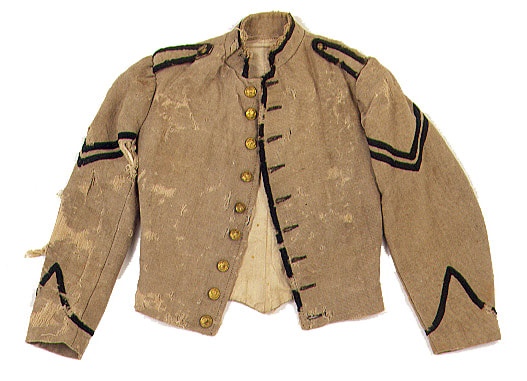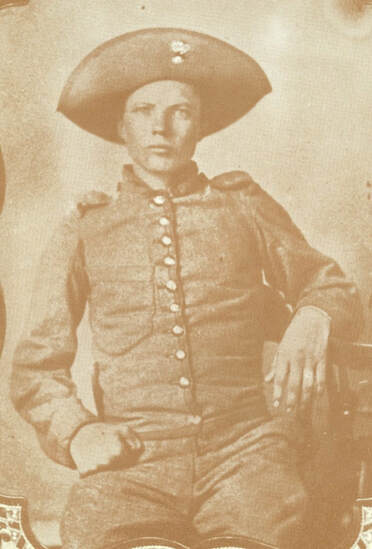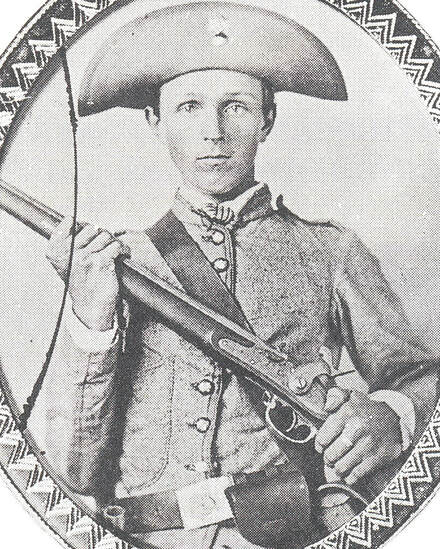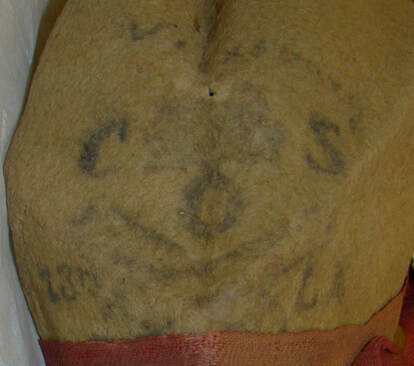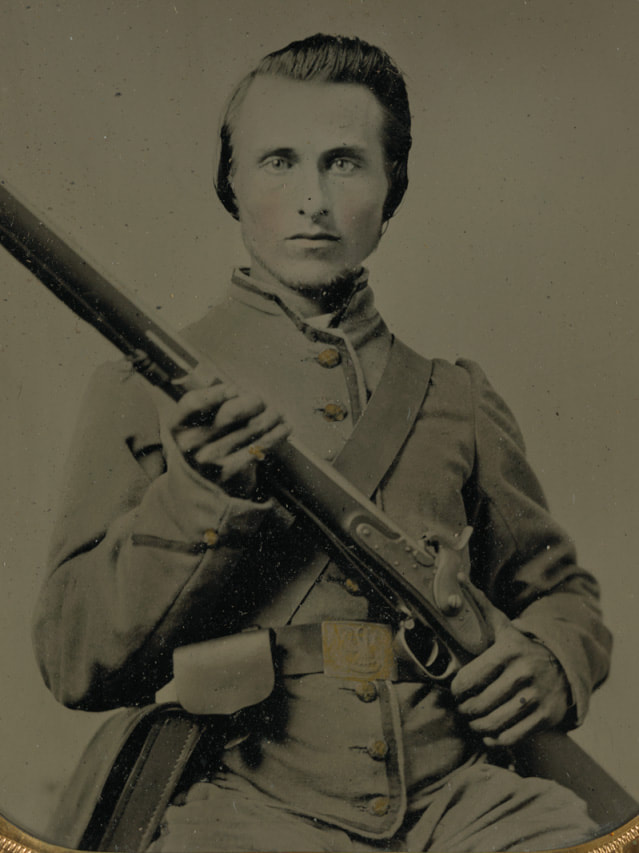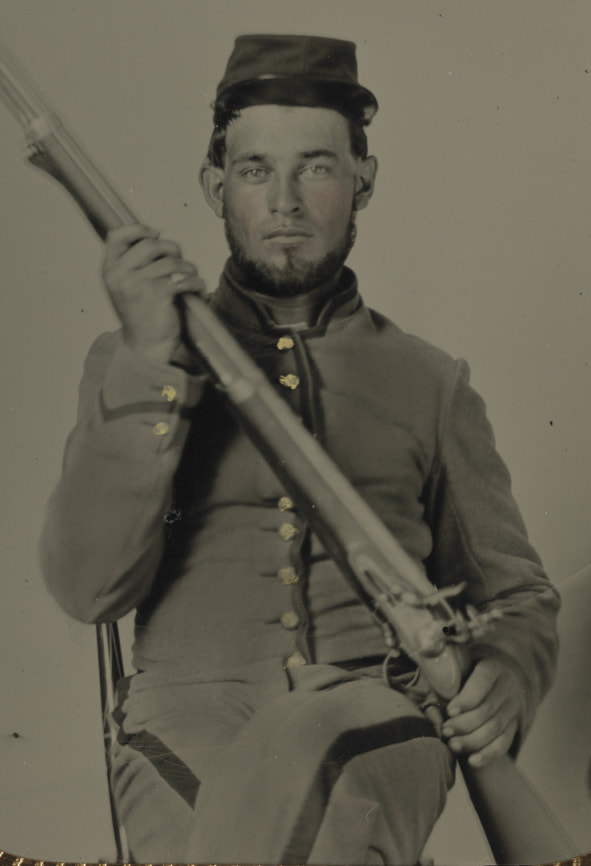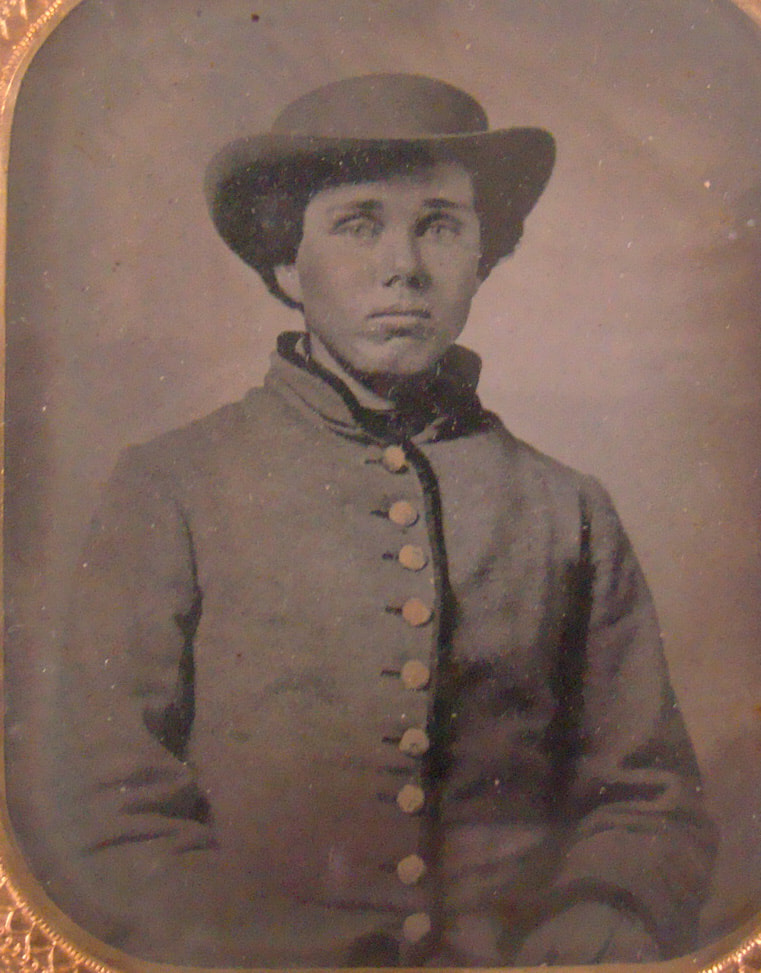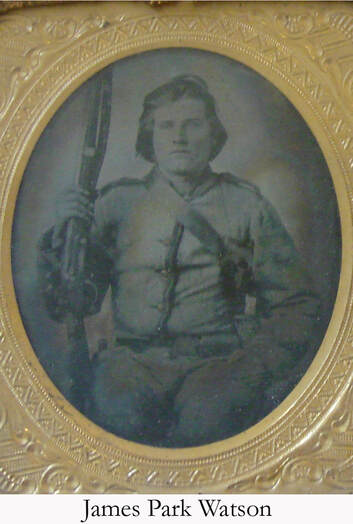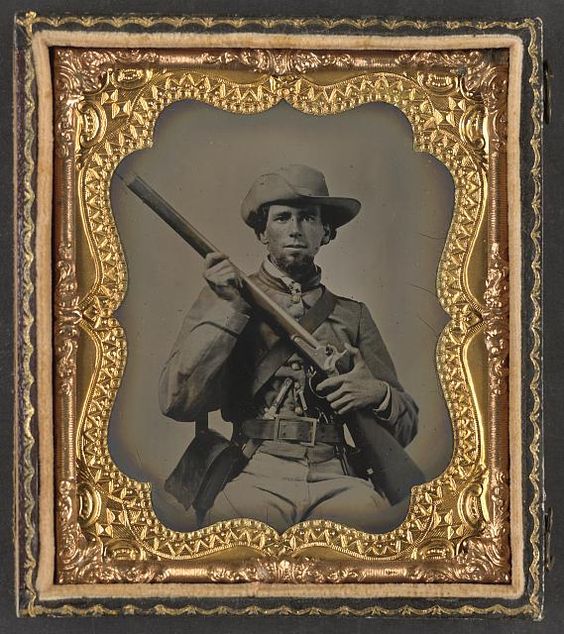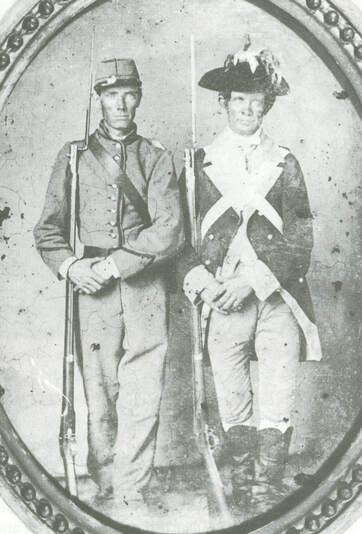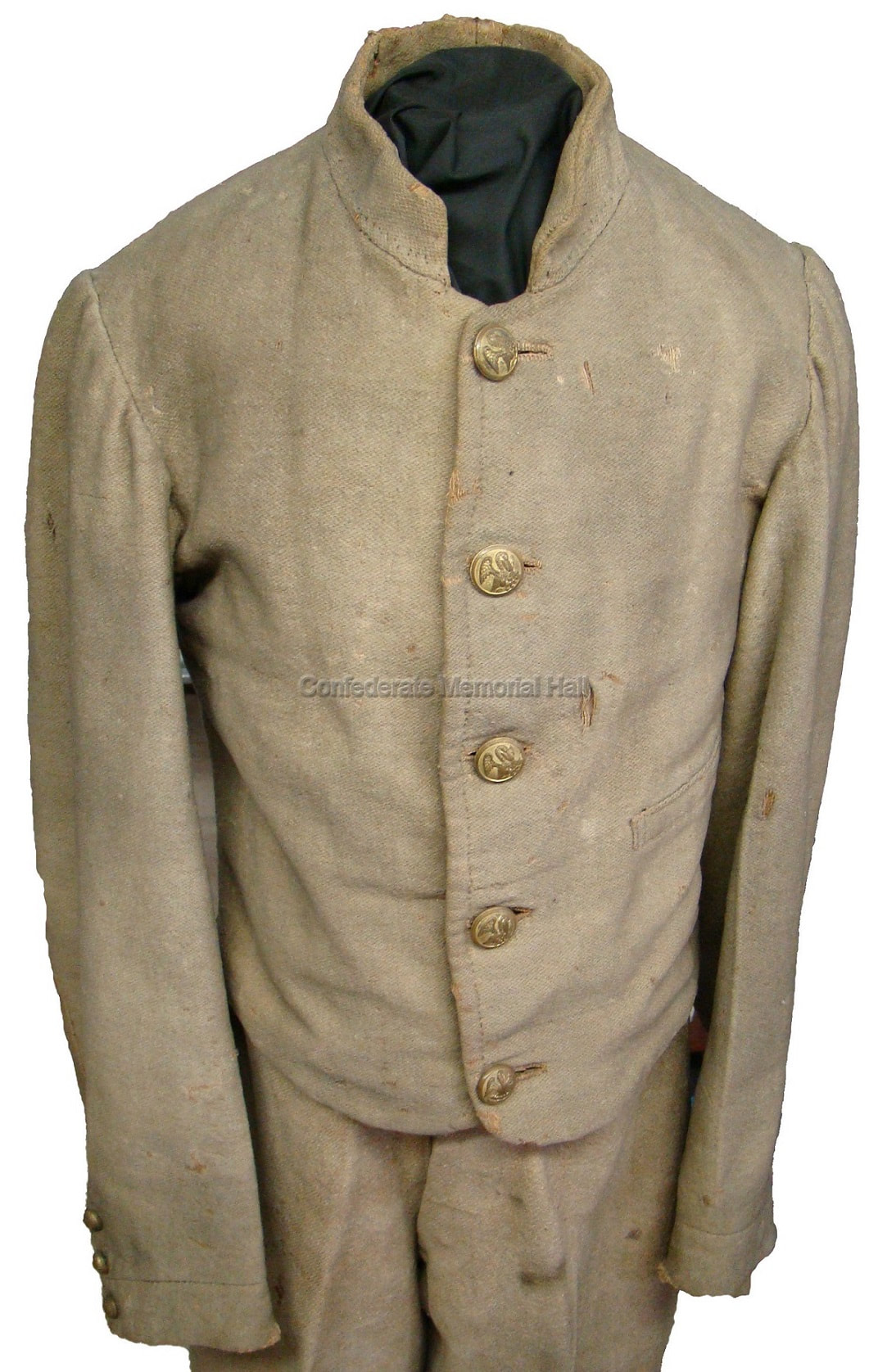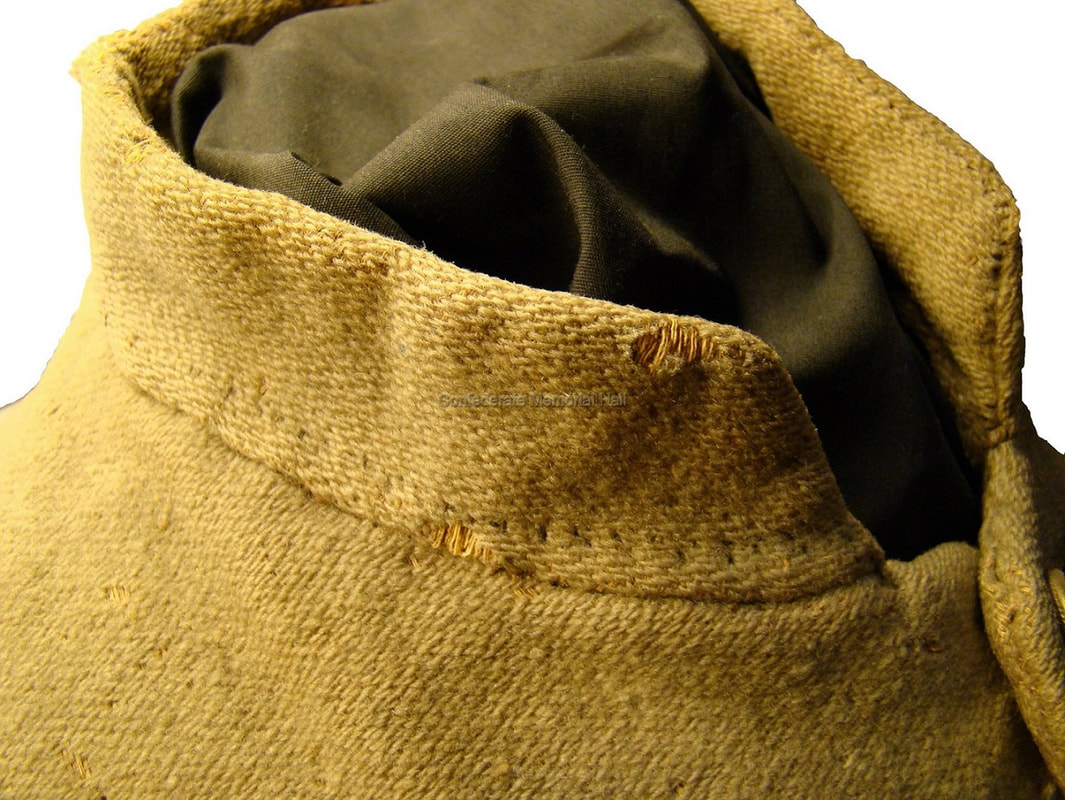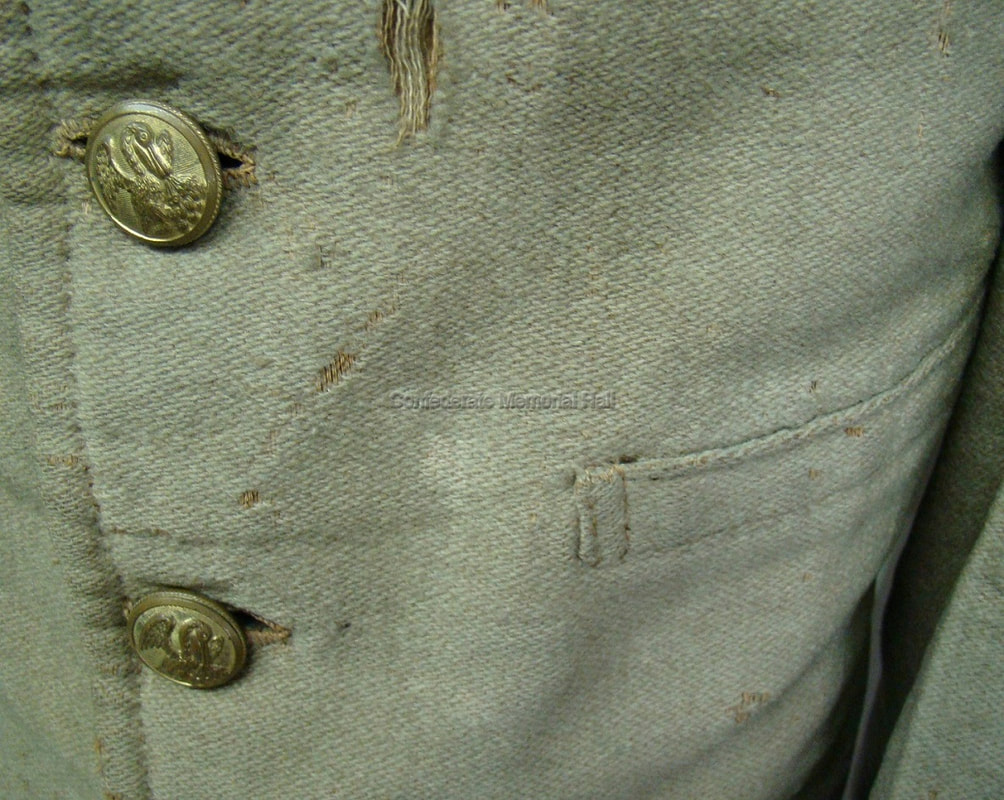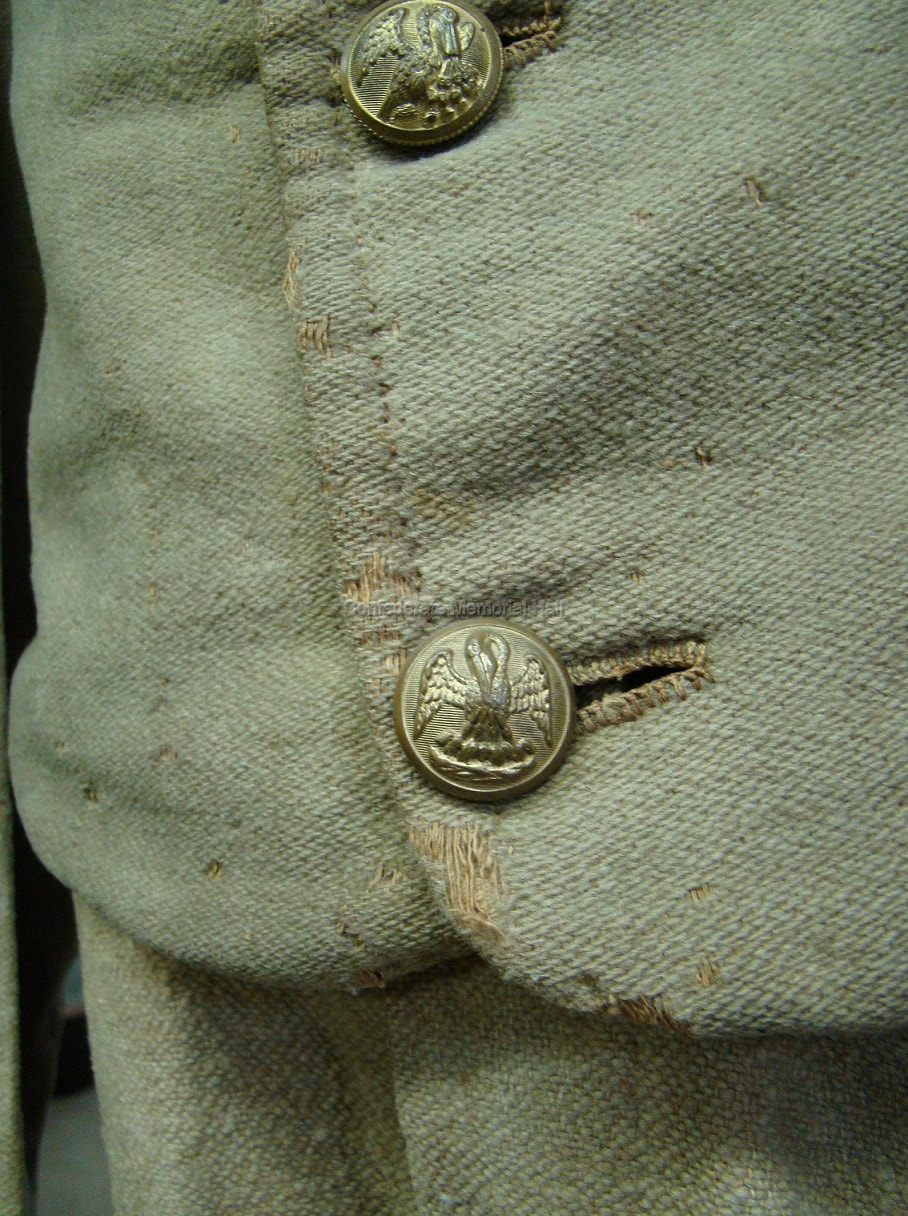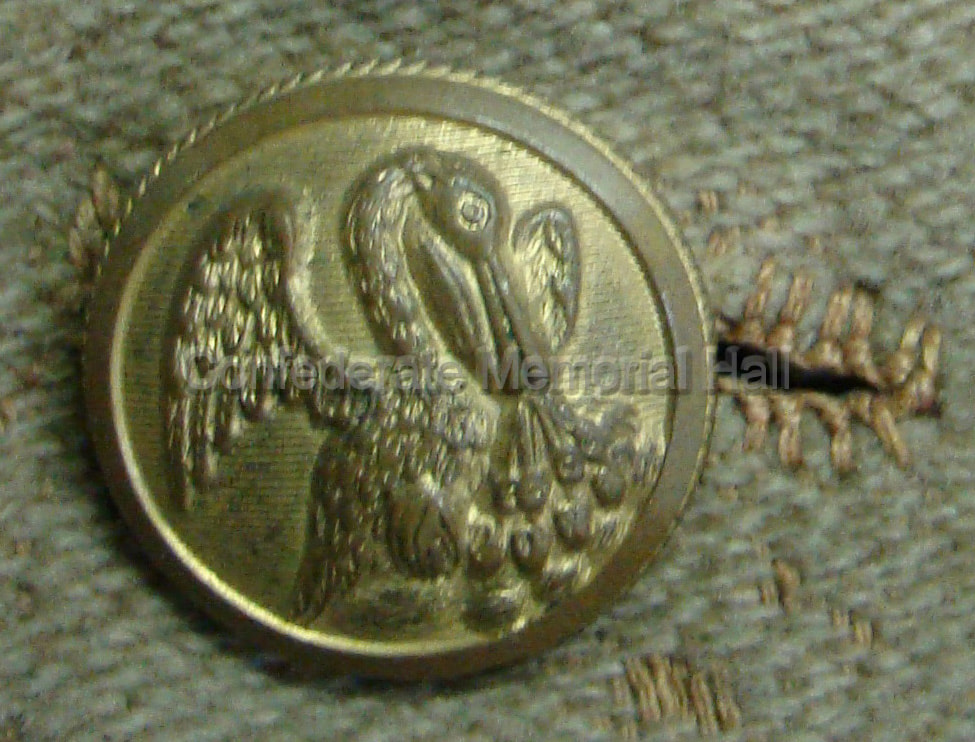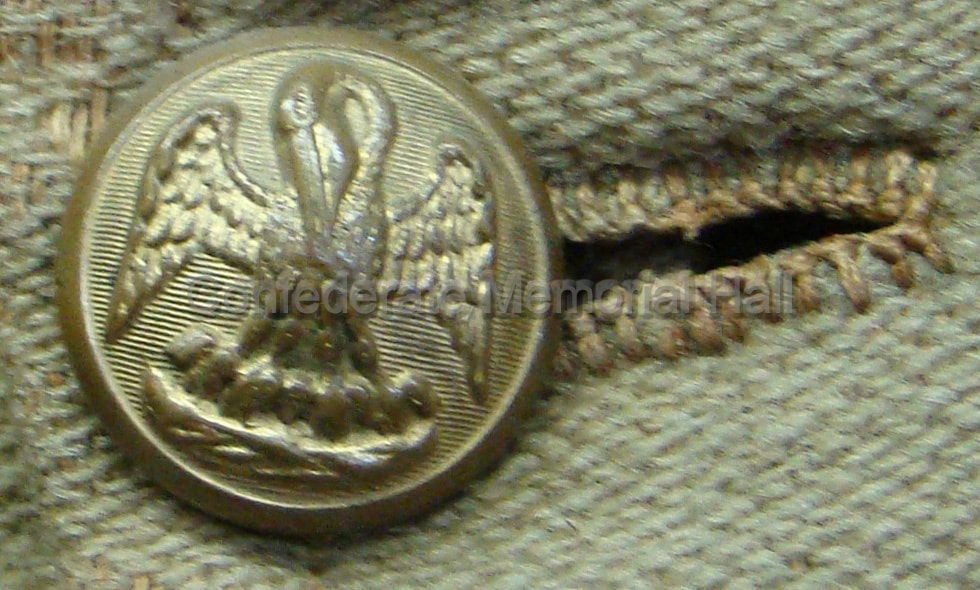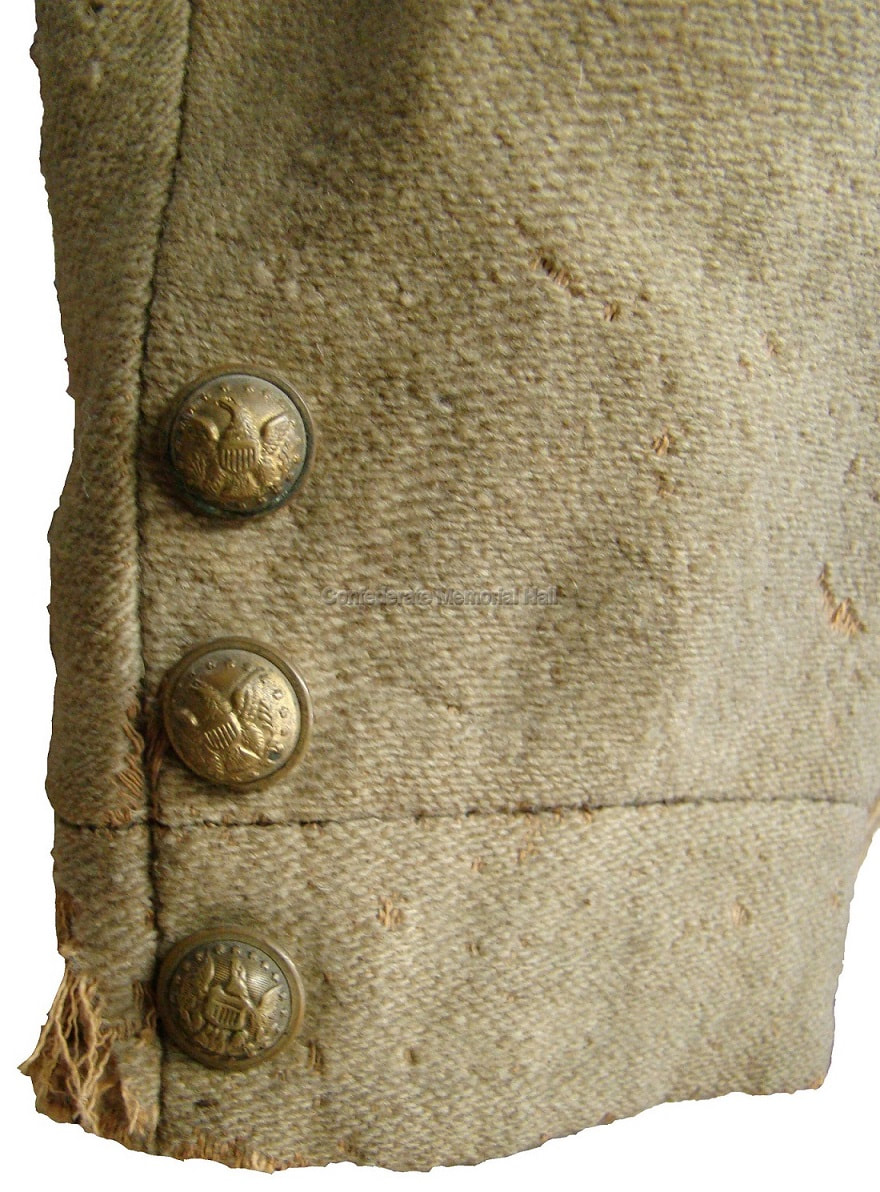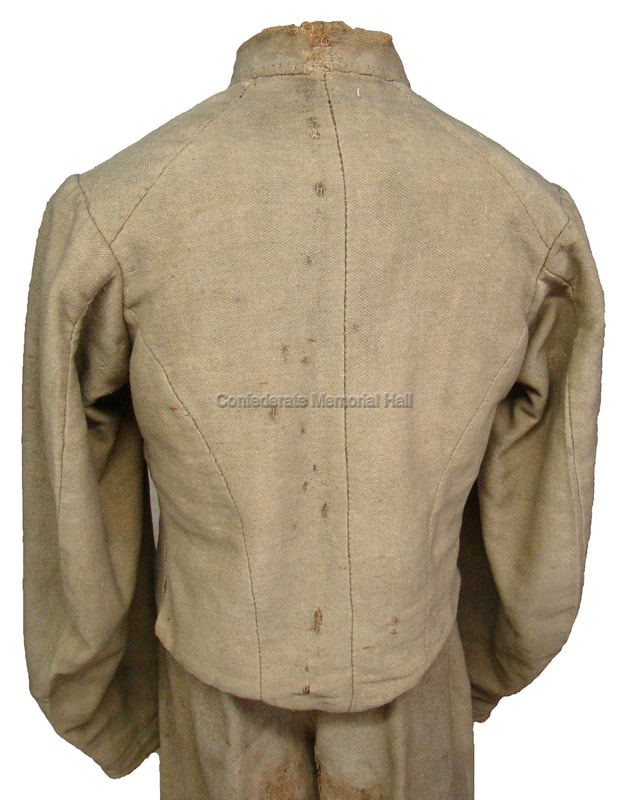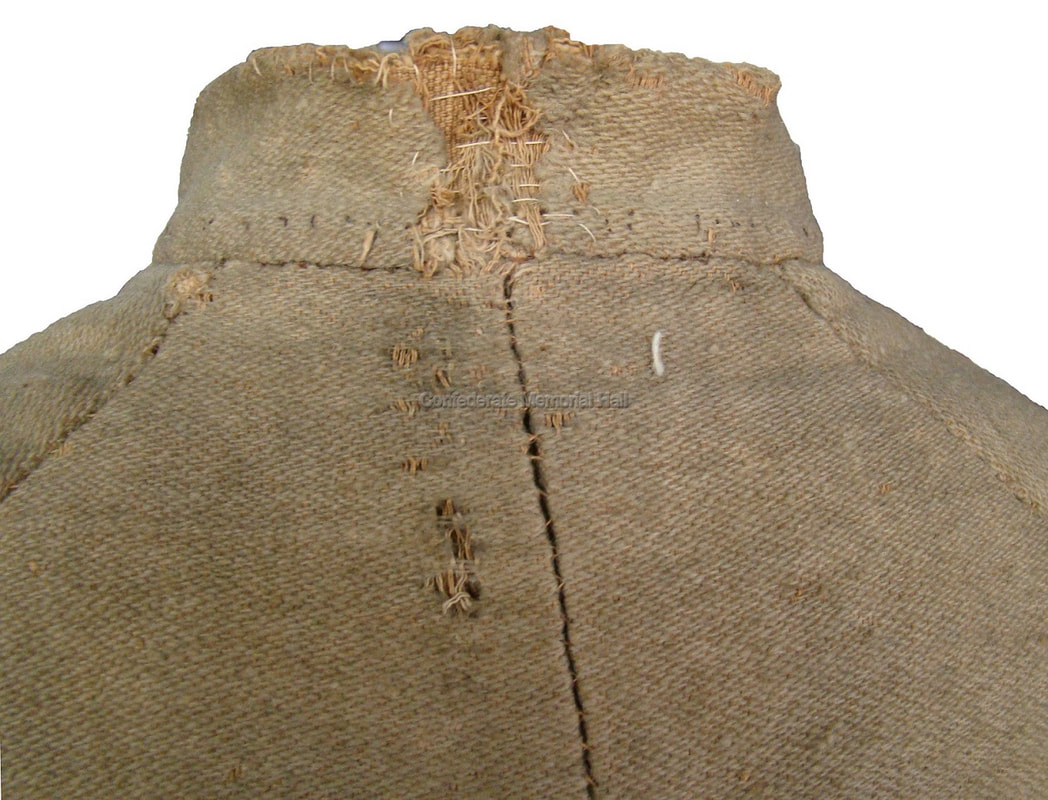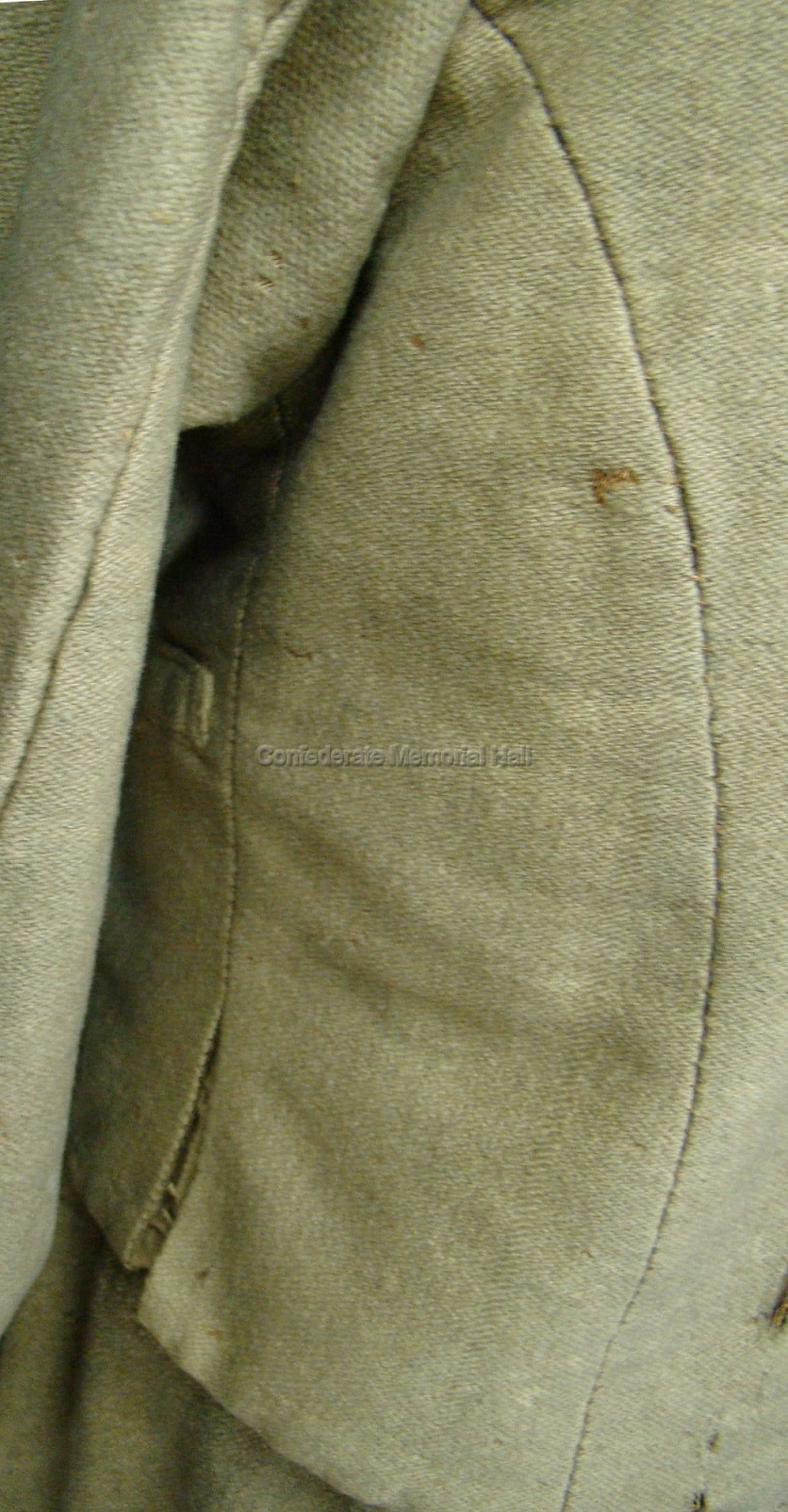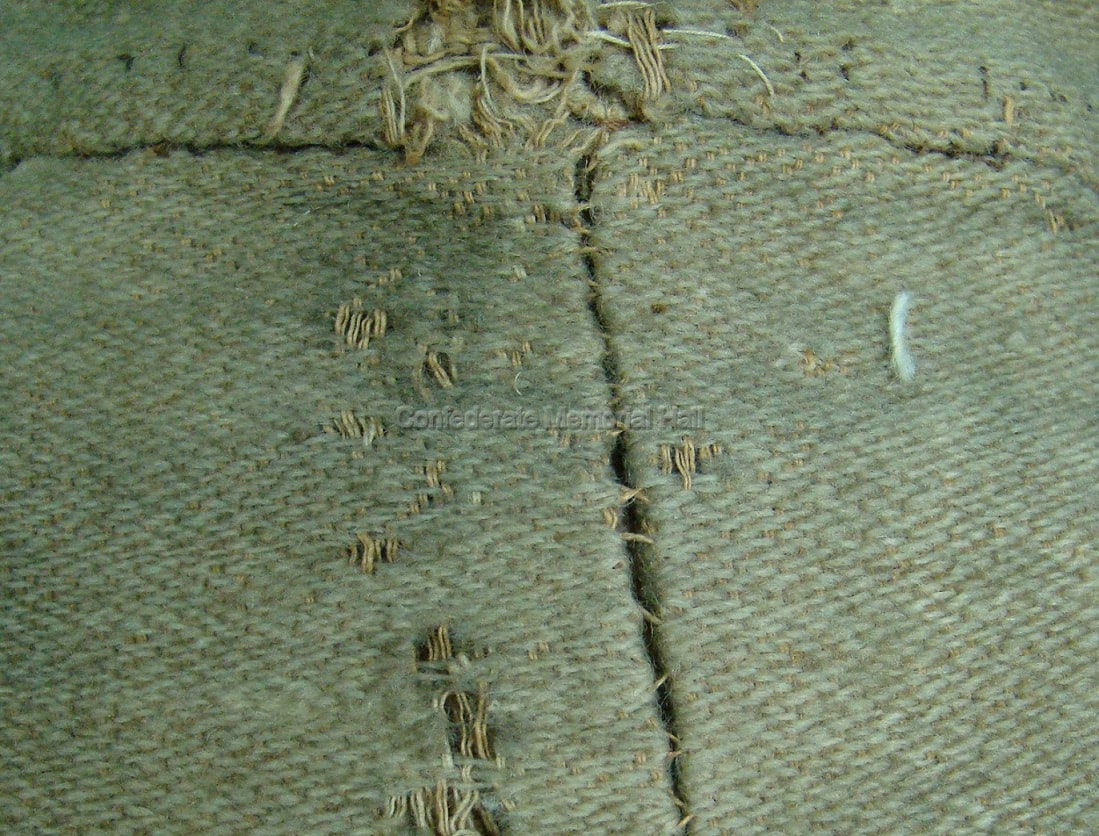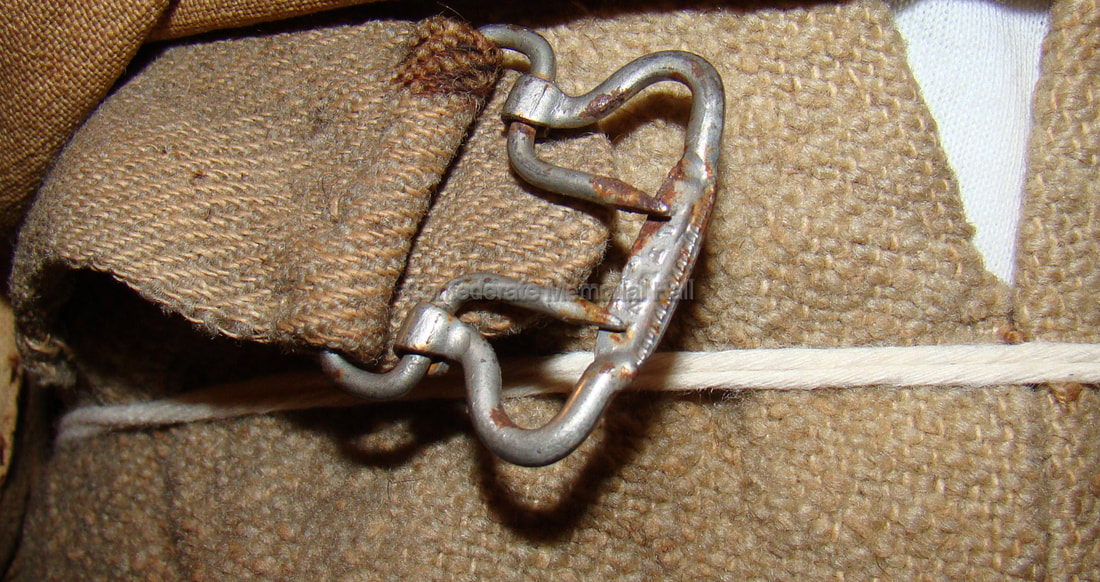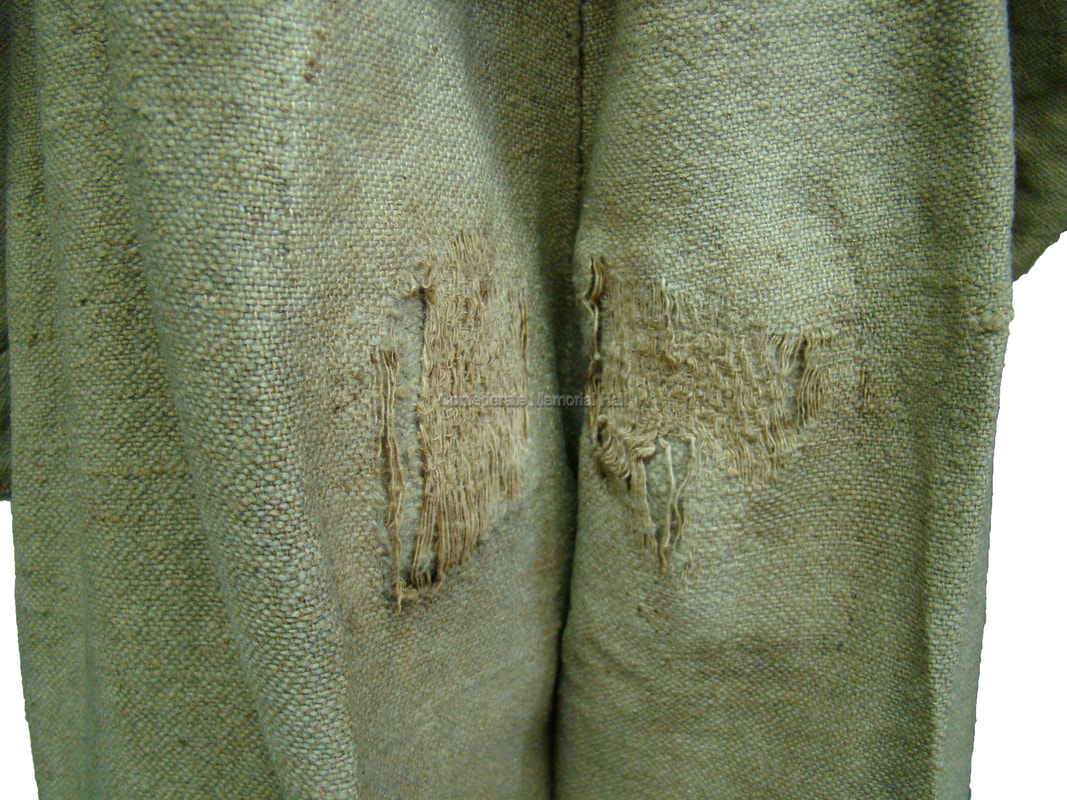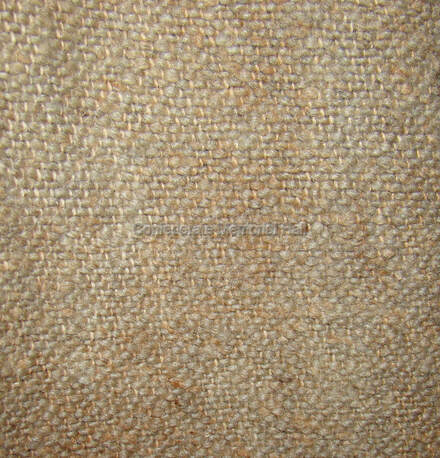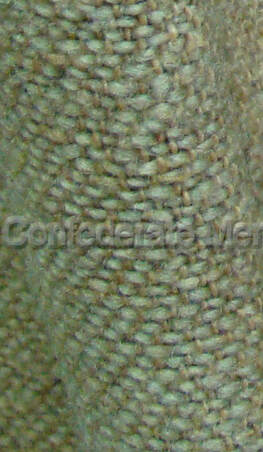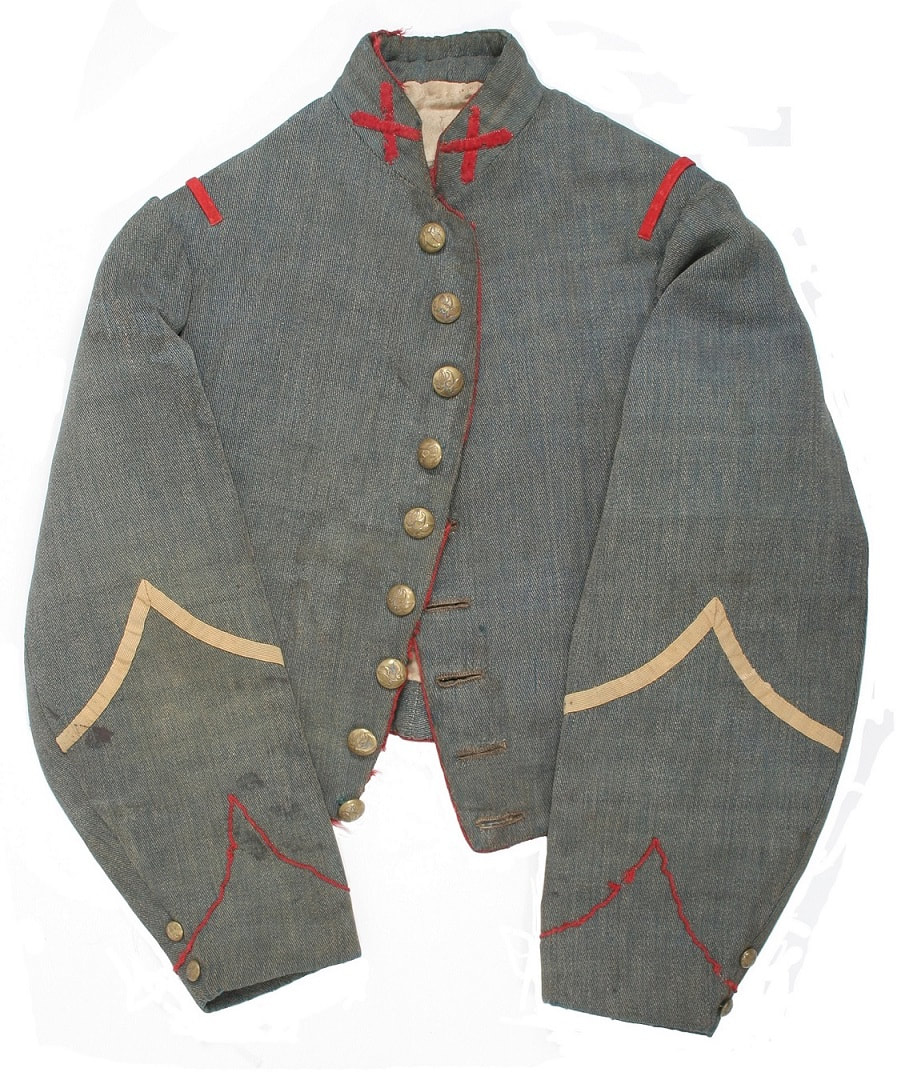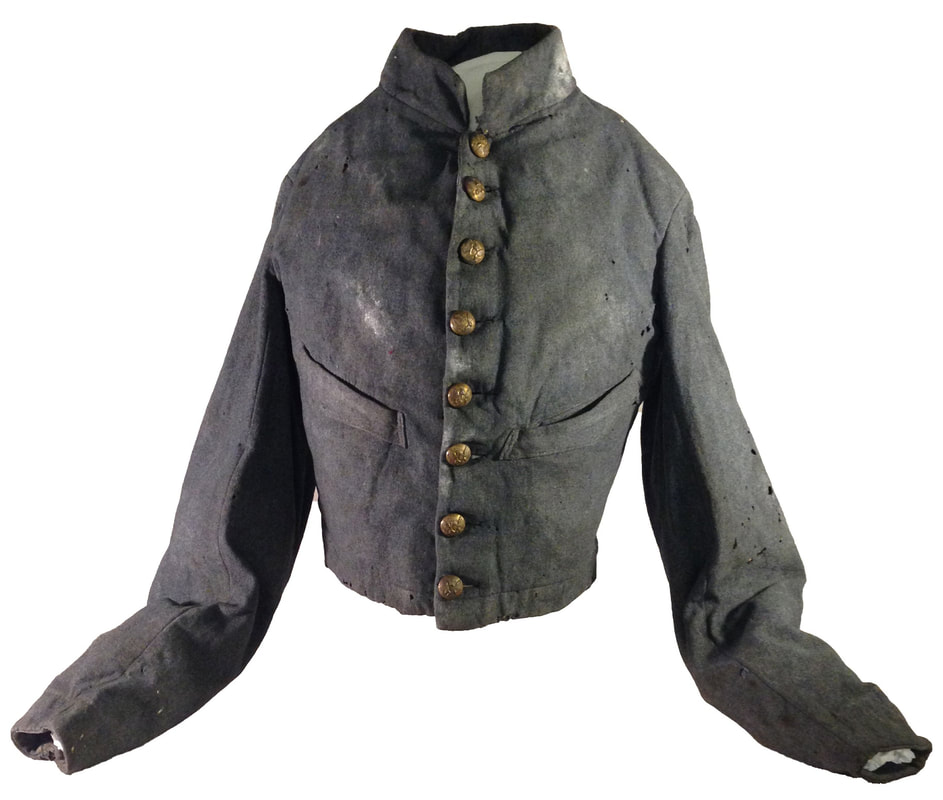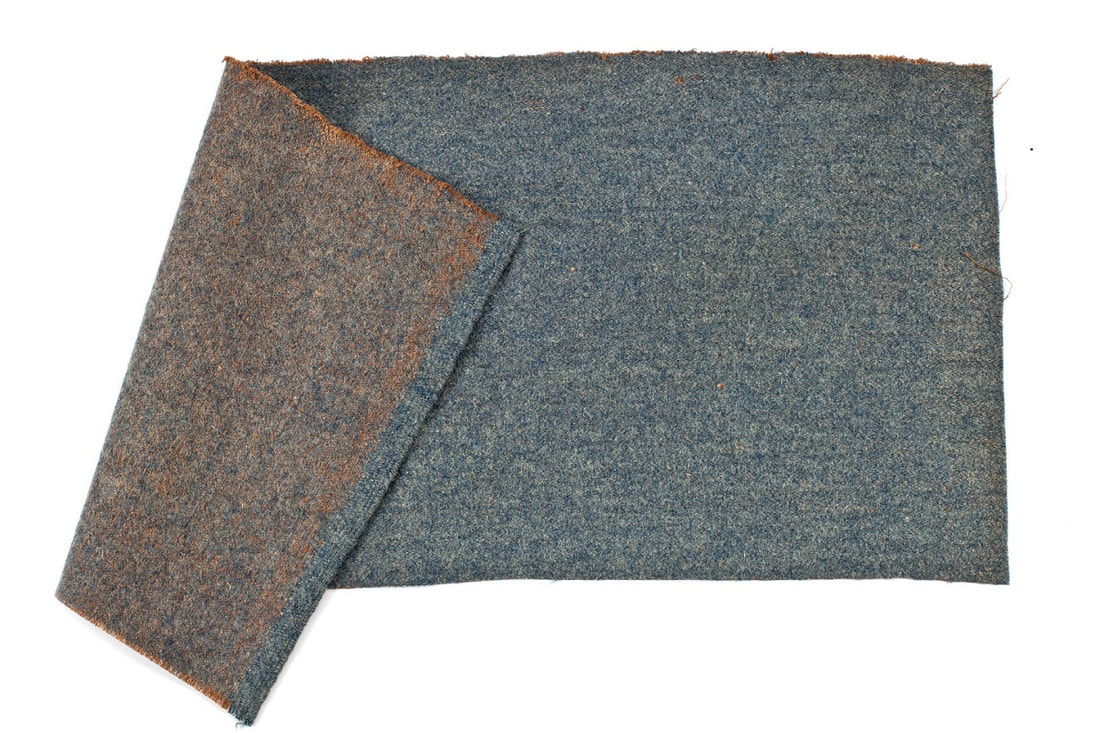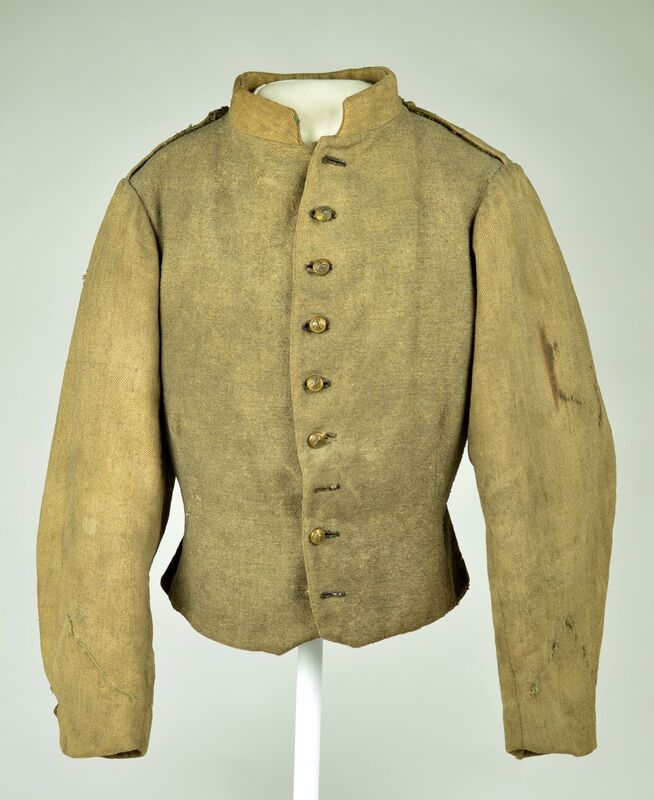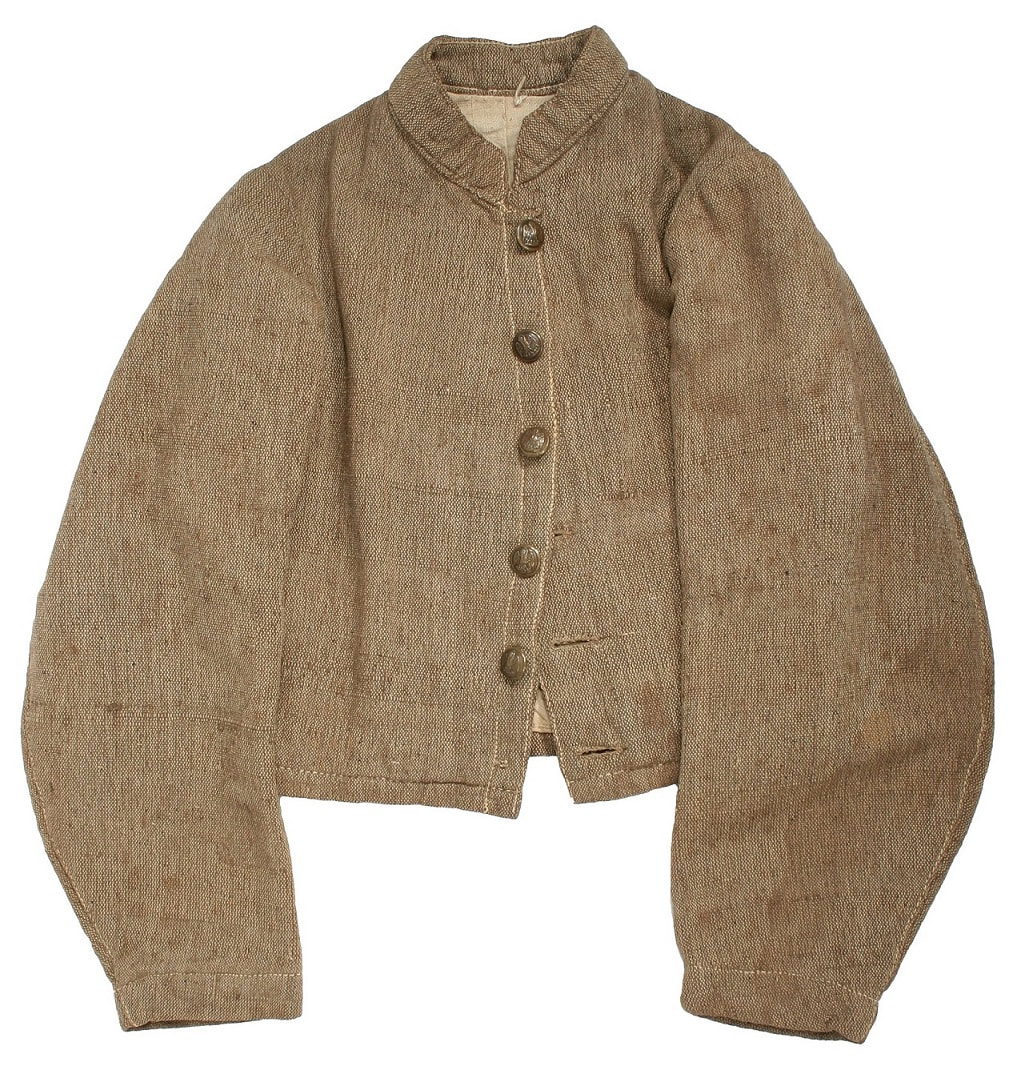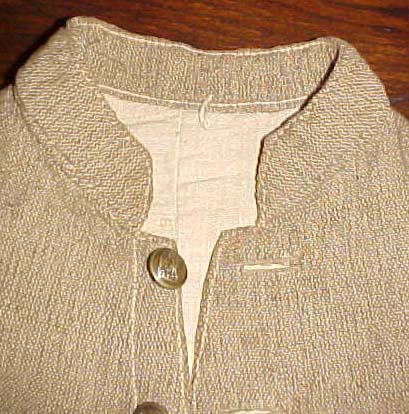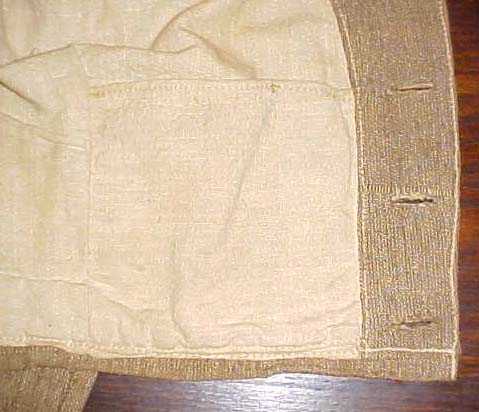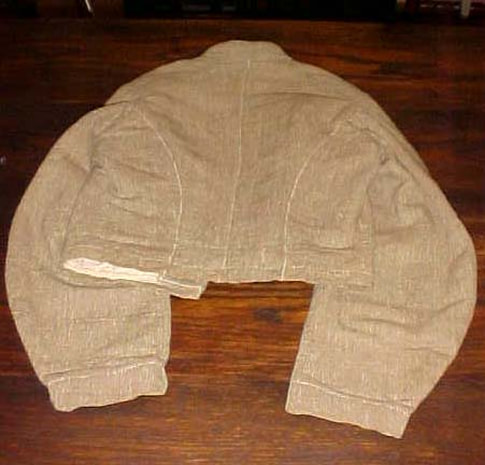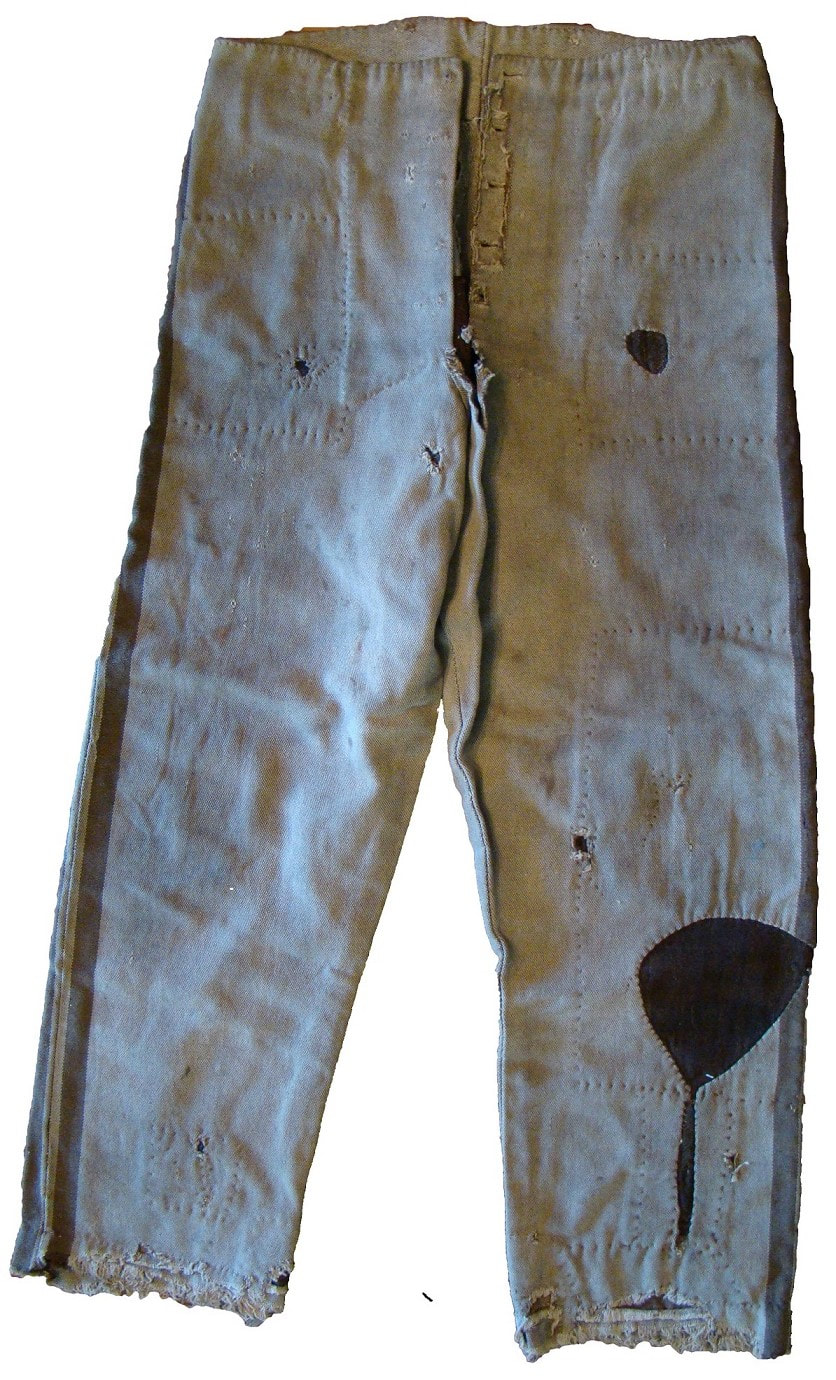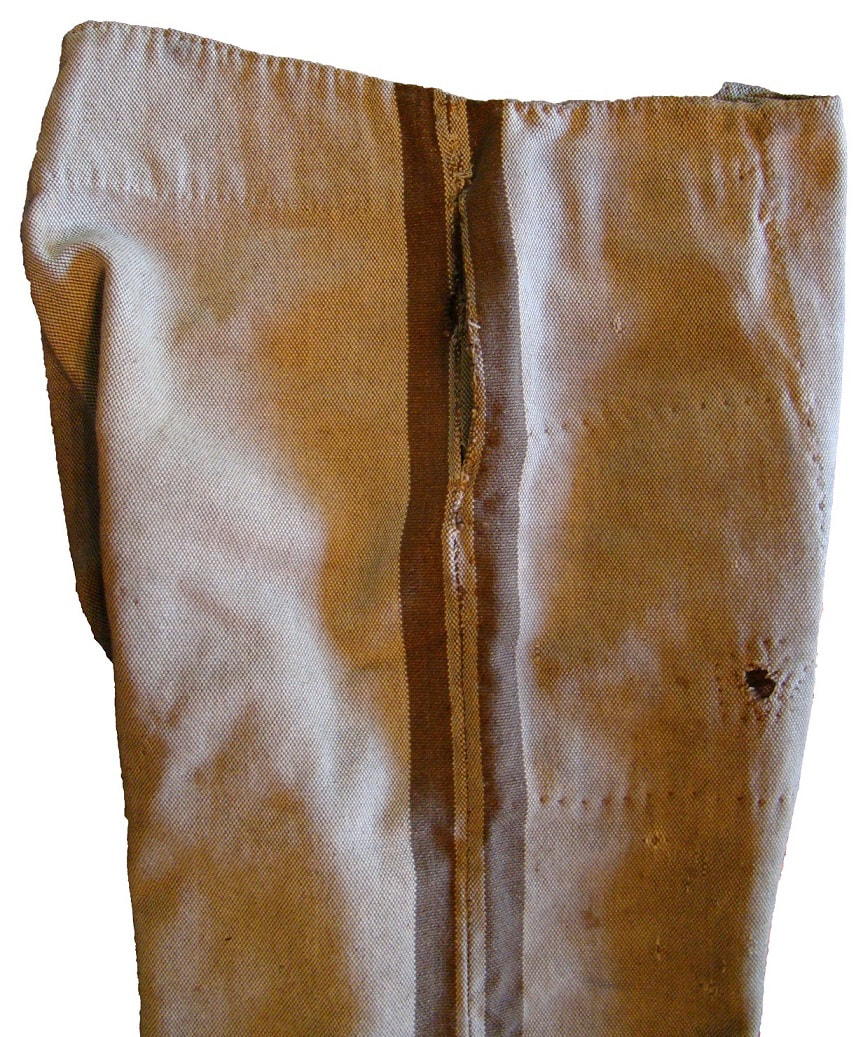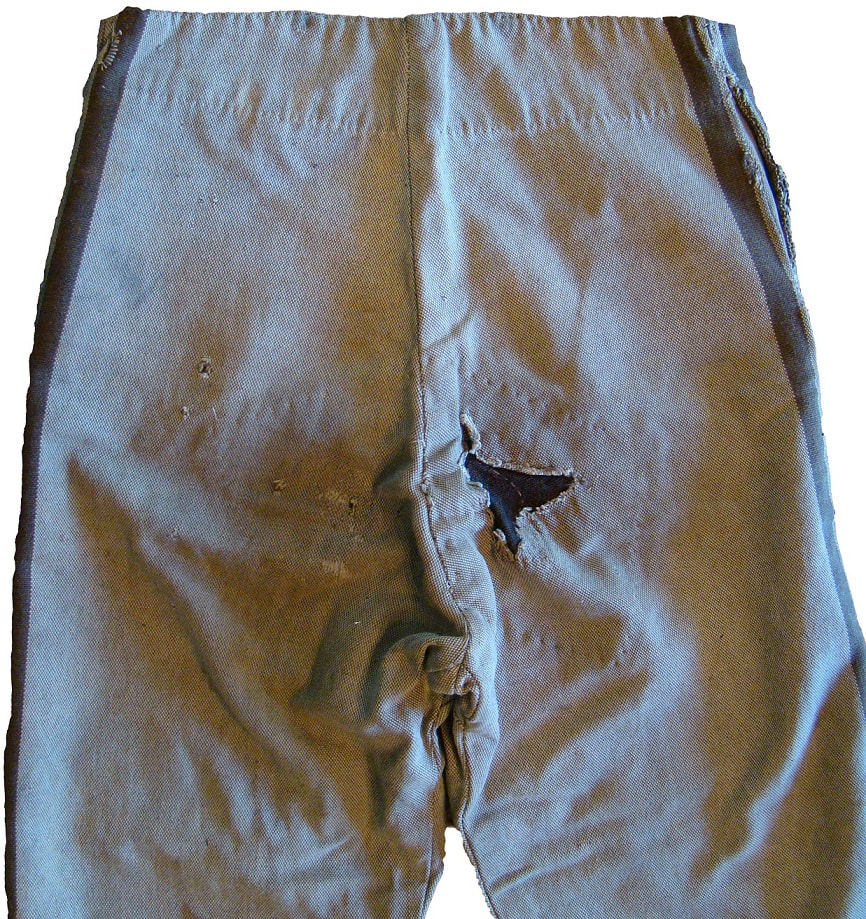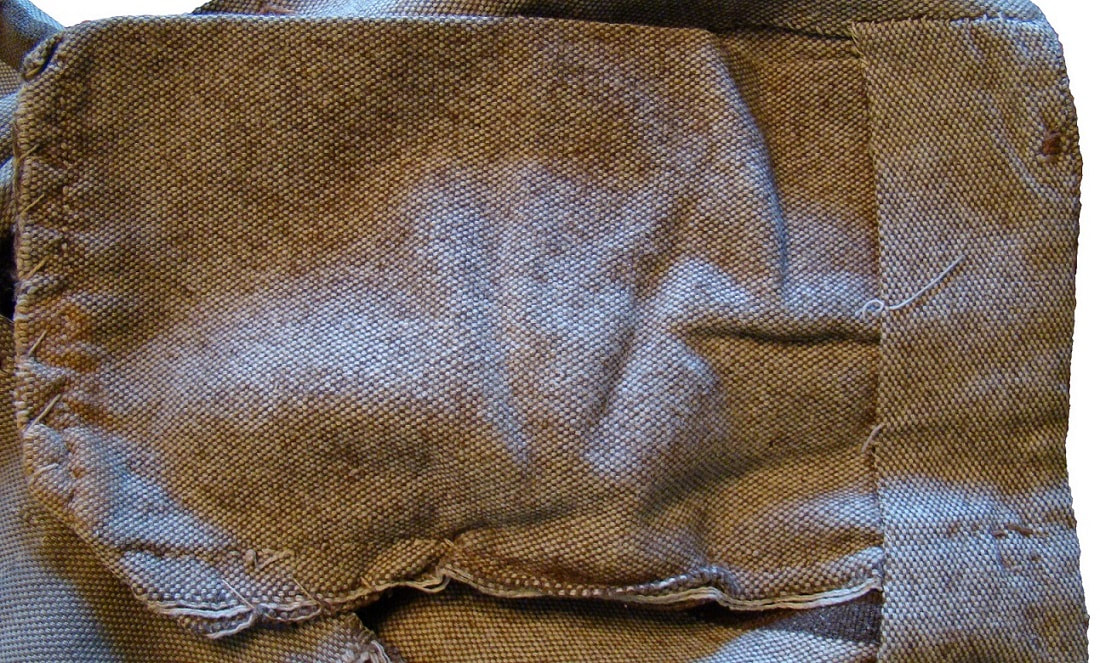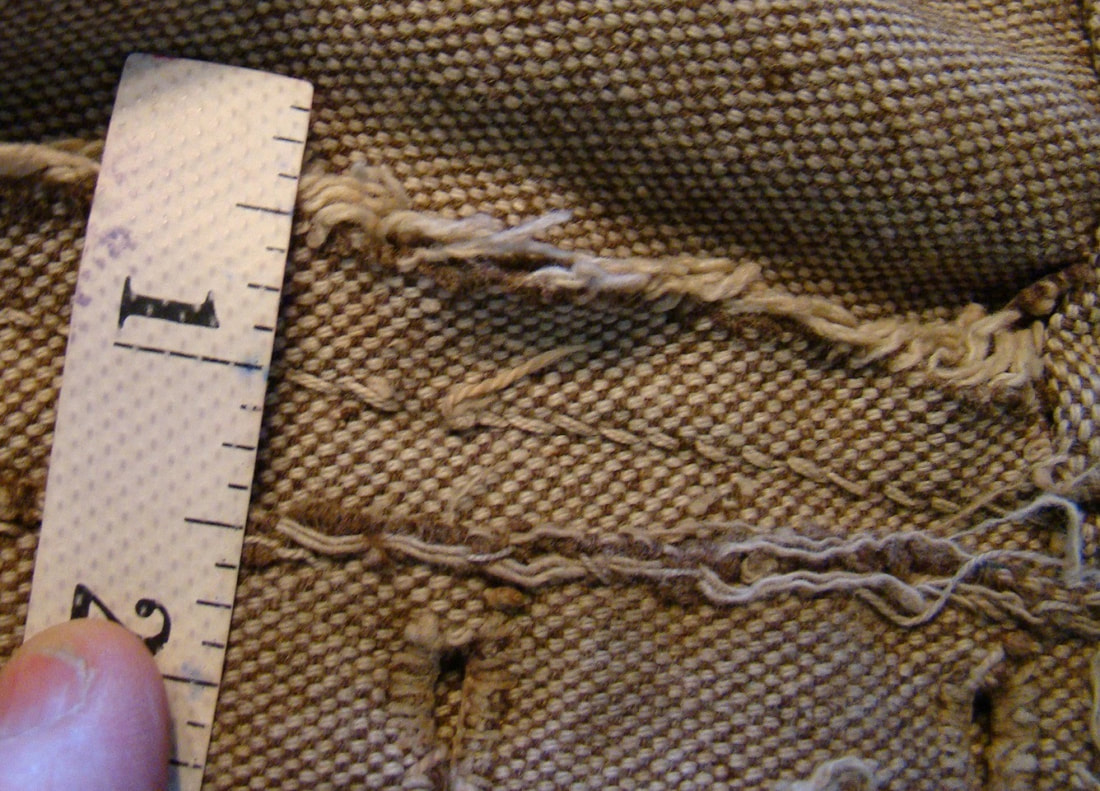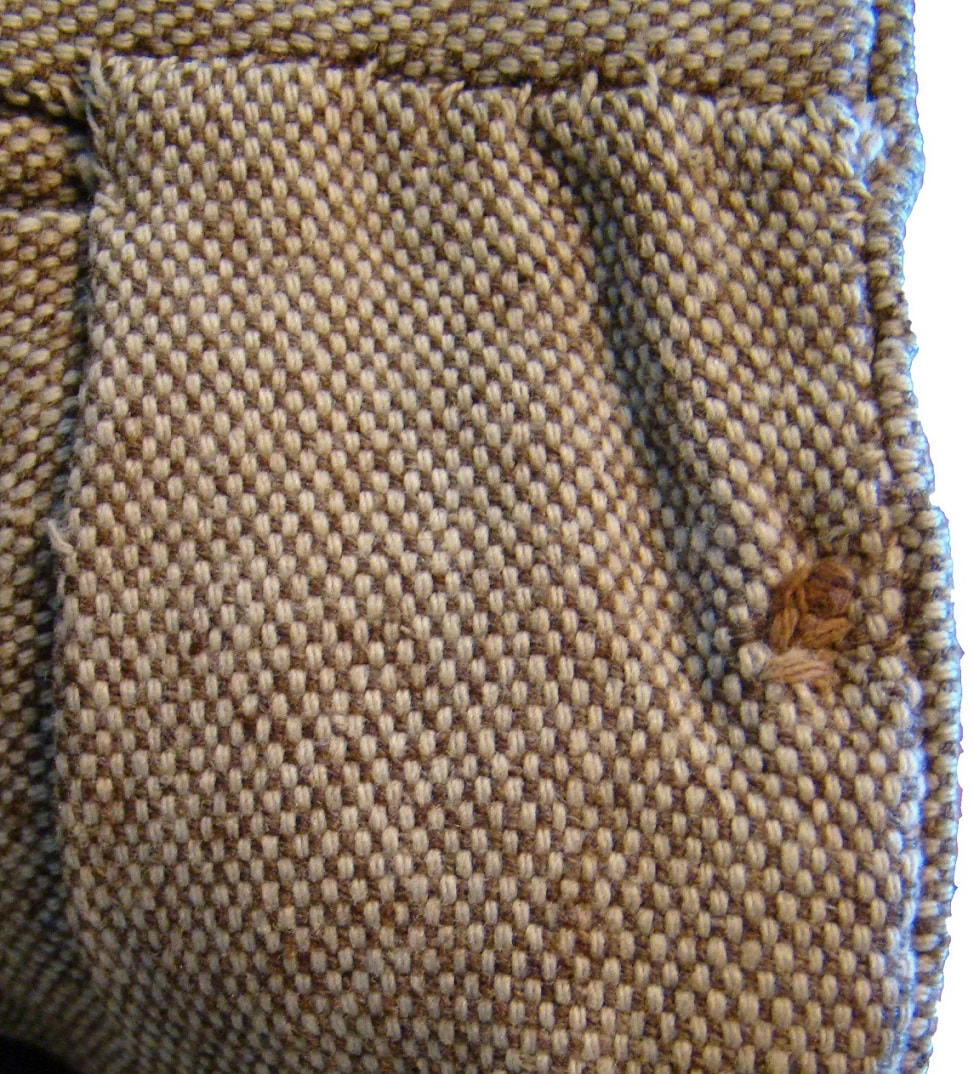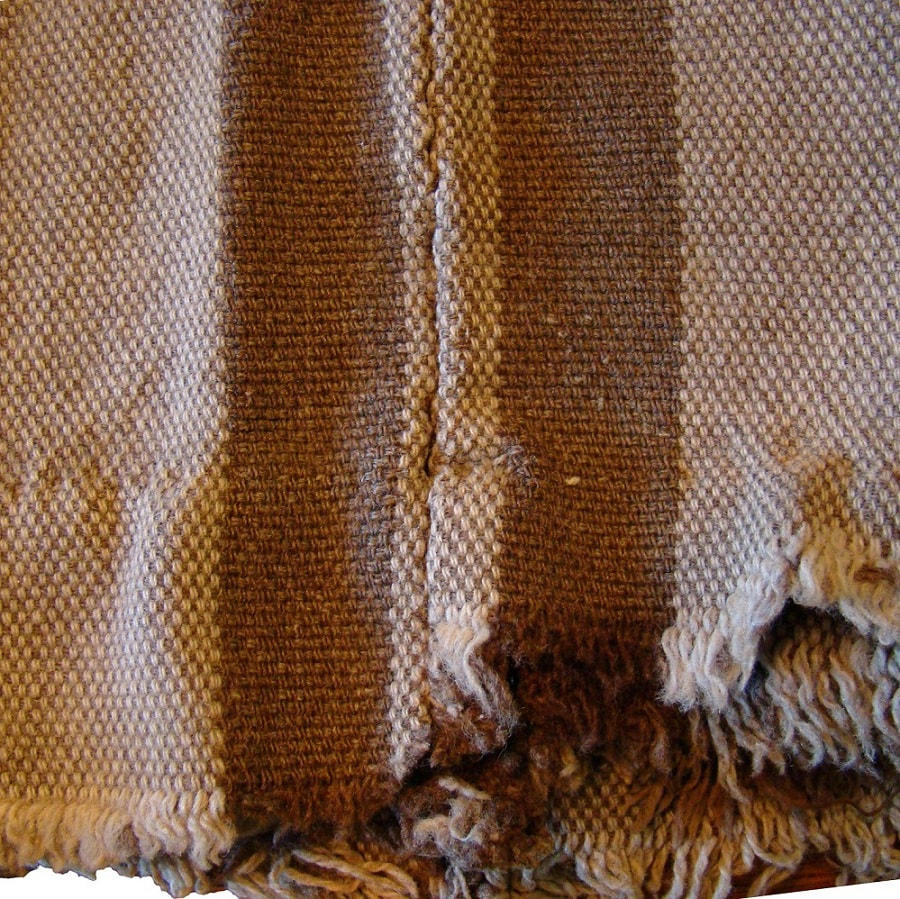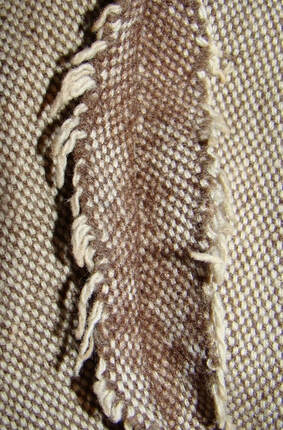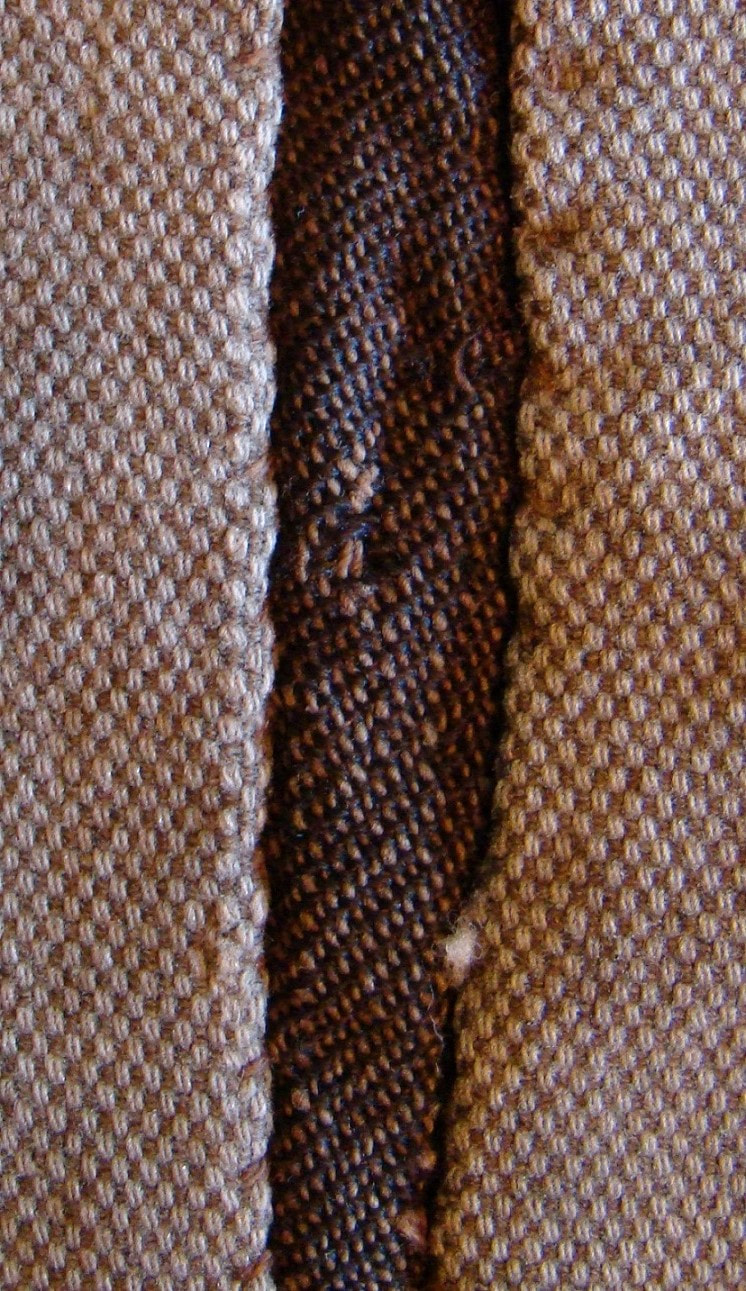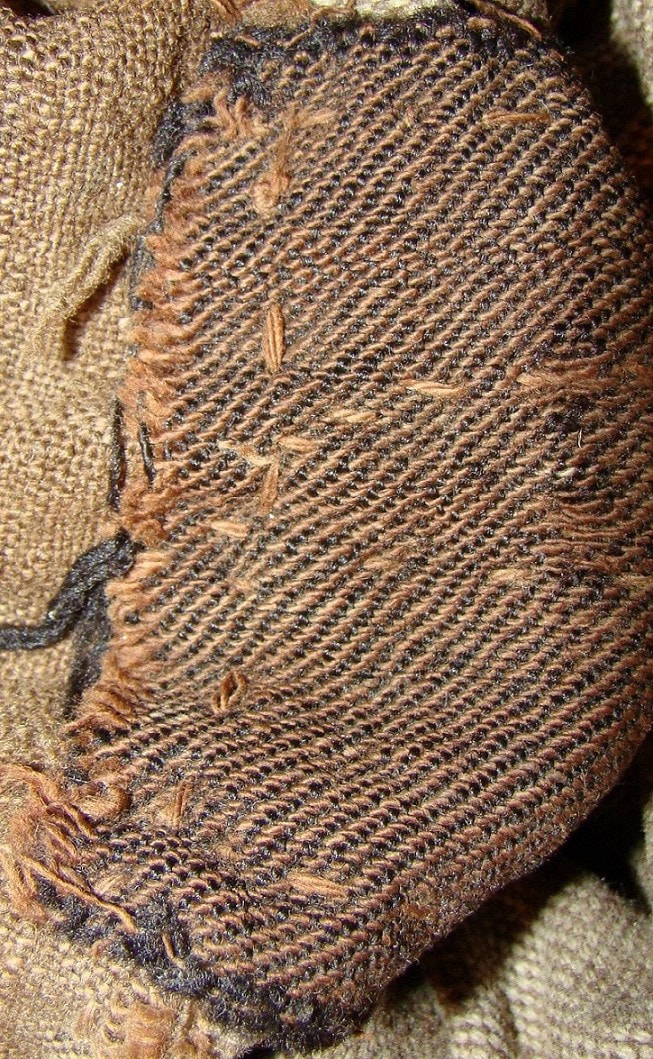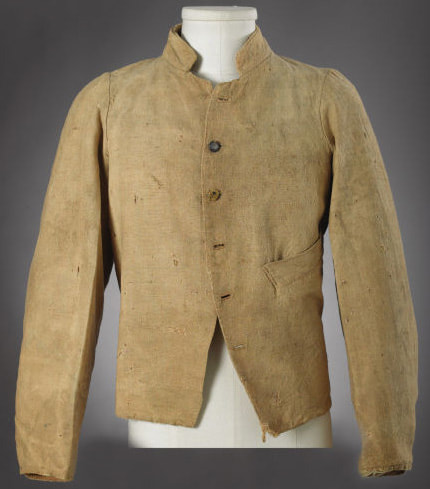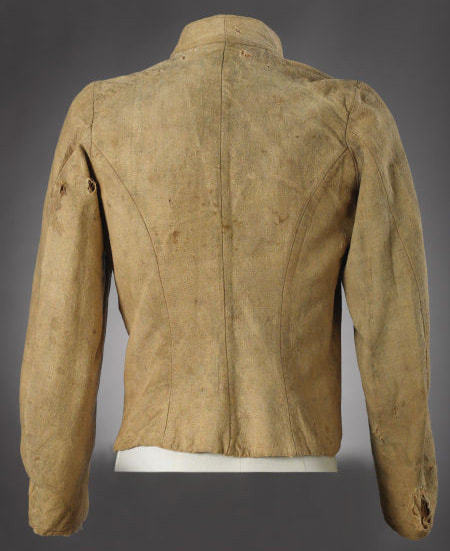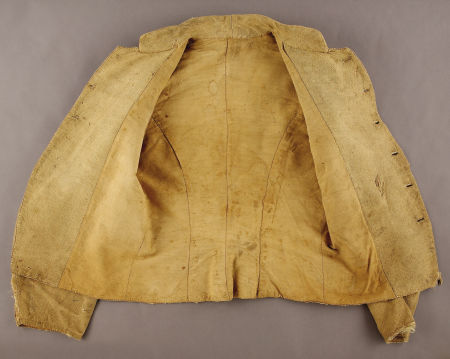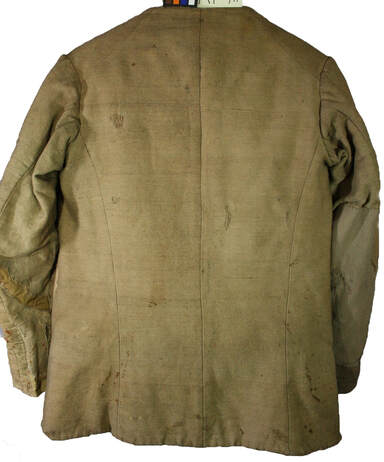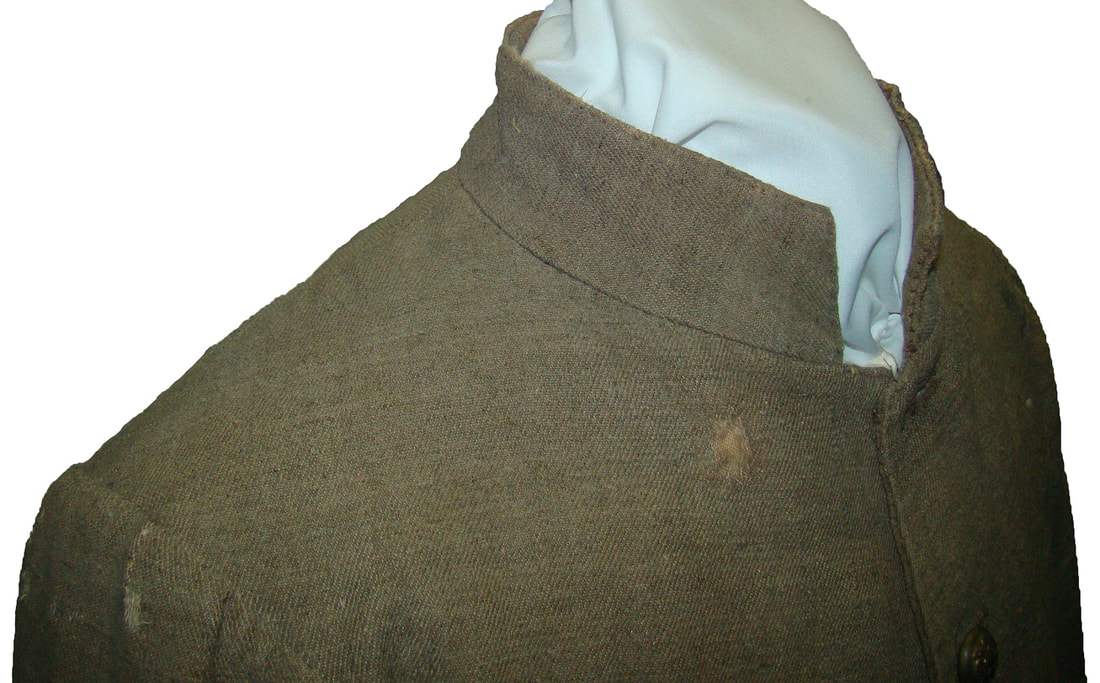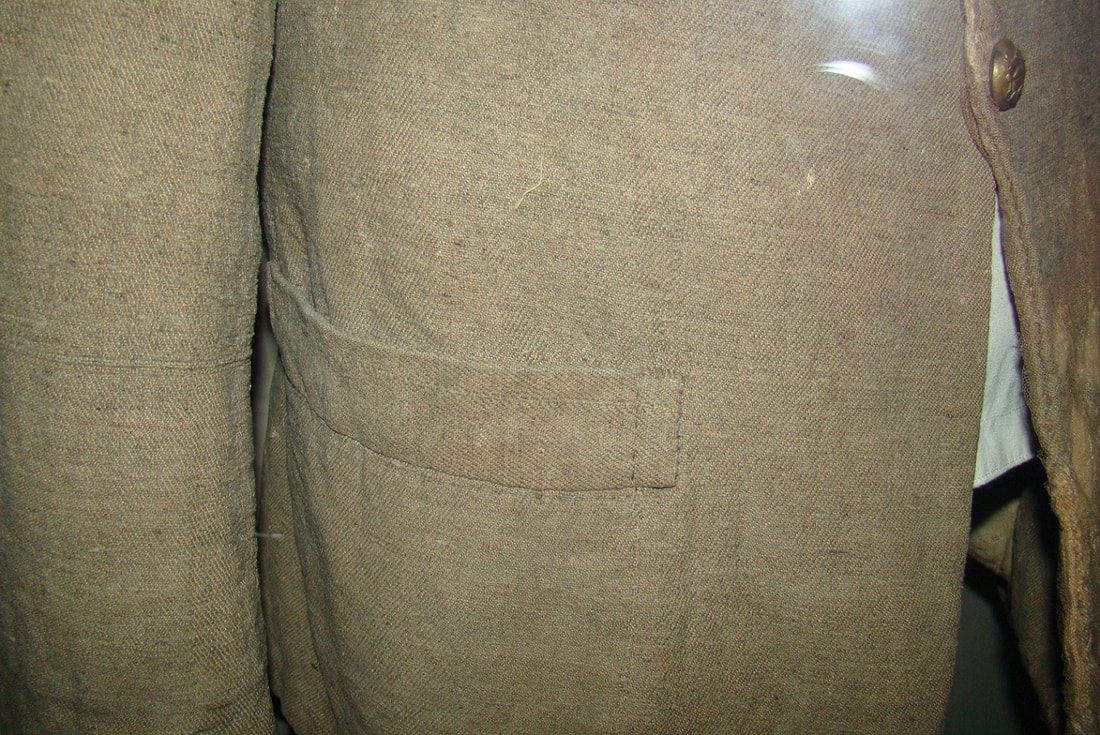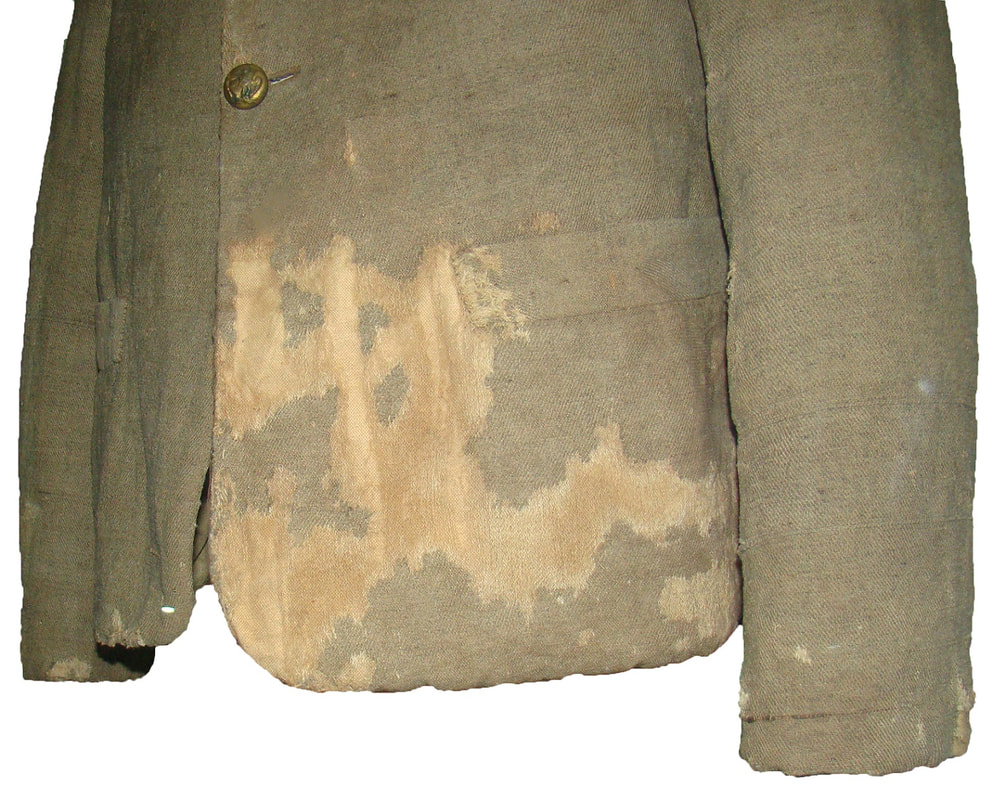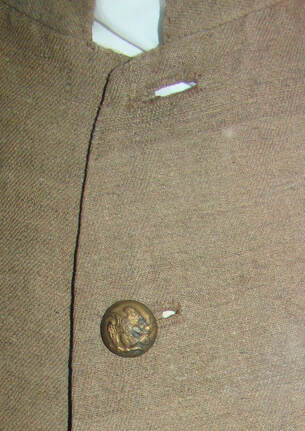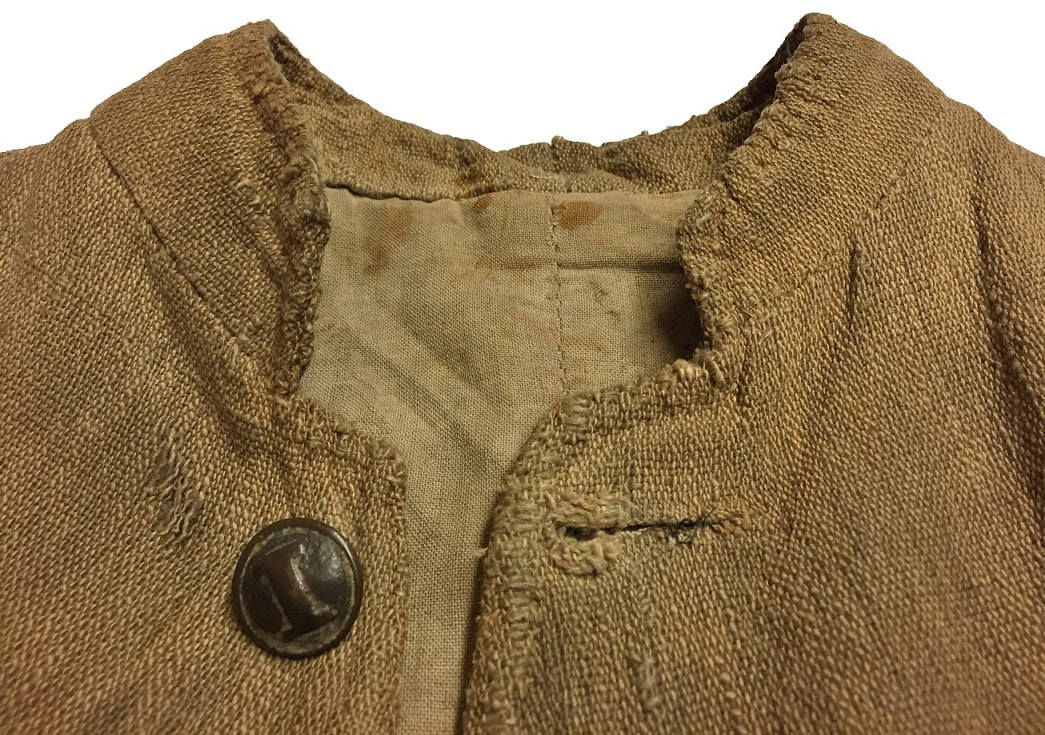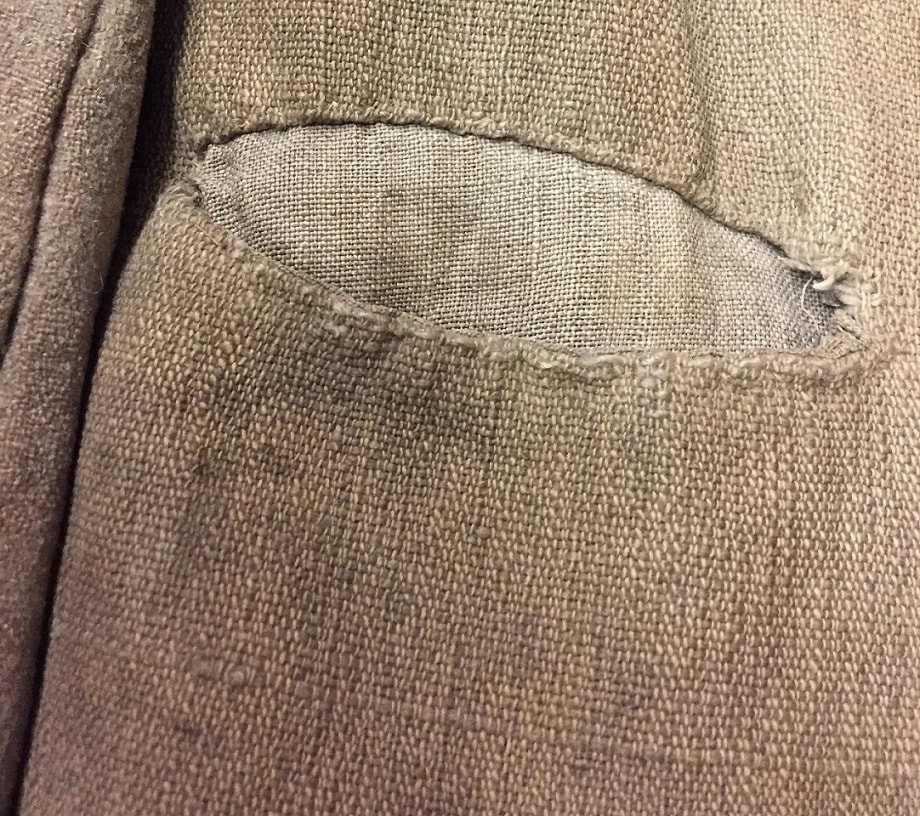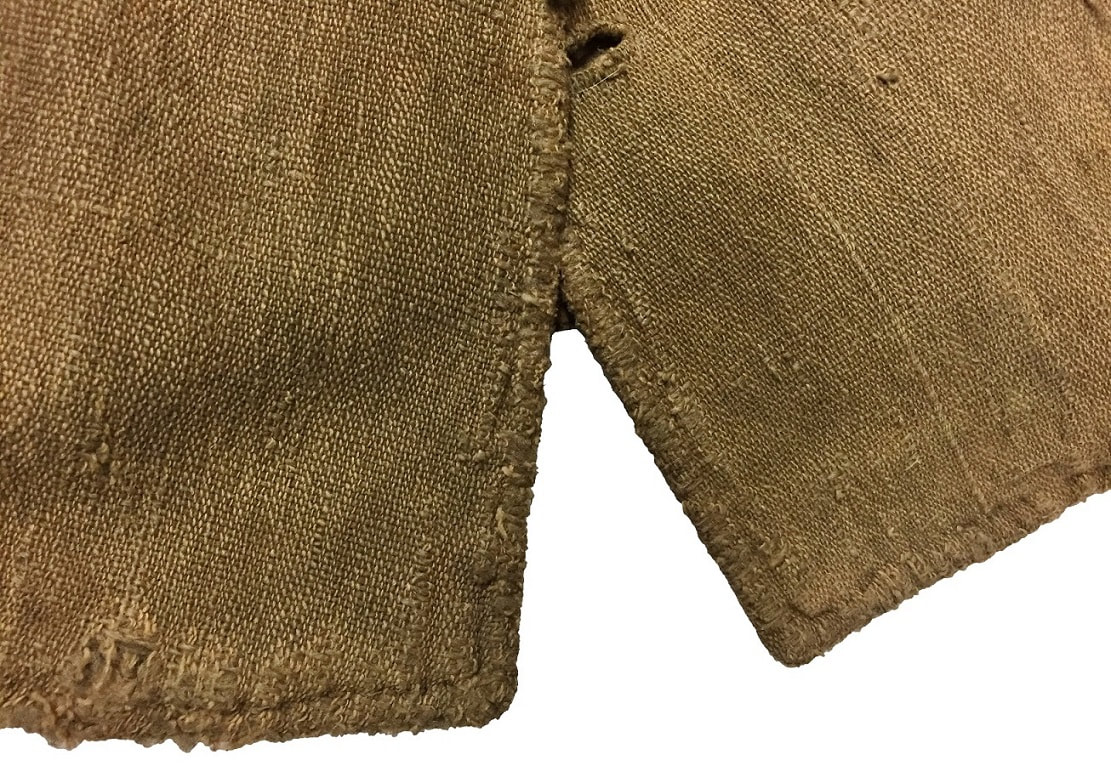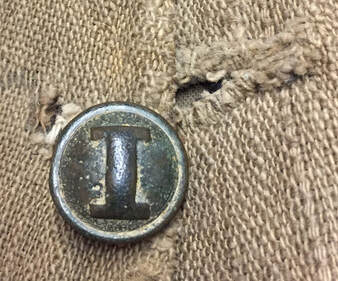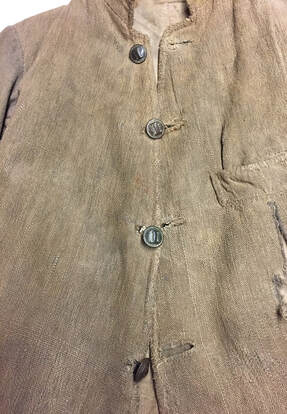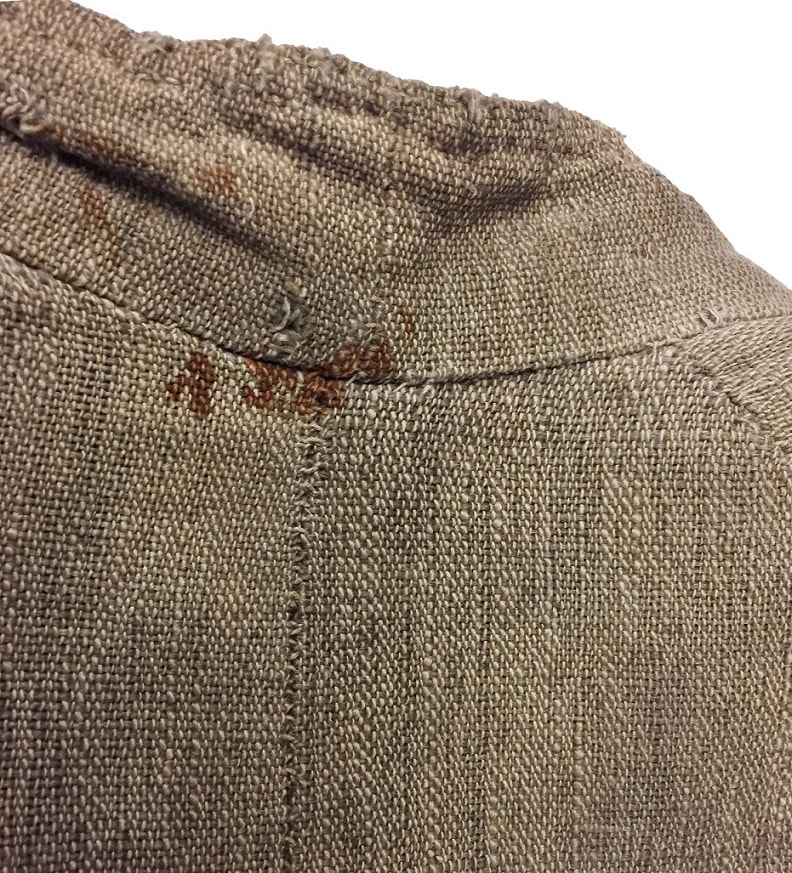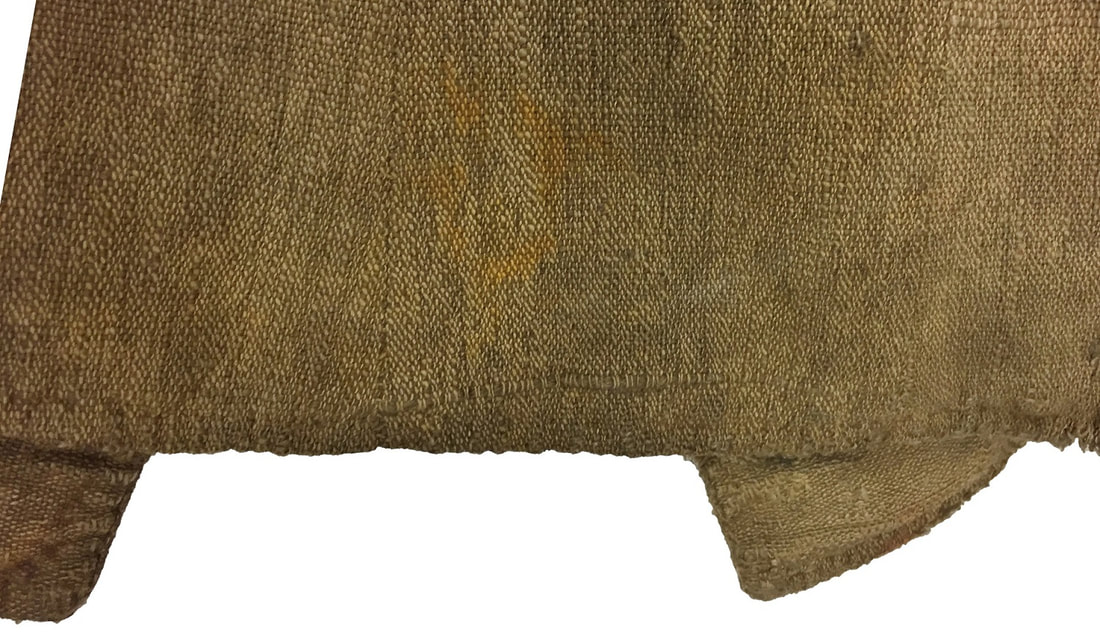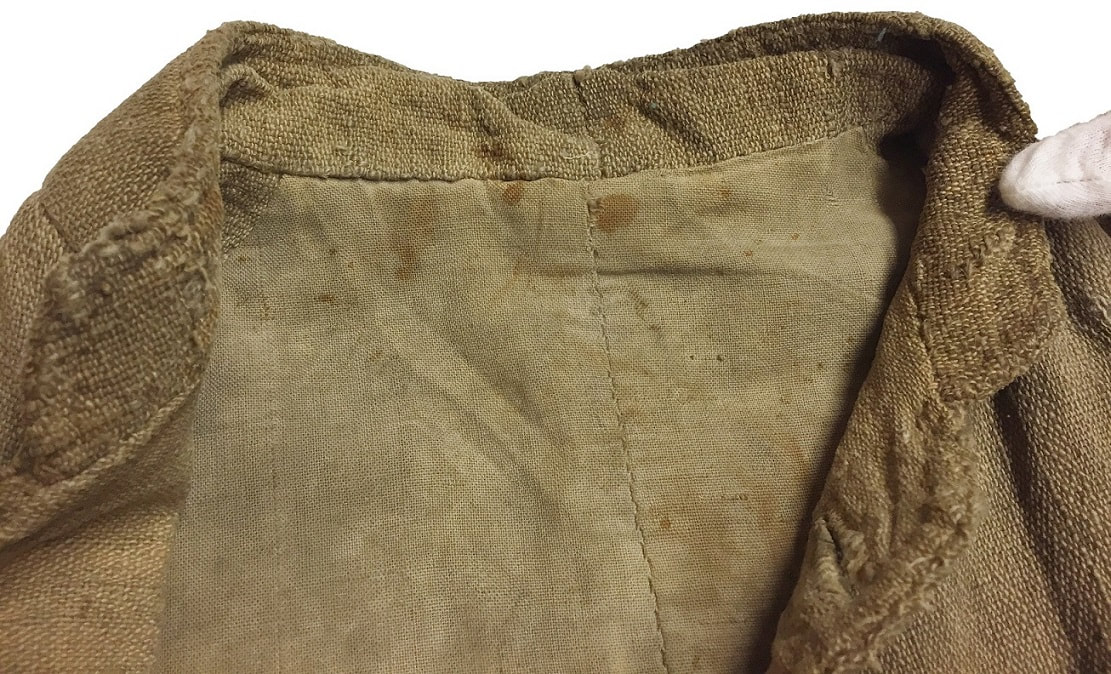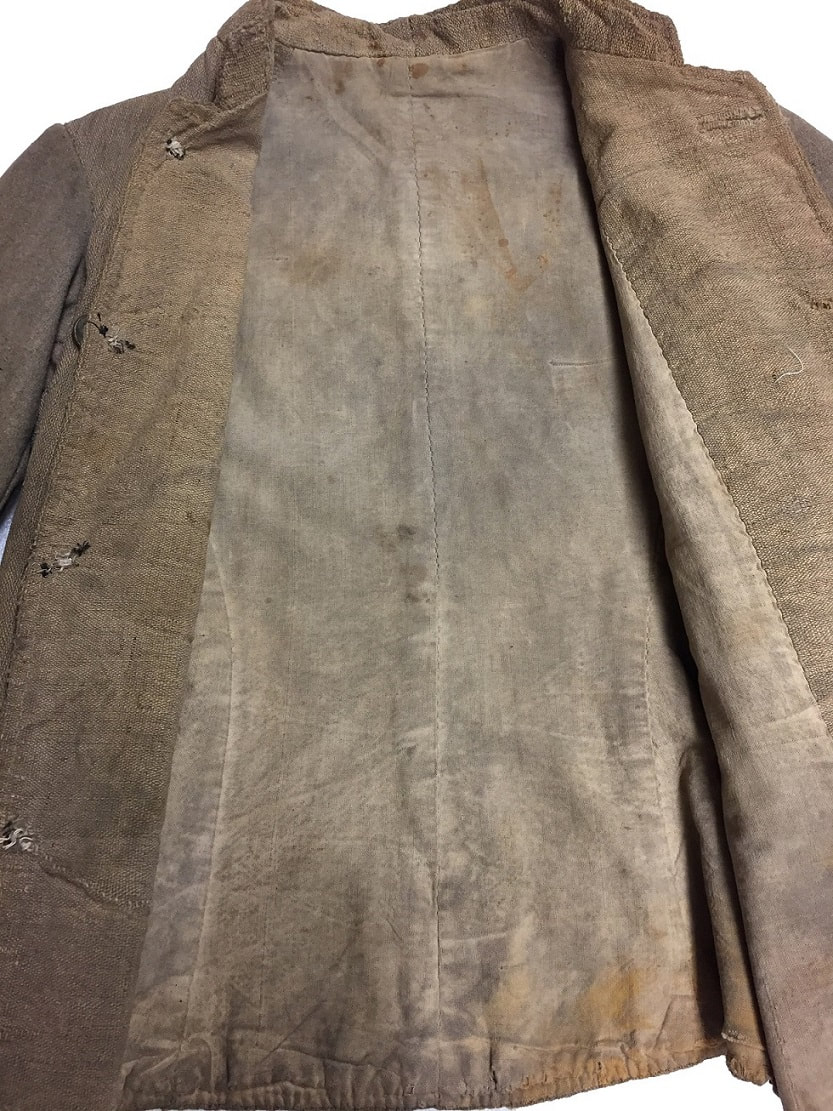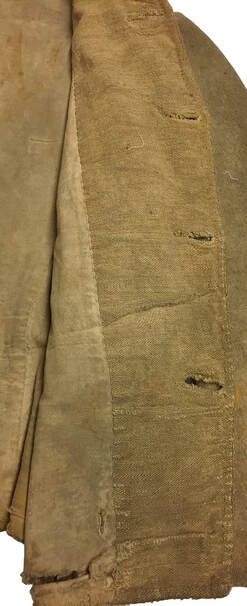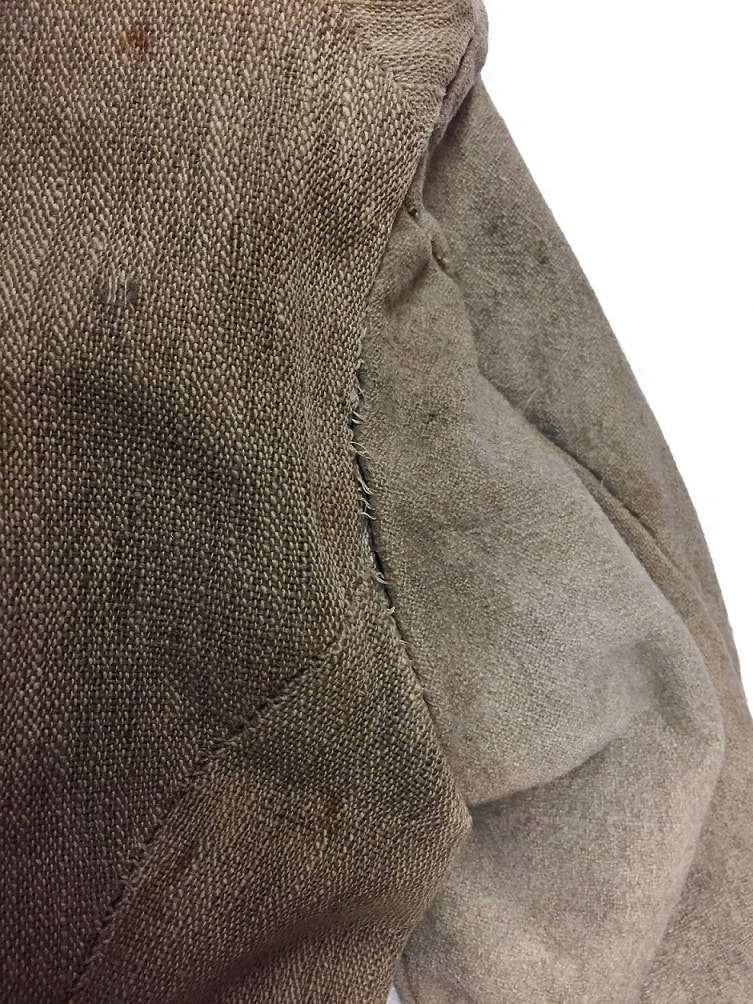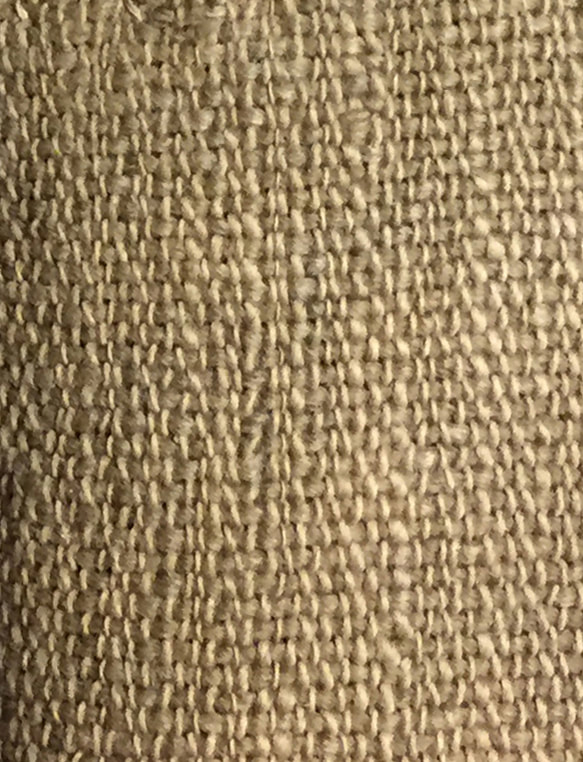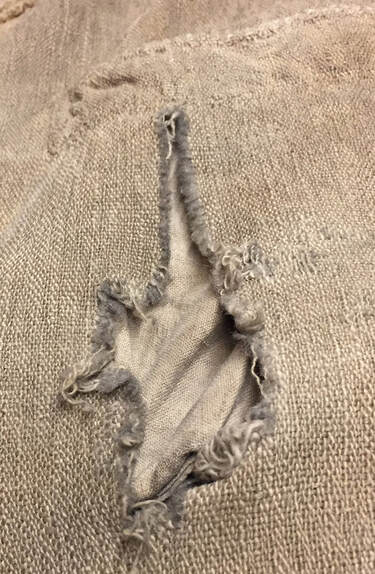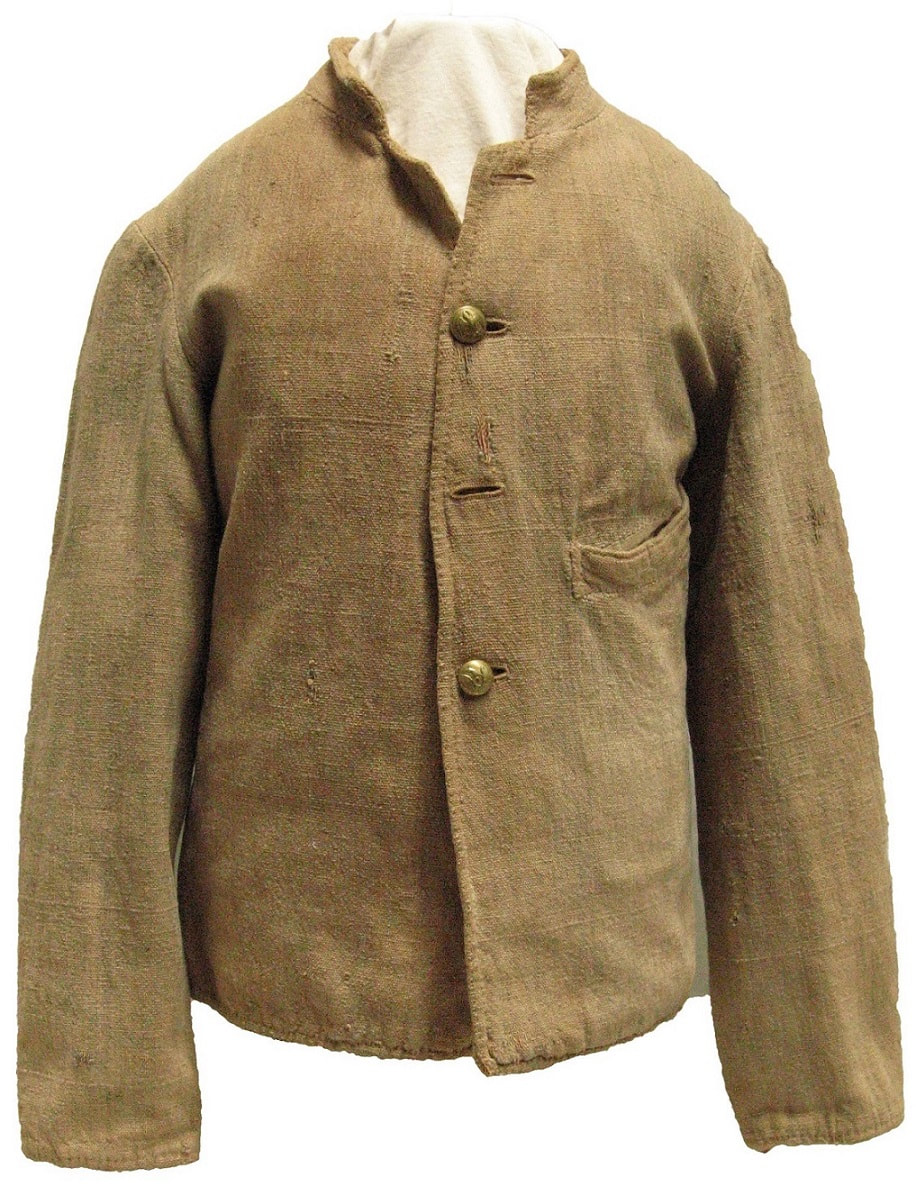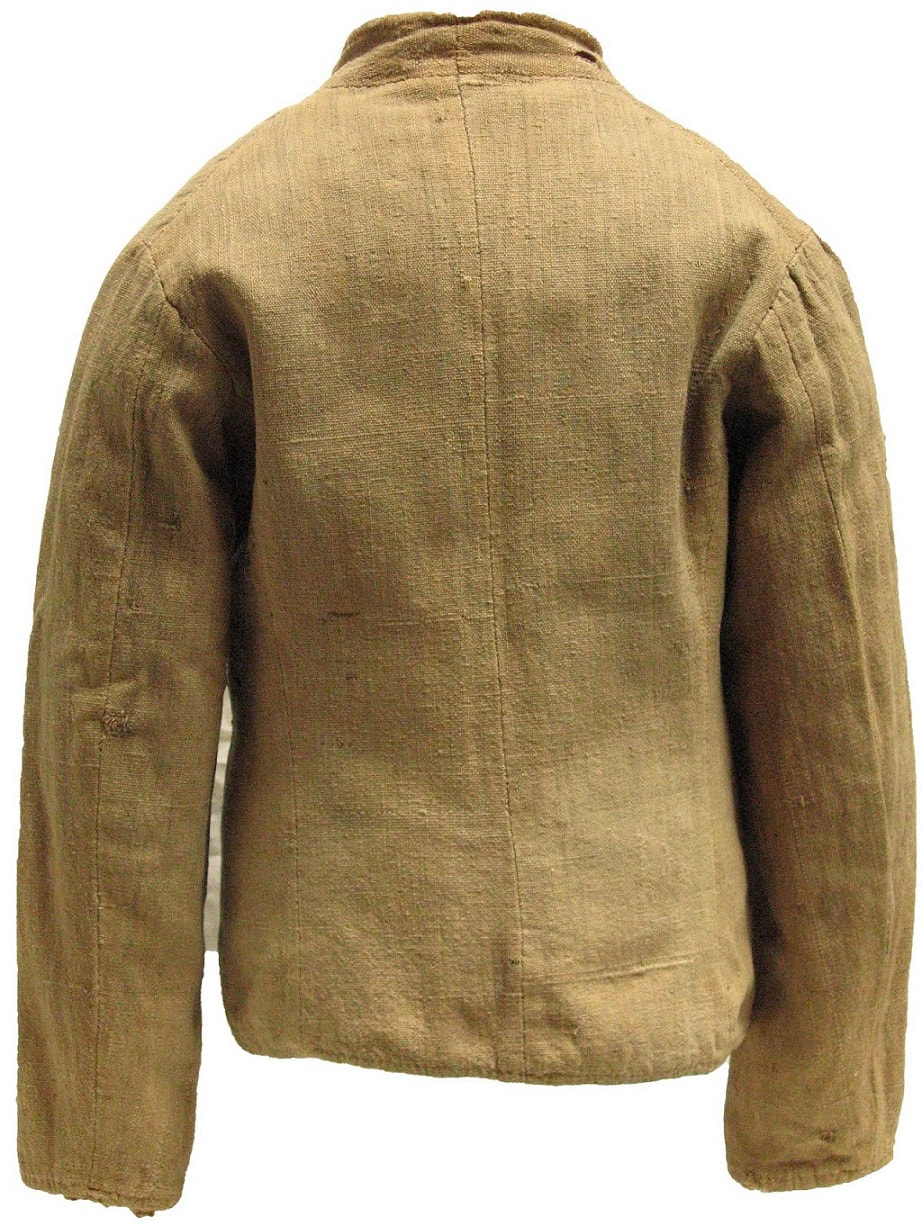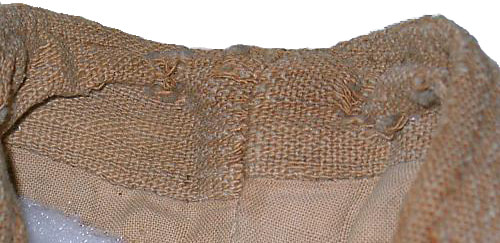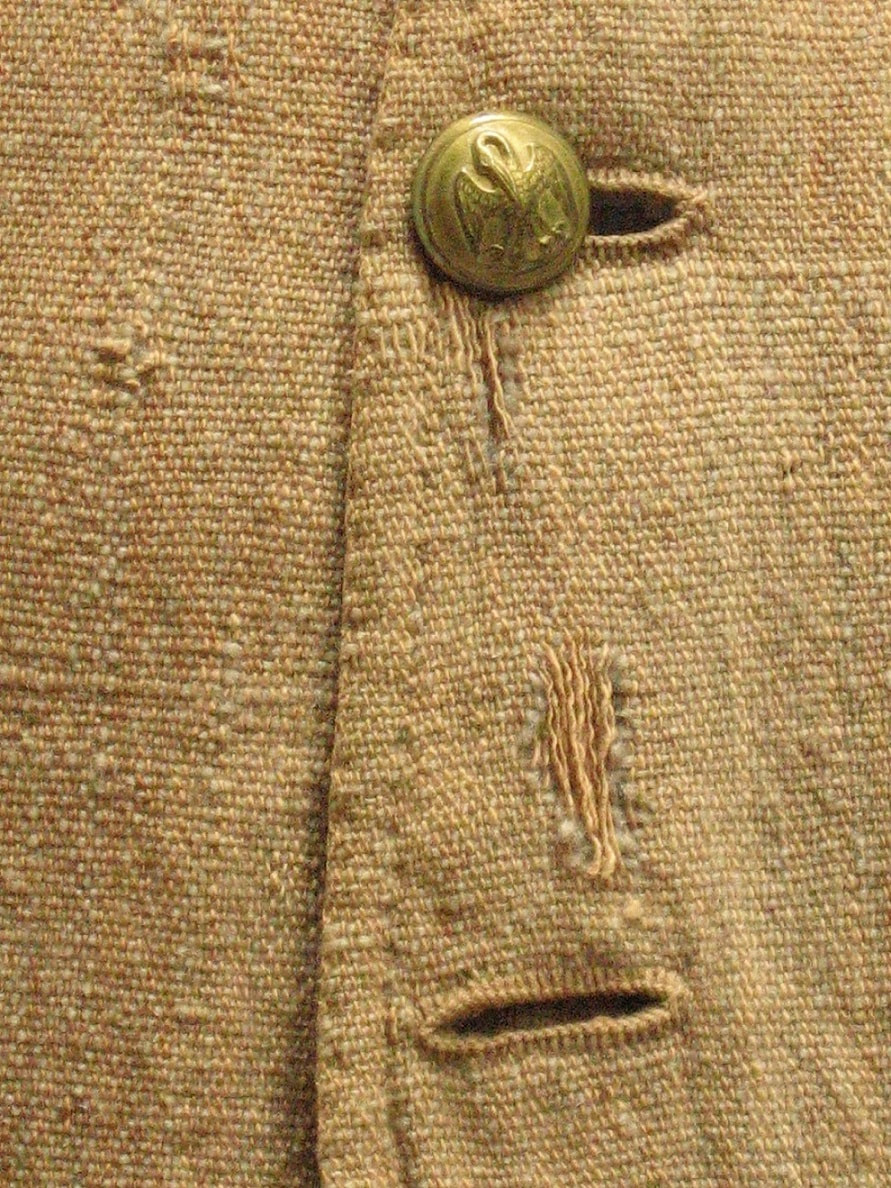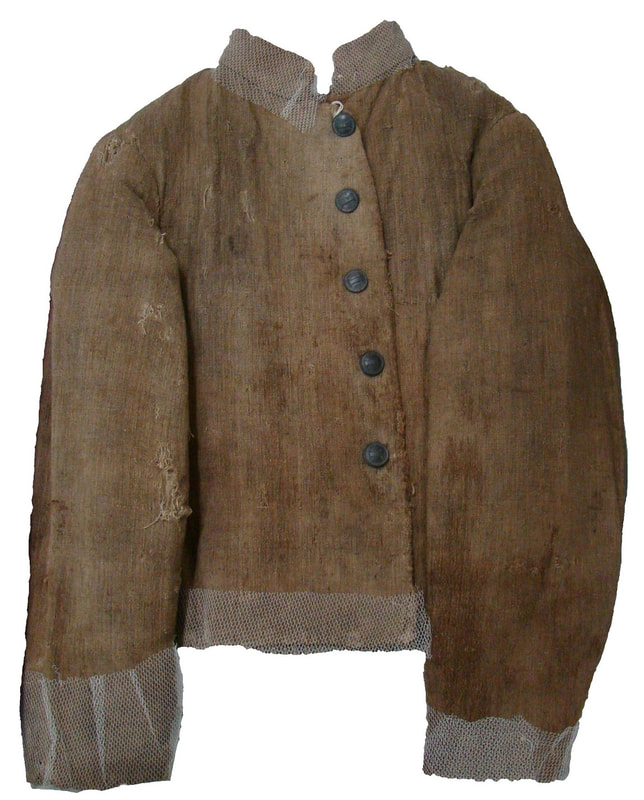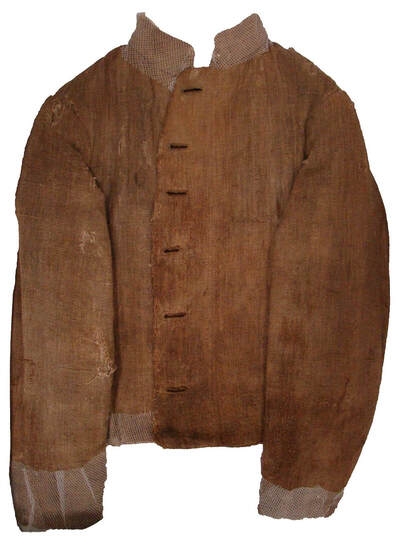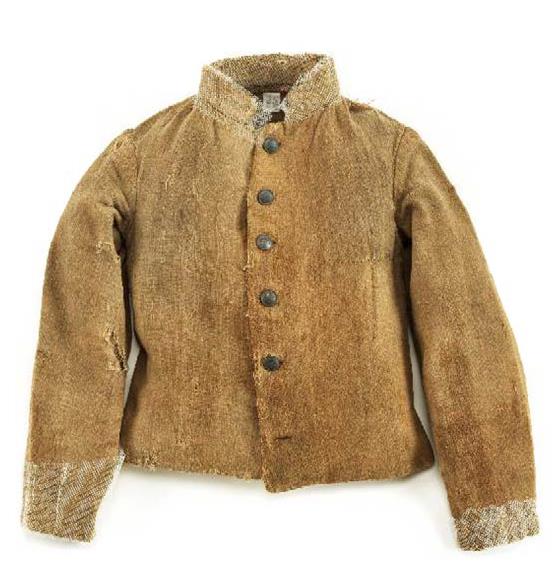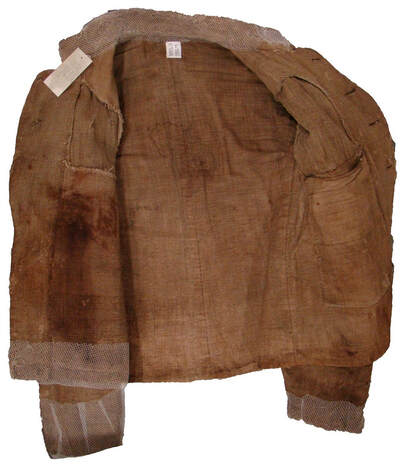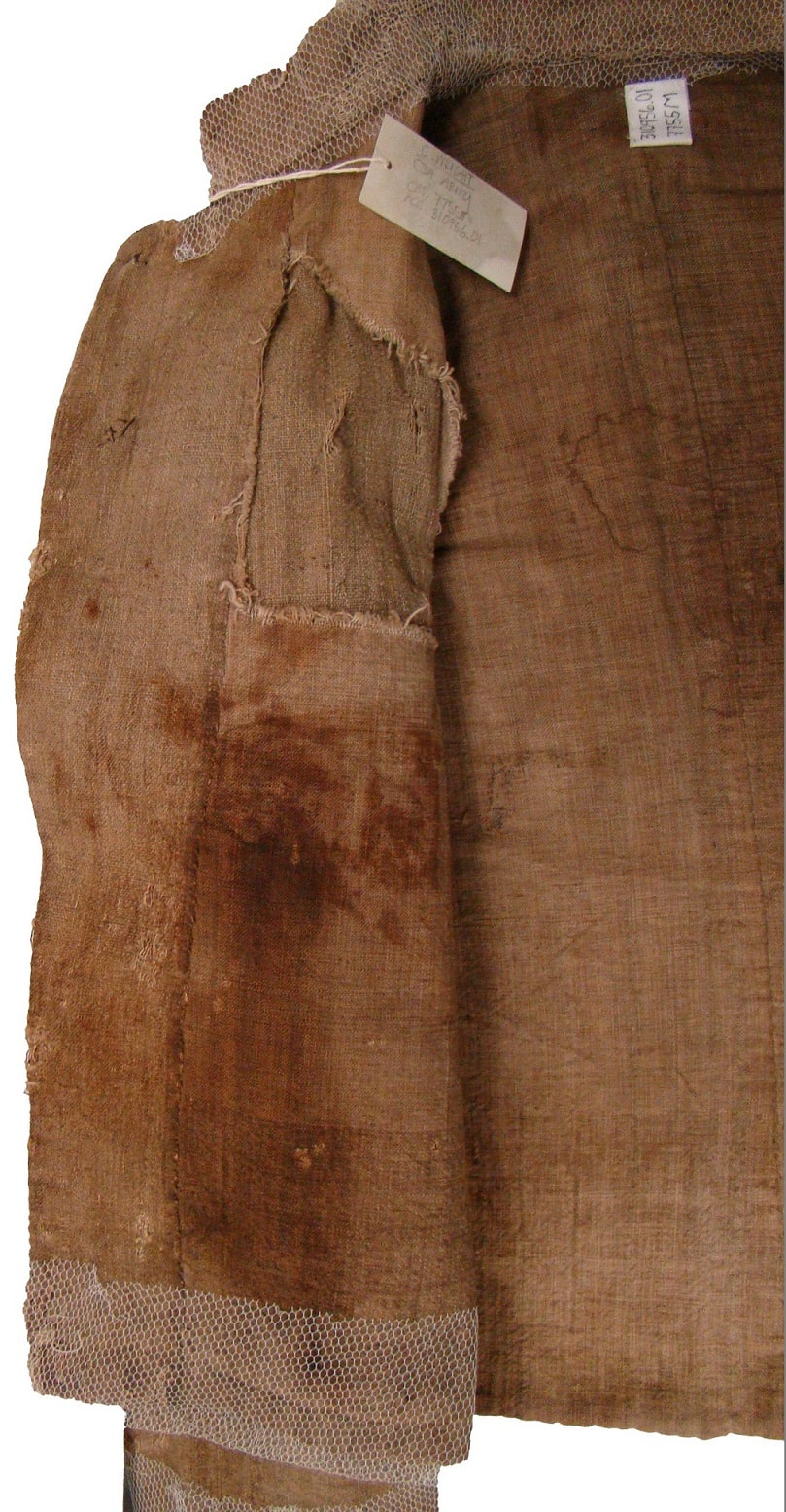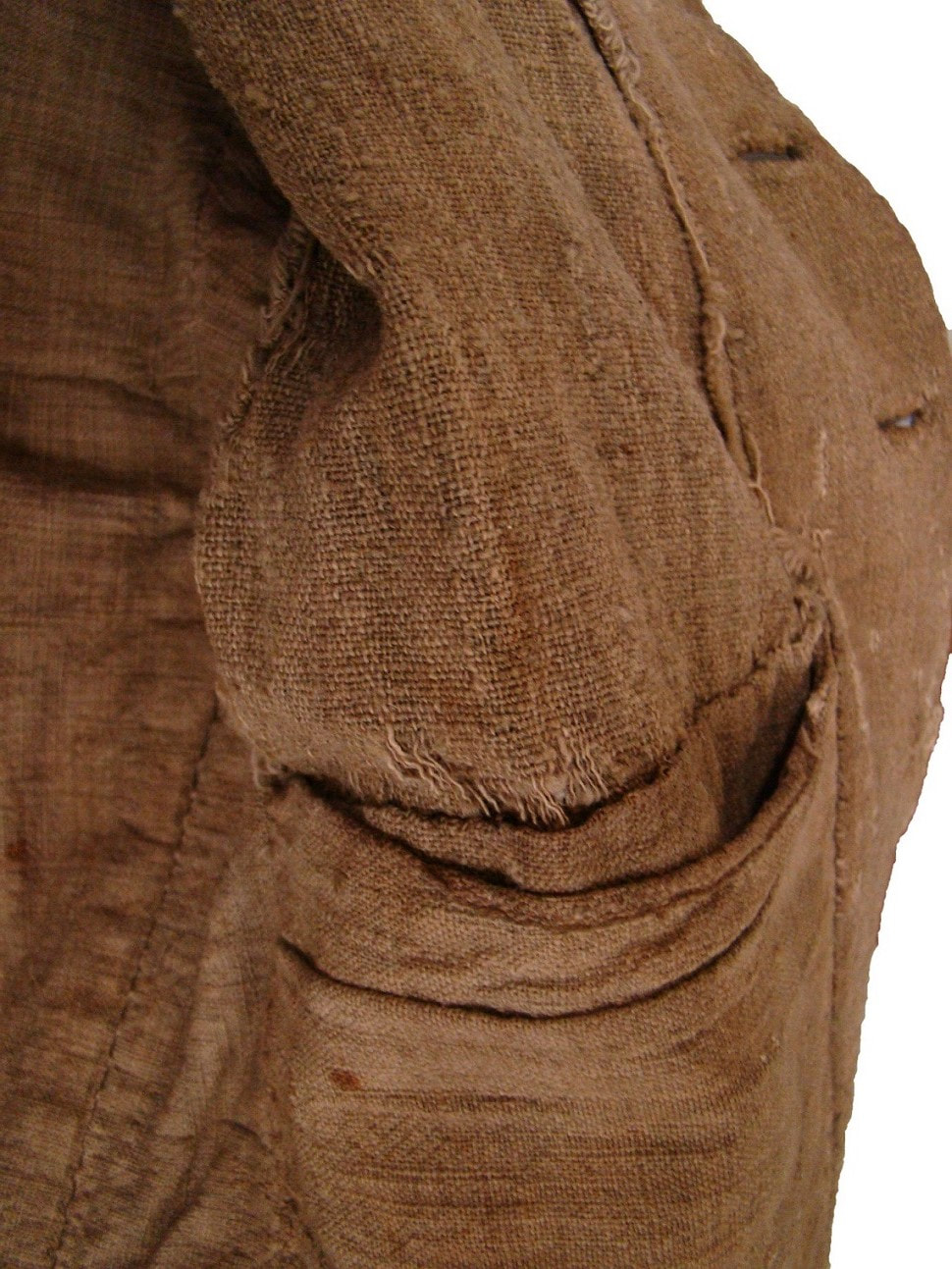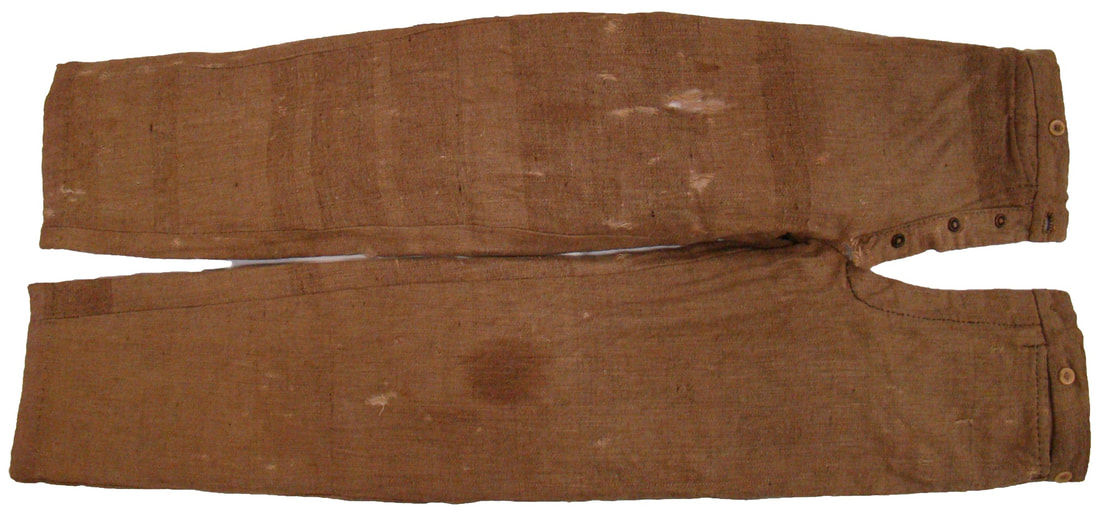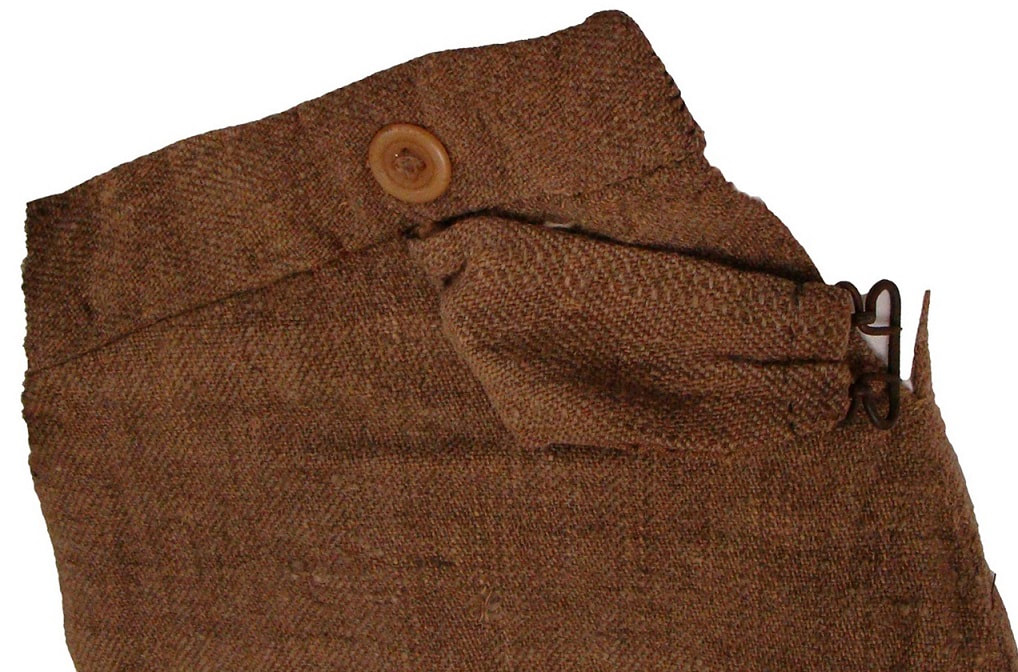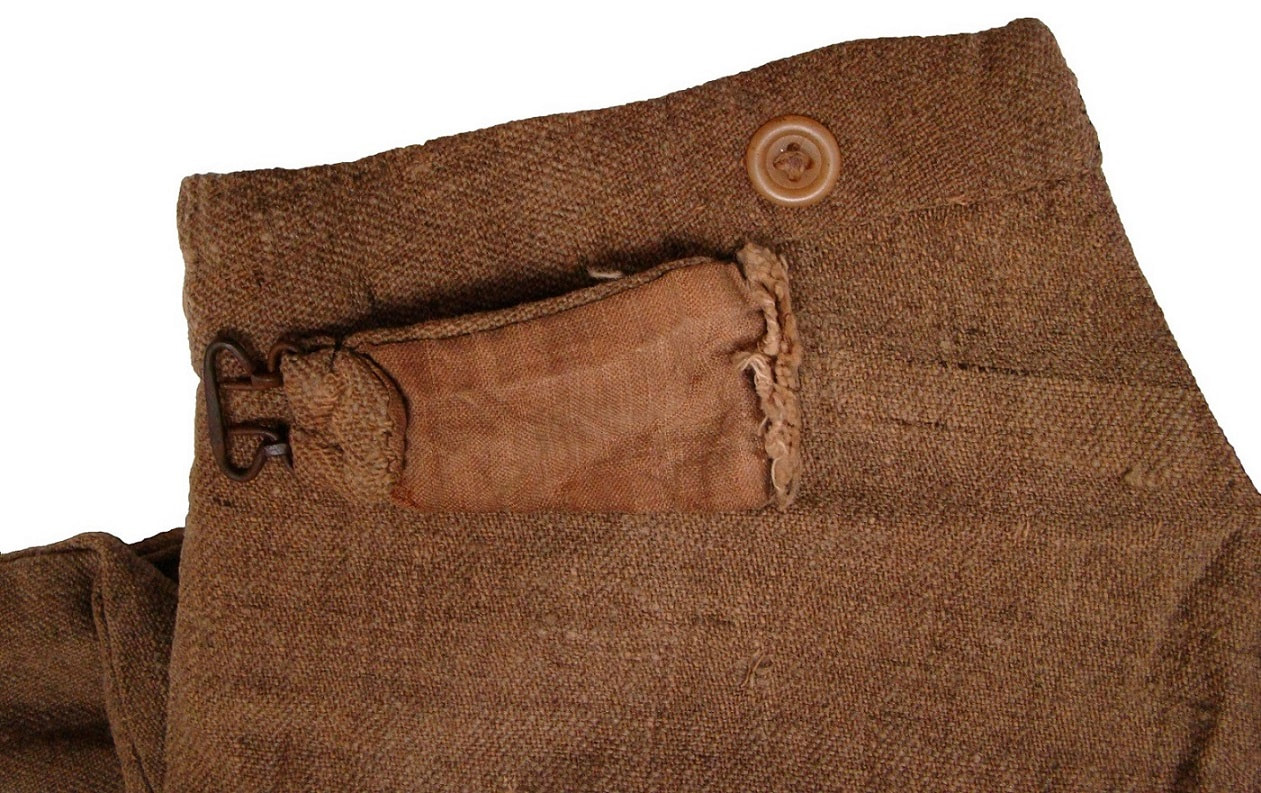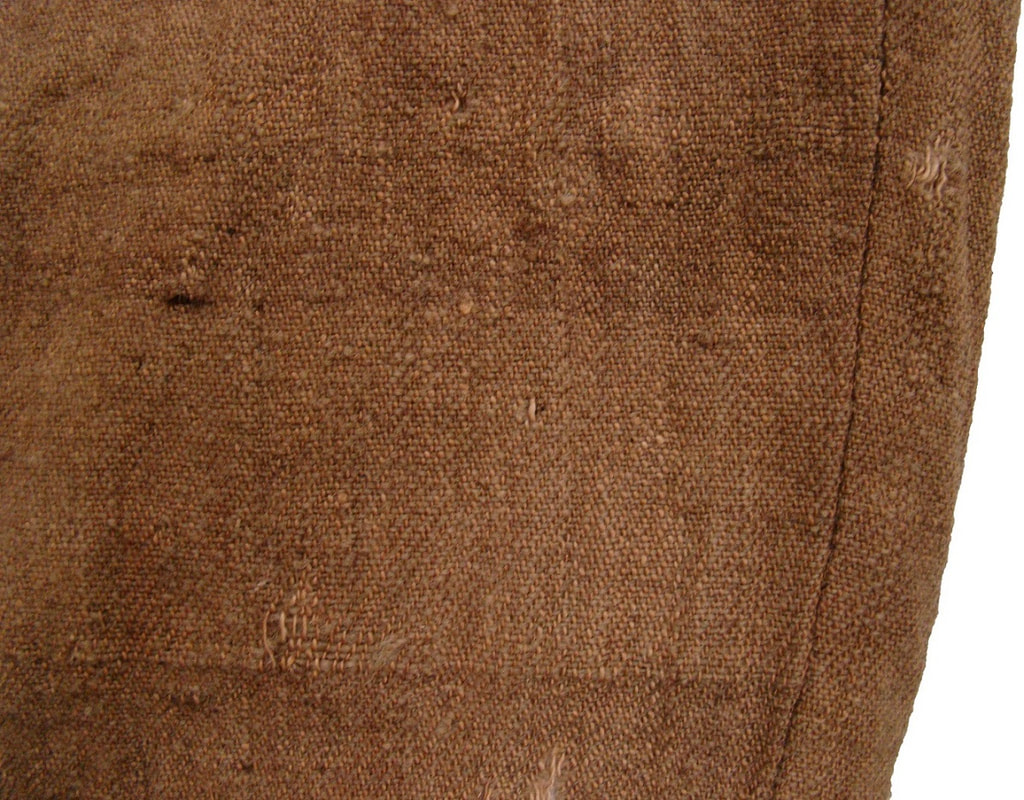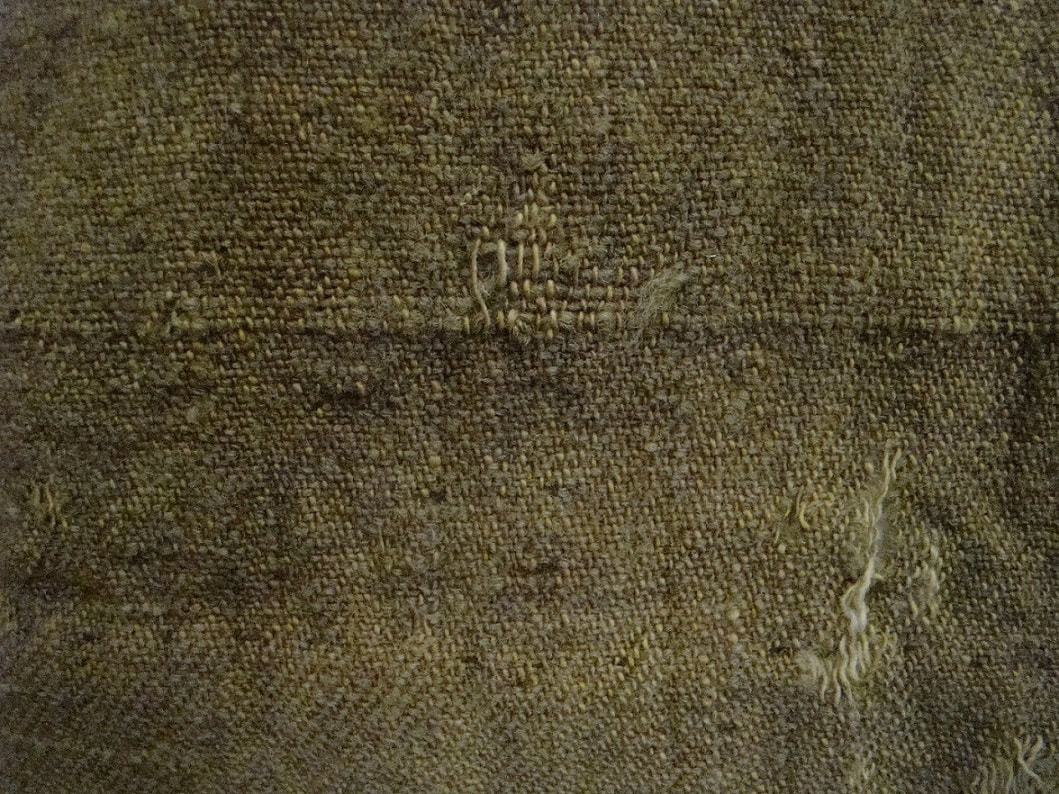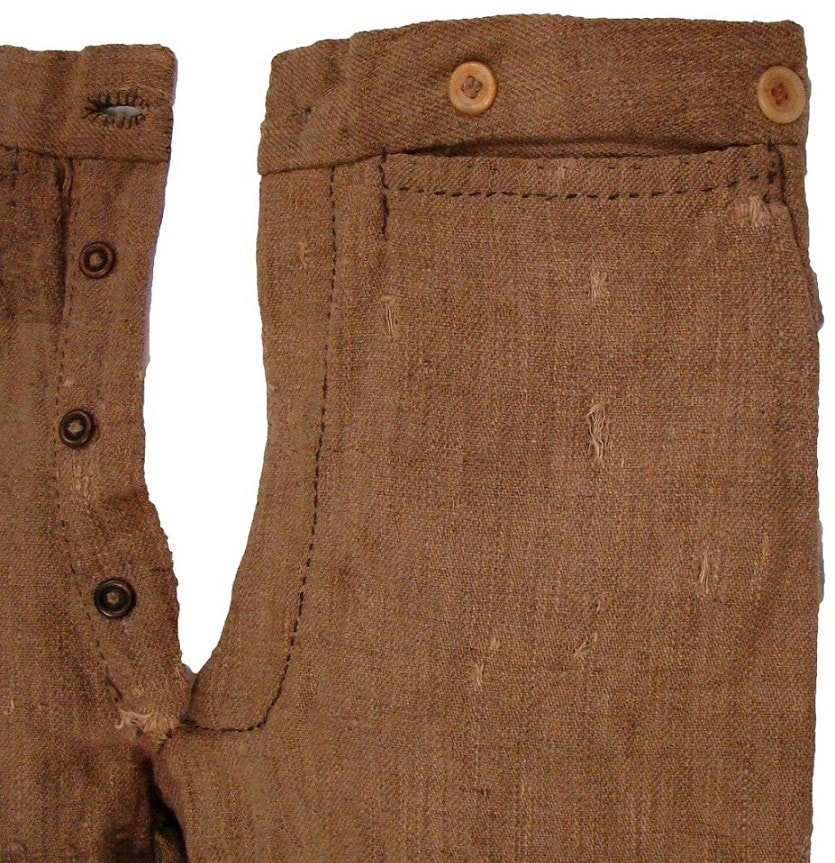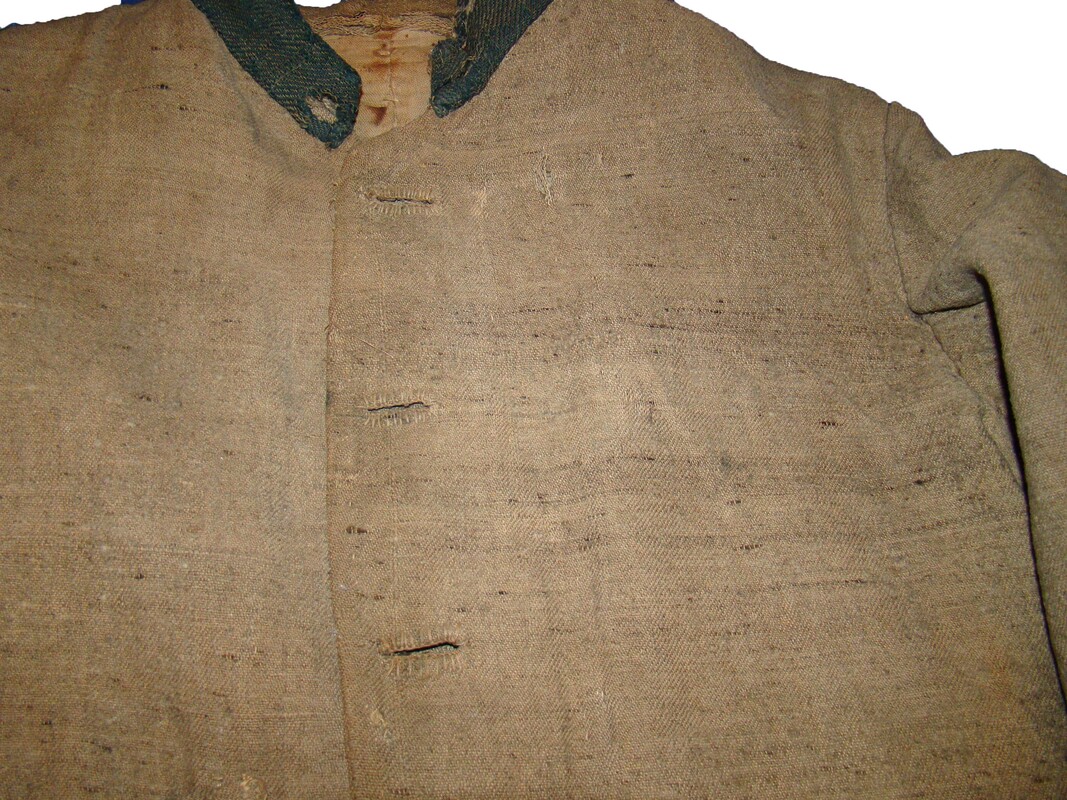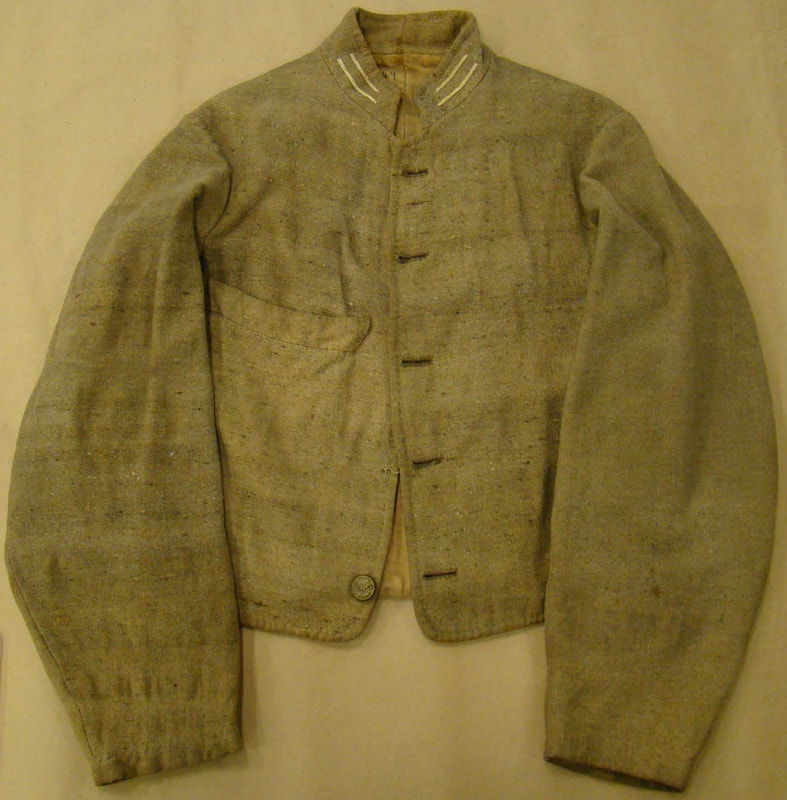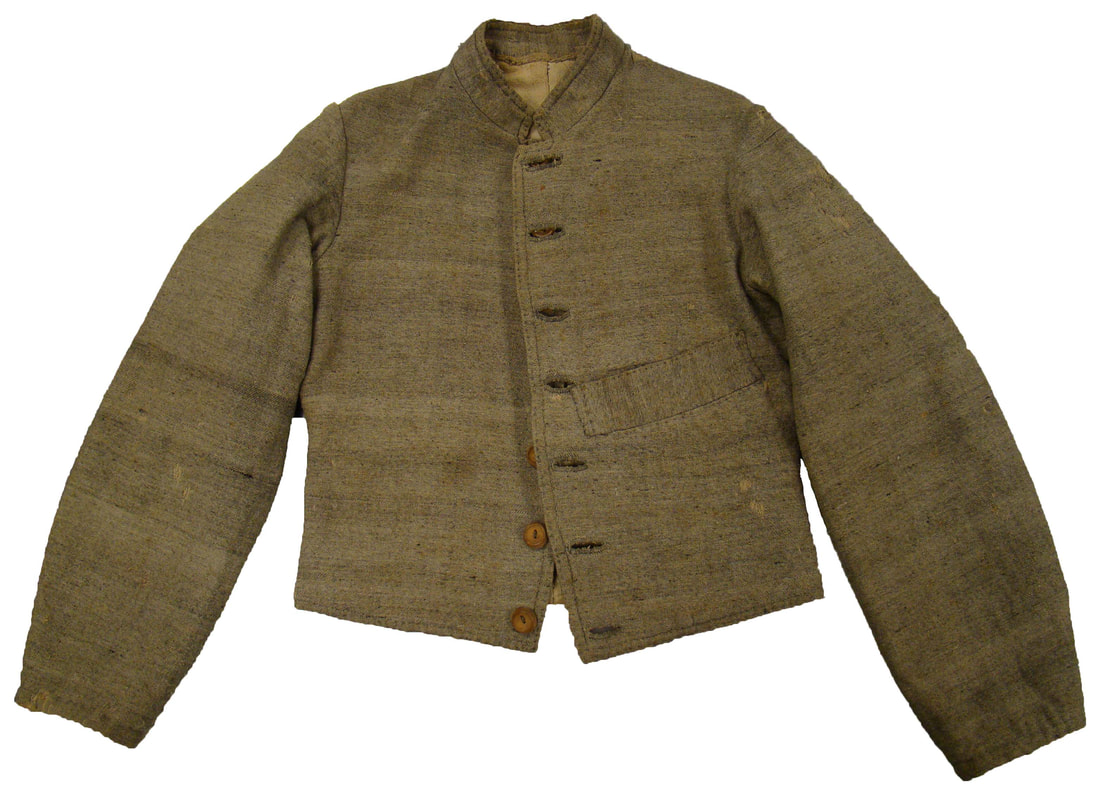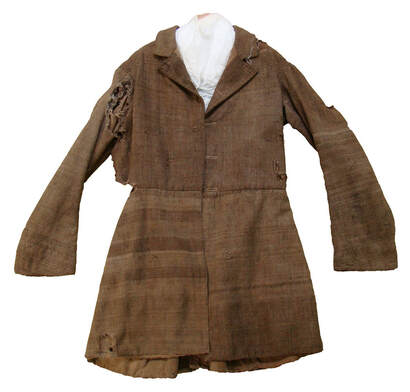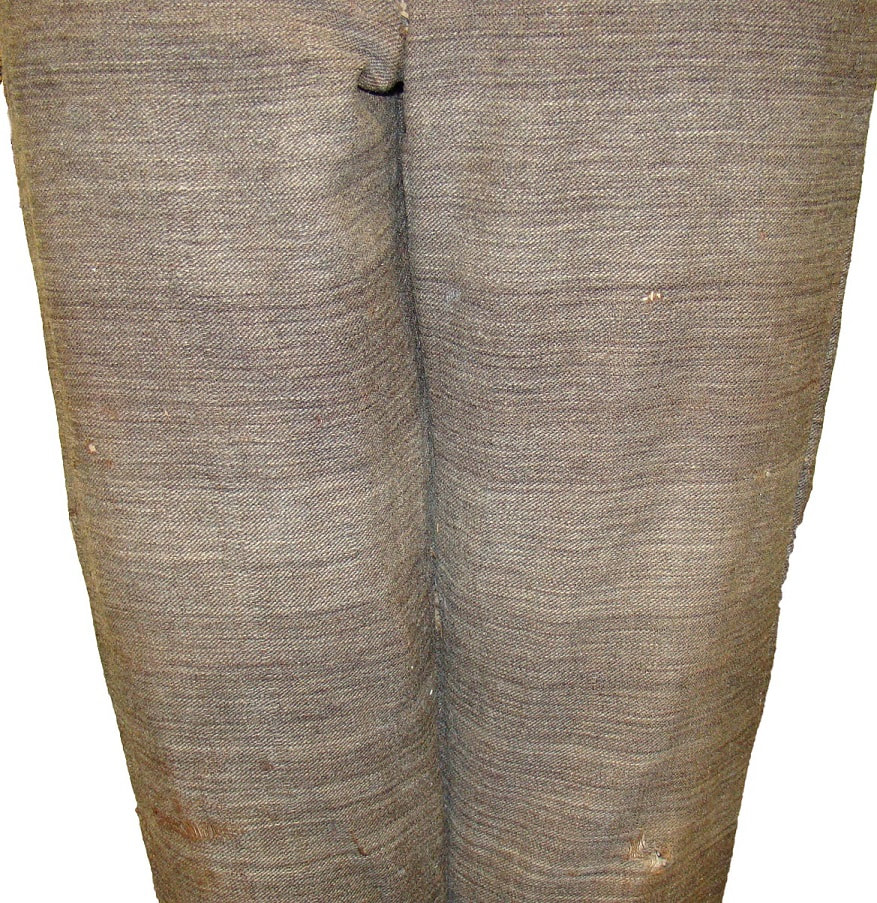Confederate Uniforms of the Lower South, Part I: Tennessee, East Louisiana, Mississippi and Alabama
by Fred Adolphus, June 29, 2019
The Lower South, roughly speaking, was the region that comprised South Carolina, Georgia, Alabama, Mississippi, Florida and Louisiana. This study will describe how the region clothed Confederate troops and the uniforms that it issued to them. The story begins with how Southern authorities organized the region’s resources to accomplish this task.
Soon after the war began, the thoughtful leadership of the South realized that the government needed to supply its armies with clothing. The individual soldiers, their families, and even philanthropic organizations could not do this alone. None had the resources equal to this task except for the government. Two systems were adopted to cope with this need: a government depot system and a system of reimbursement, called commutation. Both systems functioned alongside each other, but the reimbursement system that required either individuals or organizations to supply soldier’s clothing proved ineffective. The Confederate congress abolished the commutation system on October 8, 1862; thereby, making the Confederate quartermaster department solely responsible for clothing Confederate troops. By that time, the quartermaster depots were fully operational, so this posed no problem. In fact, the commutation system was wrought with inefficiency and fostered unhealthy speculation for scarce resources: resources that needed to be managed and properly distributed.[1] It also wasted intangible resources such as time and energy on a procurement process where government agents were routinely underbid. Finally, the clothing industry that grew out of this system victimized workers with low wages in rapidly inflating currency. This exploitation hampered both morale and support for the war effort. Had the war lasted but a year or two, the commutation system might have been the lesser evil to establishing an expensive government production apparatus. In any case, within a few months the war’s outbreak, Southern leadership began contracting for clothing to adequately supply its armies with clothing, especially for the impending winter months.
Early efforts to provide clothing drew on the resources of the Confederate quartermaster, state governments, small factories and volunteer aid societies. Special attention was given to fostering the establishment of manufacturing facilities, and the Western Confederacy had had several operations that provided a good start in this regard. Indeed, there was already a burgeoning textile industry there by the start of the war. This consisted of numerous small, privately-owned factories or mills in Georgia, Tennessee, Alabama and Mississippi, that produced cotton and woolen yarns, and fabrics. These small factories provided cloth or finished clothing for the military once the war began, and they formed the backbone of the Confederacy’s clothing industry in the Lower South early in the war. This was especially the case when the large industrial centers at Nashville, Tennessee, and New Orleans, Louisiana fell to the enemy within the first year of the war. Additionally, nearly every state in the region had a state-operated penitentiary mill that fabricated cloth. These combined resources offered a source of clothing materials that the Confederate quartermaster could draw upon.
The first operation to consider would be the region’s chief manufacturing centers of New Orleans and Nashville. These cities provide insights into the Lower South’s capabilities and intent for the efficient manufacture of clothing. Regrettably, both places fell to enemy forces relatively early in the war, and quartermasters had to re-establish these operations elsewhere, beginning on a smaller scale.[2] Nashville, which is technically in the Upper South, figures largely into this study because its operation supplied troops from the Lower South, and when the city was captured, its operations were all shifted to the Lower South in Georgia and Mississippi.
Nashville was the hub of the Tennessee State quartermaster department that switched to a Confederate operation in the summer of 1861. As of May 9, 1861, Vernon K. Stevenson was the Tennessee State Quartermaster General, with George Cunningham in charge of the Nashville Depot and Thomas Peters heading the Memphis Depot. Stevenson also established a quartermaster depot in Knoxville.[3] The Nashville Depot relied on contracts with local tailors and sewing machine companies to make the ready-made clothing that it furnished to Confederate troops.[4] The Tennessee State Penitentiary at Nashville, under the supervision of W.R. Hunt, also produced clothing for the depot, to include wool hats, army shoes, and Negro brogans.[5] Lastly, Stevenson relied heavily upon donations from volunteer aid societies and prosperous donors. The quartermaster made appeals for clothing and fabrics from the local citizens in August and September 1861. The Nashville quartermaster offered premium prices for “heavy grey jeans and thick white linsey.”[6] Stevenson and others also made appeals at the same time for clothing: heavy brown or gray jeans pants and roundabouts, army jackets (or pea jackets), both lined throughout and with side and vest pockets. The jackets were to extend four inches past the pants’ waistband and be made large enough to fit over a vest or shirt. “Grey goods” were preferred for the coat or jacket, but any kind of woolen goods were acceptable. The quartermaster also asked for woolen socks, gloves and drawers; flannel shirts and over shirts; heavy vests made of jeans, linsey or kersey; overcoats, or loose sack or hunting shirts with a belt; blankets or yarn coverlids; heavy shoes or boots; and, felt or wool hats.[7] Prosperous citizens also made significant donations of clothing, fabrics and equipment, as well. For instance, Douglas & Company donated a quantity of army blankets, tweeds, satinettes, flannels and clothing in 1861.[8] Photos LC 33315 & 37155 frocks
Soon after the war began, the thoughtful leadership of the South realized that the government needed to supply its armies with clothing. The individual soldiers, their families, and even philanthropic organizations could not do this alone. None had the resources equal to this task except for the government. Two systems were adopted to cope with this need: a government depot system and a system of reimbursement, called commutation. Both systems functioned alongside each other, but the reimbursement system that required either individuals or organizations to supply soldier’s clothing proved ineffective. The Confederate congress abolished the commutation system on October 8, 1862; thereby, making the Confederate quartermaster department solely responsible for clothing Confederate troops. By that time, the quartermaster depots were fully operational, so this posed no problem. In fact, the commutation system was wrought with inefficiency and fostered unhealthy speculation for scarce resources: resources that needed to be managed and properly distributed.[1] It also wasted intangible resources such as time and energy on a procurement process where government agents were routinely underbid. Finally, the clothing industry that grew out of this system victimized workers with low wages in rapidly inflating currency. This exploitation hampered both morale and support for the war effort. Had the war lasted but a year or two, the commutation system might have been the lesser evil to establishing an expensive government production apparatus. In any case, within a few months the war’s outbreak, Southern leadership began contracting for clothing to adequately supply its armies with clothing, especially for the impending winter months.
Early efforts to provide clothing drew on the resources of the Confederate quartermaster, state governments, small factories and volunteer aid societies. Special attention was given to fostering the establishment of manufacturing facilities, and the Western Confederacy had had several operations that provided a good start in this regard. Indeed, there was already a burgeoning textile industry there by the start of the war. This consisted of numerous small, privately-owned factories or mills in Georgia, Tennessee, Alabama and Mississippi, that produced cotton and woolen yarns, and fabrics. These small factories provided cloth or finished clothing for the military once the war began, and they formed the backbone of the Confederacy’s clothing industry in the Lower South early in the war. This was especially the case when the large industrial centers at Nashville, Tennessee, and New Orleans, Louisiana fell to the enemy within the first year of the war. Additionally, nearly every state in the region had a state-operated penitentiary mill that fabricated cloth. These combined resources offered a source of clothing materials that the Confederate quartermaster could draw upon.
The first operation to consider would be the region’s chief manufacturing centers of New Orleans and Nashville. These cities provide insights into the Lower South’s capabilities and intent for the efficient manufacture of clothing. Regrettably, both places fell to enemy forces relatively early in the war, and quartermasters had to re-establish these operations elsewhere, beginning on a smaller scale.[2] Nashville, which is technically in the Upper South, figures largely into this study because its operation supplied troops from the Lower South, and when the city was captured, its operations were all shifted to the Lower South in Georgia and Mississippi.
Nashville was the hub of the Tennessee State quartermaster department that switched to a Confederate operation in the summer of 1861. As of May 9, 1861, Vernon K. Stevenson was the Tennessee State Quartermaster General, with George Cunningham in charge of the Nashville Depot and Thomas Peters heading the Memphis Depot. Stevenson also established a quartermaster depot in Knoxville.[3] The Nashville Depot relied on contracts with local tailors and sewing machine companies to make the ready-made clothing that it furnished to Confederate troops.[4] The Tennessee State Penitentiary at Nashville, under the supervision of W.R. Hunt, also produced clothing for the depot, to include wool hats, army shoes, and Negro brogans.[5] Lastly, Stevenson relied heavily upon donations from volunteer aid societies and prosperous donors. The quartermaster made appeals for clothing and fabrics from the local citizens in August and September 1861. The Nashville quartermaster offered premium prices for “heavy grey jeans and thick white linsey.”[6] Stevenson and others also made appeals at the same time for clothing: heavy brown or gray jeans pants and roundabouts, army jackets (or pea jackets), both lined throughout and with side and vest pockets. The jackets were to extend four inches past the pants’ waistband and be made large enough to fit over a vest or shirt. “Grey goods” were preferred for the coat or jacket, but any kind of woolen goods were acceptable. The quartermaster also asked for woolen socks, gloves and drawers; flannel shirts and over shirts; heavy vests made of jeans, linsey or kersey; overcoats, or loose sack or hunting shirts with a belt; blankets or yarn coverlids; heavy shoes or boots; and, felt or wool hats.[7] Prosperous citizens also made significant donations of clothing, fabrics and equipment, as well. For instance, Douglas & Company donated a quantity of army blankets, tweeds, satinettes, flannels and clothing in 1861.[8] Photos LC 33315 & 37155 frocks
The quartermaster operation in Tennessee drew upon local sources for fabrics, but went further afield, as well. Agent R.C. McNairy purchased jeans cloth from Louisville, Kentucky amounting to 30,000 yards of gray satinet, 25,000 yards of plain red flannel and 25,000 yards of red, gray and blue flannel.[9] Another agent, Irby Morgan purchased wool from Texas, and a small quantity of fabric from the Texas State Penitentiary mill at Huntsville. East Texas was one of the South’s largest wool-producing areas.[10] Morgan bought 450,000 pounds of wool from Texas from 1861 to about April 1862. He initially sent the Texas wool to Nashville to be spun and woven, but when Nashville was threatened, he had the wool delivered to other mills across the South. From this wool, Morgan procured 500,000 yards of gray cloth.[11] Likewise, Morgan had the Huntsville cloth at first sent to Nashville, but when the city fell, he had the last consignment of cloth sent to New Orleans. Not including shipments in November 1861, the Huntsville mill sent Morgan 11,300 yards of woolen cloth, 25,300 yards of cotton jeans, and approximately 140,000 yards of osnaburgs between December 1, 1861 and May 1, 1862.[12]
The Tennessee quartermaster department began operations on May 29, 1861 by hiring tailors, and two weeks later issued the first clothing (gray uniforms) to the troops.[13] By September 1861, the Nashville Depot was making 2,000 garments per day, and had 14,000 suits of clothing, 12,000 pairs of shoes, and 12,000 “6-4” wool blankets on hand.[14] By that autumn, the Tennessee depots were issuing uniforms to soldiers mustering into service, and supplying Confederate soldiers in Tennessee, Kentucky, Arkansas and Missouri.[15] The operation was consolidated somewhat by reducing the scale of operations in Memphis and Knoxville, and centralizing most of it in Nashville to facilitate manufacturing and distribution.[16] The depots appear to have made uniforms of gray or brown jeans that utilized a jacket (called a roundabout, pea jacket or army jacket).[17] The jeans color was described by Samuel R. Anderson’s Brigade, November 20, 1861, as follows, “Although we do not make a very uniform appearance, some having light and gray, and others dark-colored clothing.”[18] While the Nashville Depot was able to supply most of the department’s troops with clothing, supply could not keep up with the demand.[19] To the end of Nashville’s operations, the state and Confederate quartermasters relied on contributions from local aid societies to make up shortfalls in production. The depot closed when the city was evacuated on February 23, 1862. Most of the remaining clothing was distributed to the citizenry, the quartermaster only sending 700 bales of clothing southwards. George W. Cunningham, who had run the Nashville Depot, went south to Atlanta and established a clothing depot there. Memphis fell soon thereafter, on June 6, 1862. Nonetheless, while in operation the Tennessee quartermaster operation proved exceptionally successful. By October 1861, Stevenson and Cunningham announced, “We are now issuing six hundred suits a day & will be receiving that many in a few days & will go up we hope to a thousand suits a day soon.” In January 1862, the Tennessee depot obtained 153,168 yards of woolens, enough for 25,000 uniforms, and 163,110 yards of cotton goods for shirts. Tennessee’s February issues were comparable. By contrast, the quartermaster in northern Virginia, during the six-month period between October 11, 1861 and March 29, 1862, had issued only 26,214 pairs of shoes; 27,747 blankets; 14,604 uniforms, and 11,475 overcoats. The Tennessee clothing bureau had a monthly production of 25,000 to 30,000 uniforms per month throughout this same period, and its shoe and blanket production probably exceeded Richmond’s, as well, judging from the stocks on hand in September 1861. During its short tenure, the Nashville Depot issued more in any given month than Richmond, Virginia had in six.[20]
Few surviving uniforms can be documented to the Tennessee quartermaster operation, but numerous descriptions survive about the clothing that Confederates wore from the areas supplied by it. On August 30, 1861, the Tennessee quartermaster appealed to the citizenry clothing in the Clarksville Chronicle [Tennessee], calling for brown jeans pants, linsey shirts and drawers, and for gray coats or jackets, if possible.[21] A New York Herald correspondent described General Leonidas Polk’s troops in Columbus, Kentucky on October 30, 1861 as “rough, ill-clad, and ununiformed,” with only about half uniformed, while the balance had an “Army cap, coat, pants with a stripe” or “simply some ordinary [civilian] costume.”[22] At the Battle of Belmont, November 7, 1861, a private of 7th Iowa described Confederate enlisted clothing as, “…nearly all brownish-gray homespun.”[23]
The Confederates at Fort Donelson were also supplied with clothing from the Tennessee depots. The Chicago Tribune described Confederates of the 7th Texas, 20th Mississippi and 49th Tennessee Infantry Regiments from that post on February 12, 1862 as follows, “The uniforms of the prisoners were just no uniforms at all, lacking all the characteristics of infantry, cavalry, or artillery costume, it being wholly un-uniform in color, cut, fashion, and manufacture. Some have coats of a butternut color cut in regular saque style, and others fashioned like those of our soldiers as jackets or frocks. Their pants are as diversified in color.”[24] The Bloomington Pantagraph [Illinois] made similar remarks on February 21 and 25, 1862, noting, “…such a thing as uniformity in dress was impossible to find, as there were no two dressed alike. Butternut colored breeches with a broad black stripe down the sides seemed to be the favorite running gear for the legs, …,” and that they wore “…pants of every hue of butternut brown.”[25] On March 8, 1862, the Ottawa Free Trader [Illinois] wrote, “The said [Confederate] uniforms of all shades of colors, gray, brindle, and butternut, the last predominating. Hats and caps of all shades, forms, and quality, and boots and shoes ditto.”[26] The Carlyle Weekly Reveille [Illinois] echoed previous observations on February 23, 1862 with, “In the way of clothing… it was evident that no attempt was paid to uniformity. Coats, pants, and vests, were found of every known material, walnut bark dyed jeans greatly predominated. Most of the pants were ornamented by a broad black stripe down the outer seam, sometimes of velvet, but mostly of cloth or serge. Shirts and drawers are all of home manufacture, and of the coarsest description. I have a package of a half-dozen shirts made of fabric many degrees coarser than canvas duck. Of these they had plenty. Hats and caps were diversified, yet they had a uniform cap – gray with a black band.”[27] A final observation on Confederate uniforms at Fort Donelson stated, “…brown predominated, but [some] were clad in gray – all shades, sheep, iron, blue, and dirty gray. Most Confederates were in citizen clothes, their own military insignia being black stripes on their pants.”[28] These reports confirm a diversity in the patterns of uniforms issued by the Tennessee depots, but uniforms nonetheless. The quartermaster department in Tennessee officially prescribed jackets, but some firms and volunteer groups made frock coats instead, as numerous photos attest. The frocks varied in button counts, color shading and facings, but were usually made of coarse jeans. Doubtless, Northerners were biased in considering any “butternut jeans” clothing as homespun or citizen clothes, whether cut as uniform or issued by a depot. Apparently, the depots managed a small measure of uniformity by issuing gray caps with black bands and putting black stripes on the pants.
The Tennessee quartermaster department began operations on May 29, 1861 by hiring tailors, and two weeks later issued the first clothing (gray uniforms) to the troops.[13] By September 1861, the Nashville Depot was making 2,000 garments per day, and had 14,000 suits of clothing, 12,000 pairs of shoes, and 12,000 “6-4” wool blankets on hand.[14] By that autumn, the Tennessee depots were issuing uniforms to soldiers mustering into service, and supplying Confederate soldiers in Tennessee, Kentucky, Arkansas and Missouri.[15] The operation was consolidated somewhat by reducing the scale of operations in Memphis and Knoxville, and centralizing most of it in Nashville to facilitate manufacturing and distribution.[16] The depots appear to have made uniforms of gray or brown jeans that utilized a jacket (called a roundabout, pea jacket or army jacket).[17] The jeans color was described by Samuel R. Anderson’s Brigade, November 20, 1861, as follows, “Although we do not make a very uniform appearance, some having light and gray, and others dark-colored clothing.”[18] While the Nashville Depot was able to supply most of the department’s troops with clothing, supply could not keep up with the demand.[19] To the end of Nashville’s operations, the state and Confederate quartermasters relied on contributions from local aid societies to make up shortfalls in production. The depot closed when the city was evacuated on February 23, 1862. Most of the remaining clothing was distributed to the citizenry, the quartermaster only sending 700 bales of clothing southwards. George W. Cunningham, who had run the Nashville Depot, went south to Atlanta and established a clothing depot there. Memphis fell soon thereafter, on June 6, 1862. Nonetheless, while in operation the Tennessee quartermaster operation proved exceptionally successful. By October 1861, Stevenson and Cunningham announced, “We are now issuing six hundred suits a day & will be receiving that many in a few days & will go up we hope to a thousand suits a day soon.” In January 1862, the Tennessee depot obtained 153,168 yards of woolens, enough for 25,000 uniforms, and 163,110 yards of cotton goods for shirts. Tennessee’s February issues were comparable. By contrast, the quartermaster in northern Virginia, during the six-month period between October 11, 1861 and March 29, 1862, had issued only 26,214 pairs of shoes; 27,747 blankets; 14,604 uniforms, and 11,475 overcoats. The Tennessee clothing bureau had a monthly production of 25,000 to 30,000 uniforms per month throughout this same period, and its shoe and blanket production probably exceeded Richmond’s, as well, judging from the stocks on hand in September 1861. During its short tenure, the Nashville Depot issued more in any given month than Richmond, Virginia had in six.[20]
Few surviving uniforms can be documented to the Tennessee quartermaster operation, but numerous descriptions survive about the clothing that Confederates wore from the areas supplied by it. On August 30, 1861, the Tennessee quartermaster appealed to the citizenry clothing in the Clarksville Chronicle [Tennessee], calling for brown jeans pants, linsey shirts and drawers, and for gray coats or jackets, if possible.[21] A New York Herald correspondent described General Leonidas Polk’s troops in Columbus, Kentucky on October 30, 1861 as “rough, ill-clad, and ununiformed,” with only about half uniformed, while the balance had an “Army cap, coat, pants with a stripe” or “simply some ordinary [civilian] costume.”[22] At the Battle of Belmont, November 7, 1861, a private of 7th Iowa described Confederate enlisted clothing as, “…nearly all brownish-gray homespun.”[23]
The Confederates at Fort Donelson were also supplied with clothing from the Tennessee depots. The Chicago Tribune described Confederates of the 7th Texas, 20th Mississippi and 49th Tennessee Infantry Regiments from that post on February 12, 1862 as follows, “The uniforms of the prisoners were just no uniforms at all, lacking all the characteristics of infantry, cavalry, or artillery costume, it being wholly un-uniform in color, cut, fashion, and manufacture. Some have coats of a butternut color cut in regular saque style, and others fashioned like those of our soldiers as jackets or frocks. Their pants are as diversified in color.”[24] The Bloomington Pantagraph [Illinois] made similar remarks on February 21 and 25, 1862, noting, “…such a thing as uniformity in dress was impossible to find, as there were no two dressed alike. Butternut colored breeches with a broad black stripe down the sides seemed to be the favorite running gear for the legs, …,” and that they wore “…pants of every hue of butternut brown.”[25] On March 8, 1862, the Ottawa Free Trader [Illinois] wrote, “The said [Confederate] uniforms of all shades of colors, gray, brindle, and butternut, the last predominating. Hats and caps of all shades, forms, and quality, and boots and shoes ditto.”[26] The Carlyle Weekly Reveille [Illinois] echoed previous observations on February 23, 1862 with, “In the way of clothing… it was evident that no attempt was paid to uniformity. Coats, pants, and vests, were found of every known material, walnut bark dyed jeans greatly predominated. Most of the pants were ornamented by a broad black stripe down the outer seam, sometimes of velvet, but mostly of cloth or serge. Shirts and drawers are all of home manufacture, and of the coarsest description. I have a package of a half-dozen shirts made of fabric many degrees coarser than canvas duck. Of these they had plenty. Hats and caps were diversified, yet they had a uniform cap – gray with a black band.”[27] A final observation on Confederate uniforms at Fort Donelson stated, “…brown predominated, but [some] were clad in gray – all shades, sheep, iron, blue, and dirty gray. Most Confederates were in citizen clothes, their own military insignia being black stripes on their pants.”[28] These reports confirm a diversity in the patterns of uniforms issued by the Tennessee depots, but uniforms nonetheless. The quartermaster department in Tennessee officially prescribed jackets, but some firms and volunteer groups made frock coats instead, as numerous photos attest. The frocks varied in button counts, color shading and facings, but were usually made of coarse jeans. Doubtless, Northerners were biased in considering any “butternut jeans” clothing as homespun or citizen clothes, whether cut as uniform or issued by a depot. Apparently, the depots managed a small measure of uniformity by issuing gray caps with black bands and putting black stripes on the pants.
The Confederate uniforms worn at the Battles of Iuka and Corinth, Mississippi a half year later mirrored the descriptions from Fort Donelson and may represent the last stocks of clothing issued from the Nashville Depot. A member of the 29th Ohio Infantry described the General Sterling Price’s Confederate troops as uniformed in butternut with black trouser stripes.[29] After the Battle of Corinth, a soldier of the 95th Illinois Infantry remarked on December 15, 1862 of Confederate prisoners being marched North that, “Nearly eight hundred Rebel prisoners passed by late in the afternoon. They were nearly all clad in butternut suits with a gray cap. Their knapsacks were made of rawhide with the hair on the outside.”[30]
The South’s largest city, New Orleans, was likewise an industrial city, but on a greater scale than Nashville, already having an established textile and clothing industry by the outbreak of the war. William Watson, a soldier in the 3rd Louisiana Infantry, remarked that in May 1861 in New Orleans, “The constant rattle of steam-driven sewing machines from many buildings announced the extensive manufacture of saddlery equipments, tents, and army clothing…”[31] Extant records substantiate numerous clothing factories operating there and having supplied the Confederate quartermaster. The corroborating data of sales receipts for uniforms, shoes, hats and related military clothing span the period of January 1861 to March 1862: exactly the period beginning with Louisiana’s secession until New Orleans’s fall to Federal forces. While most of the city’s clothing factories undoubtedly made clothing and equipment for the Confederacy, only those with surviving sales receipts can be quantitatively assessed for what they provided. Close to New Orleans was the state capitol city of Baton Rouge. Baton Rouge housed the state’s penitentiary mill that had been established in 1832. The mill began the manufacture of heavy, plain weave cotton lowells, and coarse woolen cloth in 1838-39, producing 21,000 yards of lowells and 2,400 yards of wool cloth per week.[32] By the Civil War, the mill was making a, “…substantial material, known as jeans, being of a grayish-blue color,” or, “…a dark brown,” and was used to make Confederate uniforms.[33]
Perhaps the largest single New Orleans manufacturer of Confederate clothing was Hebrard & Co. In any case, their surviving records yield the largest quantities of clothing (bearing in mind that their records may be fragmentary and only give a sampling of the aggregate produced). With that caveat, Hebrard & Co. supplied between February and June 1861, 658 suits of “Artillery Uniform Coats and Pants,” 1,120 suits of “Infantry Uniform Coats and Pants,” and 343 unspecified suits of “Uniform Coats and Pants.” The suits were all priced at $7.75 each ($5.25 for the coat and $2.50 for the pants). Along with these suits, Hebrard furnished flannel shirts and cotton drawers in double quantities, ensuring that every suit came with two shirts and pairs of drawers. In August and September, Hebrard had apparently ceased supplying the branch-specific uniforms, switching to simpler clothing. During that time, he supplied 5,000 suits of “White Kentucky Jeans,” and 300 suits of “Gray Kentucky Jeans” (both at $5.50 per suit); and, 225 suits of “Gray Kersey” at $3.50 per suit. He also provided copious quantities of osnaburg shirts, exceeding the numbers of soldier suits.[34]
Another firm, Levy, Simon & Co., supplied clothing from July 1861 through the first quarter of 1862. Due to the smattering of surviving receipts, the quantities tell less than what the firm provided. Throughout the period, they sold shirts and blankets. During November and December, they sold overcoats, “Kersey Blouses and Pants,” (for $6.00 and $4.00 respectively), and “Uniform Jackets and Trousers,” (for $5.00 and $4.00 respectively). During the first quarter of 1862, they sold “Kersey Jackets and Trousers,” (for $6.50 and $4.50 respectively).[35] The French and American Clothing Store, M. Godchaux, Frere & Co., also provided “Kersey Jackets” in October 1861, and overcoats in March 1862.[36] Likewise, Joseph N. Robert & Co., provided “Kersey Coats and Pants” October.[37] N.C. Folger & Son provided 316 suits of “Infantry Uniform Coats and Pants,” and similar quantities of flannel shirts, cotton drawers and woolen socks. In October, Folger delivered to Arkansas “Attakapas Pantaloons,” “Super Cas Coats” and “Super Sat Coats,” (presumably, abbreviations for superior cassinet and satinet); “Pilot M Jackets” and “Kersey M Jackets:” and “Super Cas Pants.” Folger also delivered 243 overcoats to Richmond, Virginia.[38]
Several New Orleans firms supplied the Confederate quartermaster with headgear, as well, although the lack of receipts makes it impossible to determine their total contributions. At least the receipts give an idea of what was furnished. The firm of Belden & Eames for instance, provided between January and May 1861 “Infantry and Artillery Hats,” “Artillery Caps,” and “Black Wool Hats.”[39] During the same period, Bauer & Co., furnished “Glaze Caps” and “Fatigue Caps.”[40] In August, Frost & Co. sold “assorted hats and caps,” some of these being “black wool hats” or “black wool high crown hats.” They also furnished “Glazed Teamsters Hats” and “Cadet Zouave Hats.”[41] The last receipts date to March 1862, when the firm Fiquet & Boulet sold 199 caps to the quartermaster at $2.00 each.[42]
The city’s factories supplied the Confederate quartermaster with clothing until the Federals occupied the area. The records also bear out that manufacturers began by producing elaborate uniforms, judging by the differentiation of artillery and infantry uniforms. By the latter half of 1861, manufacturers had begun to simplify their products. In August, Hebrard was making undyed, natural white uniforms in response to a need for quickly-made, mass-produced clothing that was simple, practical and cheap. Other firms followed suit. Doubtless, the Confederate quartermaster was unwilling to pay for expensive, embellished, time-consuming soldier suits.
Perhaps the most renown story about the mass-produced, white, New Orleans-made uniforms comes from the 2nd Texas Infantry Regiment. The regiment’s commander, Colonel J.W. Moore, had sent a requisition for gray uniforms to the Confederate quartermaster at New Orleans prior to his regiment departing Houston, Texas on March 18, 1862. At the time, the 2nd Texas was dressed in captured, Federal blue uniforms, and Moore felt that the blue color would jeopardize his men in battle. When the regiment arrived in Corinth, Mississippi on April 1, 1862, the requisitioned Confederate uniforms were waiting for them. The packages of clothing, however, consisted of white wool jackets and trousers without any size designations. The white color surprised the Texans, and the absence of size markings caused a delay since the troops had to try on multiple garments to find a decent fit. Nevertheless, the distinctive color drew the Federals’ attention at the Battle of Shiloh a few days later, summed up in one Union prisoner’s comment that the 2nd Texas Regiment was “…them hell-cats that went into battle dressed in their grave clothes.”[43] The cloth used to make these uniforms was one of Irby Morgan’s last consignments of Huntsville goods, having been sent to New Orleans since Nashville had fallen. Morgan had promised to make the 2nd Texas Infantry Regiment’s uniforms from these woolens.[44] What is most significant about these white woolen uniforms is that they represent a trend in manufacturing. The Confederate factories in Mississippi would produce, and the Army of Mississippi would wear white woolen uniforms for much of the war. Additionally, the Texans’ uniform consignment was one of the last to leave New Orleans for the Confederate army, and it highlights how important the city was in supplying clothing to the Confederacy.
Turning now to the originals, one of the earliest surviving uniforms has provenance to Camp Moore, Louisiana, a Confederate training camp that operated from May 1861 to late 1862.[45] The surviving uniform matches a type observed in numerous photos from Camp Moore and other Louisiana training camps. The Camp Moore uniforms were probably manufactured in New Orleans, in which case prior to the city’s fall in April 1862. The Camp Moore uniform constitutes an identifiable type, but, there are slight variations between the surviving jacket and pair of trousers, and the uniforms observed in numerous images. These variations include such factors as differing numbers of front buttons; plumb collars; and, placement of the black tape. Nonetheless, the jackets share some general characteristics: most have nine front buttons; three-eighths inch black worsted tape that extends all around the entire edge of the jacket and the top edge of the collar; the cuffs are faced with tape that is chevron-shaped in front; there are shoulder straps likewise faced with tape; and, the front panels are matching (no plumb edge collar on the left side). Most of the jackets may have had belt loops faced with tape, but these are seldom visible in portraits. The jackets also feature brass, military buttons.
This style of jacket, conveniently dubbed the Camp Moore uniform, although it was issued at training camps throughout Louisiana, was also issued in a frock coat variation. Numerous photos attest to the prolific usage of the frock with similar trimmings. An original single-breasted frock coat of this type resides in the Don Troiani collection and is attributed to a soldier of the 5th Louisiana Infantry.[46] The Southern frock coat, based upon the US Army model 1851 uniform, was indeed the preferred enlisted tunic early in the war. However, its usage yielded to the needs of economy and practicality, and the simpler jacket quickly replaced it, with the quartermaster prescribing its use in May 1861.[47]
The South’s largest city, New Orleans, was likewise an industrial city, but on a greater scale than Nashville, already having an established textile and clothing industry by the outbreak of the war. William Watson, a soldier in the 3rd Louisiana Infantry, remarked that in May 1861 in New Orleans, “The constant rattle of steam-driven sewing machines from many buildings announced the extensive manufacture of saddlery equipments, tents, and army clothing…”[31] Extant records substantiate numerous clothing factories operating there and having supplied the Confederate quartermaster. The corroborating data of sales receipts for uniforms, shoes, hats and related military clothing span the period of January 1861 to March 1862: exactly the period beginning with Louisiana’s secession until New Orleans’s fall to Federal forces. While most of the city’s clothing factories undoubtedly made clothing and equipment for the Confederacy, only those with surviving sales receipts can be quantitatively assessed for what they provided. Close to New Orleans was the state capitol city of Baton Rouge. Baton Rouge housed the state’s penitentiary mill that had been established in 1832. The mill began the manufacture of heavy, plain weave cotton lowells, and coarse woolen cloth in 1838-39, producing 21,000 yards of lowells and 2,400 yards of wool cloth per week.[32] By the Civil War, the mill was making a, “…substantial material, known as jeans, being of a grayish-blue color,” or, “…a dark brown,” and was used to make Confederate uniforms.[33]
Perhaps the largest single New Orleans manufacturer of Confederate clothing was Hebrard & Co. In any case, their surviving records yield the largest quantities of clothing (bearing in mind that their records may be fragmentary and only give a sampling of the aggregate produced). With that caveat, Hebrard & Co. supplied between February and June 1861, 658 suits of “Artillery Uniform Coats and Pants,” 1,120 suits of “Infantry Uniform Coats and Pants,” and 343 unspecified suits of “Uniform Coats and Pants.” The suits were all priced at $7.75 each ($5.25 for the coat and $2.50 for the pants). Along with these suits, Hebrard furnished flannel shirts and cotton drawers in double quantities, ensuring that every suit came with two shirts and pairs of drawers. In August and September, Hebrard had apparently ceased supplying the branch-specific uniforms, switching to simpler clothing. During that time, he supplied 5,000 suits of “White Kentucky Jeans,” and 300 suits of “Gray Kentucky Jeans” (both at $5.50 per suit); and, 225 suits of “Gray Kersey” at $3.50 per suit. He also provided copious quantities of osnaburg shirts, exceeding the numbers of soldier suits.[34]
Another firm, Levy, Simon & Co., supplied clothing from July 1861 through the first quarter of 1862. Due to the smattering of surviving receipts, the quantities tell less than what the firm provided. Throughout the period, they sold shirts and blankets. During November and December, they sold overcoats, “Kersey Blouses and Pants,” (for $6.00 and $4.00 respectively), and “Uniform Jackets and Trousers,” (for $5.00 and $4.00 respectively). During the first quarter of 1862, they sold “Kersey Jackets and Trousers,” (for $6.50 and $4.50 respectively).[35] The French and American Clothing Store, M. Godchaux, Frere & Co., also provided “Kersey Jackets” in October 1861, and overcoats in March 1862.[36] Likewise, Joseph N. Robert & Co., provided “Kersey Coats and Pants” October.[37] N.C. Folger & Son provided 316 suits of “Infantry Uniform Coats and Pants,” and similar quantities of flannel shirts, cotton drawers and woolen socks. In October, Folger delivered to Arkansas “Attakapas Pantaloons,” “Super Cas Coats” and “Super Sat Coats,” (presumably, abbreviations for superior cassinet and satinet); “Pilot M Jackets” and “Kersey M Jackets:” and “Super Cas Pants.” Folger also delivered 243 overcoats to Richmond, Virginia.[38]
Several New Orleans firms supplied the Confederate quartermaster with headgear, as well, although the lack of receipts makes it impossible to determine their total contributions. At least the receipts give an idea of what was furnished. The firm of Belden & Eames for instance, provided between January and May 1861 “Infantry and Artillery Hats,” “Artillery Caps,” and “Black Wool Hats.”[39] During the same period, Bauer & Co., furnished “Glaze Caps” and “Fatigue Caps.”[40] In August, Frost & Co. sold “assorted hats and caps,” some of these being “black wool hats” or “black wool high crown hats.” They also furnished “Glazed Teamsters Hats” and “Cadet Zouave Hats.”[41] The last receipts date to March 1862, when the firm Fiquet & Boulet sold 199 caps to the quartermaster at $2.00 each.[42]
The city’s factories supplied the Confederate quartermaster with clothing until the Federals occupied the area. The records also bear out that manufacturers began by producing elaborate uniforms, judging by the differentiation of artillery and infantry uniforms. By the latter half of 1861, manufacturers had begun to simplify their products. In August, Hebrard was making undyed, natural white uniforms in response to a need for quickly-made, mass-produced clothing that was simple, practical and cheap. Other firms followed suit. Doubtless, the Confederate quartermaster was unwilling to pay for expensive, embellished, time-consuming soldier suits.
Perhaps the most renown story about the mass-produced, white, New Orleans-made uniforms comes from the 2nd Texas Infantry Regiment. The regiment’s commander, Colonel J.W. Moore, had sent a requisition for gray uniforms to the Confederate quartermaster at New Orleans prior to his regiment departing Houston, Texas on March 18, 1862. At the time, the 2nd Texas was dressed in captured, Federal blue uniforms, and Moore felt that the blue color would jeopardize his men in battle. When the regiment arrived in Corinth, Mississippi on April 1, 1862, the requisitioned Confederate uniforms were waiting for them. The packages of clothing, however, consisted of white wool jackets and trousers without any size designations. The white color surprised the Texans, and the absence of size markings caused a delay since the troops had to try on multiple garments to find a decent fit. Nevertheless, the distinctive color drew the Federals’ attention at the Battle of Shiloh a few days later, summed up in one Union prisoner’s comment that the 2nd Texas Regiment was “…them hell-cats that went into battle dressed in their grave clothes.”[43] The cloth used to make these uniforms was one of Irby Morgan’s last consignments of Huntsville goods, having been sent to New Orleans since Nashville had fallen. Morgan had promised to make the 2nd Texas Infantry Regiment’s uniforms from these woolens.[44] What is most significant about these white woolen uniforms is that they represent a trend in manufacturing. The Confederate factories in Mississippi would produce, and the Army of Mississippi would wear white woolen uniforms for much of the war. Additionally, the Texans’ uniform consignment was one of the last to leave New Orleans for the Confederate army, and it highlights how important the city was in supplying clothing to the Confederacy.
Turning now to the originals, one of the earliest surviving uniforms has provenance to Camp Moore, Louisiana, a Confederate training camp that operated from May 1861 to late 1862.[45] The surviving uniform matches a type observed in numerous photos from Camp Moore and other Louisiana training camps. The Camp Moore uniforms were probably manufactured in New Orleans, in which case prior to the city’s fall in April 1862. The Camp Moore uniform constitutes an identifiable type, but, there are slight variations between the surviving jacket and pair of trousers, and the uniforms observed in numerous images. These variations include such factors as differing numbers of front buttons; plumb collars; and, placement of the black tape. Nonetheless, the jackets share some general characteristics: most have nine front buttons; three-eighths inch black worsted tape that extends all around the entire edge of the jacket and the top edge of the collar; the cuffs are faced with tape that is chevron-shaped in front; there are shoulder straps likewise faced with tape; and, the front panels are matching (no plumb edge collar on the left side). Most of the jackets may have had belt loops faced with tape, but these are seldom visible in portraits. The jackets also feature brass, military buttons.
This style of jacket, conveniently dubbed the Camp Moore uniform, although it was issued at training camps throughout Louisiana, was also issued in a frock coat variation. Numerous photos attest to the prolific usage of the frock with similar trimmings. An original single-breasted frock coat of this type resides in the Don Troiani collection and is attributed to a soldier of the 5th Louisiana Infantry.[46] The Southern frock coat, based upon the US Army model 1851 uniform, was indeed the preferred enlisted tunic early in the war. However, its usage yielded to the needs of economy and practicality, and the simpler jacket quickly replaced it, with the quartermaster prescribing its use in May 1861.[47]
In any case, one original Camp Moore jacket survives as part of the Confederate Memorial Hall collection. This jacket was owned by Private Patrick O’Brien, Company H, 18th Louisiana Infantry. O’Brien enlisted at Camp Moore on November 19, 1861. After January 3, 1862, his regiment served in Mississippi and Alabama until October, at which time it moved to West Louisiana. There, O’Brien was captured and paroled twice, and lost an arm at his last battle, which effectively ended his active service. He presumably sent his Camp Moore jacket home for safe keeping sometime in 1862, since it is in relatively good condition. The jacket is made tan-colored, woolen-cotton satinet (faded from steel gray); has a plumb collar line on the buttonhole lapel; has shoulder straps and belt loops; and, nine front buttonholes. All the jacket’s buttons are now missing, but there were two buttons on each cuff, and buttons on the belt loops and shoulder straps. The black (now faded to olive green) worsted three-eighths inch tape extends all the way around the edge of the jacket and top of the collar; around the base of the cuffs, the rear cuff seam and comes to a point in front; around the outside edge of the shoulder straps; and, around the entire outline of the belt loops. Due to the extensive worsted tape, no topstitching is visible. The jacket has a six-piece body, two-piece sleeves and a one-piece-collar. The lining is made of a light weight, medium brown, cotton drill. The O’Brien jacket’s anomaly is its plumb collar, a feature not observed in several images studied.[48]
A surviving pair of pants worn by Private Enoch Pittman appears to be of the type that would have been issued with “Camp Moore” style jackets. In any case, Pittman’s pants have provenance to the time and place where the Camp Moore jackets were issued, and their pattern follows that observed in images of Camp Moore trousers. Pittman served in Company H, 1st Louisiana Heavy Artillery, and was at Camp Jackson when New Orleans fell in April 1862. Following the fall of the city, his command retreated to northern Mississippi, passing through Camp Moore on its way. Pittman fell sick in Mississippi and died in the hospital on January 29, 1863. He presumably received his trousers while stationed in New Orleans, and the pants were probably made by one of the manufacturers who supplied the troops at Camp Moore.[49]
The pants are made of tan-colored, woolen-cotton jeans or cassinet. The original color has probably faded from steel gray. Some of the salient features include the integral waistband and the spring bottom cuffs. The flared cuffs were incorporated to accommodate a boot top since the pants were made for an artilleryman. The fly secured with five buttons (all now missing), has side seam pockets, and one-inch wide, red flannel stripes along the outer leg seams. The pants are lined with unbleached white, cotton drill (as far as was visible through the vitrine glass). The rear of the pants was not visible in the exhibit case, so it is not known whether the pants have an adjusting belt at the rear waist seam.
The pants are made of tan-colored, woolen-cotton jeans or cassinet. The original color has probably faded from steel gray. Some of the salient features include the integral waistband and the spring bottom cuffs. The flared cuffs were incorporated to accommodate a boot top since the pants were made for an artilleryman. The fly secured with five buttons (all now missing), has side seam pockets, and one-inch wide, red flannel stripes along the outer leg seams. The pants are lined with unbleached white, cotton drill (as far as was visible through the vitrine glass). The rear of the pants was not visible in the exhibit case, so it is not known whether the pants have an adjusting belt at the rear waist seam.
Finally, an example of the Camp Moore jacket without provenance survived as part of the Horse Soldier collection. The nine-button jacket has black wool tape along the top edge of the collar, the front, left lapel, the shoulder straps, and the cuffs (pointed). The sleeves have corporal chevrons made of the same black tape. The buttons are Louisiana pelican. The basic cloth is a light brownish gray jeans or satinet, and the lining is a natural white cotton.[50]
A newspaper description indicates that Pittman’s uniform may have been commonly worn by Louisiana artillerymen. The account states, “The Issaquena Artillery from Louisiana… are a really fine looking set of men. Their uniform, like all their Artillery, was of light gray with red trimmings, their caps having a wide red band.”[51] Likewise, a hand-tinted image of an Issaquena soldier, David E. Lusby, shows him wearing a nine-button, blue-gray jacket with a red collar and pointed cuffs, and matching blue-gray trousers.[52]
Surviving images provide the best insights to the Camp Moore uniform since they are so numerous and offer comparison of all the variances encountered from the usual features. Several of these images will be discussed using the features mentioned in the first paragraph describing the Camp Moore jacket as a basis. The subject’s variation from the usual characteristics will be highlighted in the portrait’s description. Unless otherwise stated, the pants cloth and color match that of the jacket, and have one-inch wide black stripes along the outside leg seams (where visible in the image).
One of the most beloved Camp Moore portraits depicts a soldier with a hat, the front brim being pinned to the crown in front by an ordnance corps bomb badge. The unidentified soldier’s jacket varies from the usual features, however, in that it has ten buttons on the front and a large, exterior patch pocket on the left side. Remarkably, one of the belt loops is visible in the image.[53]
Another unidentified soldier’s image survives with the same type of bomb badge and slouch hat, and a similar jacket. While the jacket has the same exterior patch pocket on the left side, the jacket has only nine buttons on the front, indicating that the uniform is not a photographer’s prop, but an “issue” jacket.[54] In light of the two images depicting “bomb” badges, it is noteworthy that a hat worn at Vicksburg by Private A.L.H. Kernion, Company C, 23rd Louisiana Infantry, also has an ordnance bomb emblem painted on the front (described at length further on in this study). Perhaps this badge was made popular with Louisiana soldiers at Camp Moore and was unofficially adopted as a Louisiana emblem of sorts. Interestingly, Cincinnati artist Henry Mosler depicted this same bomb badge in a painting of a Confederate veteran in his 1868 painting, “The Lost Cause.”[55]
Surviving images provide the best insights to the Camp Moore uniform since they are so numerous and offer comparison of all the variances encountered from the usual features. Several of these images will be discussed using the features mentioned in the first paragraph describing the Camp Moore jacket as a basis. The subject’s variation from the usual characteristics will be highlighted in the portrait’s description. Unless otherwise stated, the pants cloth and color match that of the jacket, and have one-inch wide black stripes along the outside leg seams (where visible in the image).
One of the most beloved Camp Moore portraits depicts a soldier with a hat, the front brim being pinned to the crown in front by an ordnance corps bomb badge. The unidentified soldier’s jacket varies from the usual features, however, in that it has ten buttons on the front and a large, exterior patch pocket on the left side. Remarkably, one of the belt loops is visible in the image.[53]
Another unidentified soldier’s image survives with the same type of bomb badge and slouch hat, and a similar jacket. While the jacket has the same exterior patch pocket on the left side, the jacket has only nine buttons on the front, indicating that the uniform is not a photographer’s prop, but an “issue” jacket.[54] In light of the two images depicting “bomb” badges, it is noteworthy that a hat worn at Vicksburg by Private A.L.H. Kernion, Company C, 23rd Louisiana Infantry, also has an ordnance bomb emblem painted on the front (described at length further on in this study). Perhaps this badge was made popular with Louisiana soldiers at Camp Moore and was unofficially adopted as a Louisiana emblem of sorts. Interestingly, Cincinnati artist Henry Mosler depicted this same bomb badge in a painting of a Confederate veteran in his 1868 painting, “The Lost Cause.”[55]
Four portraits depict soldiers with typical Camp Moore uniforms without the shoulder straps. Two of the soldiers are unidentified. Another, whose jacket is further simplified by having omitted the collar tape, is Daniel G. Lamberth, Company D, 3rd Louisiana Cavalry. Lamberth enlisted at St. Helena, May 19, 1862. This last mentioned, of Amasa V. Going, Company E, 12th Louisiana Infantry, is marked with the date it was made, August 18, 1861, making this Camp Moore style uniform the earliest documented of its type. Presumably, the manufacturer(s) made batches of the jackets without shoulder straps, just as they had made a batch with exterior patch pockets.[56]
Two full-length portraits of Company K, 10th Louisiana Infantrymen, Sergeant Joseph LeBleu and Private John Reeves, show them wearing nine-button jackets with shoulder straps, and matching pants. The jackets have tape only on the cuffs and top edge of the collar.[57]
An image of James Park Watson, Company H, 27th Louisiana Infantry, shows another atypical variant. While conforming to the general pattern in most regards, the front has only five or six buttons (difficult to count exactly due to the soldier’s posture and his accoutrements). Watson had enlisted at Camp Moore, April 22, 1862.[58]
Finally, while all Camp Moore jackets have core characteristics in common, a close study of the surviving portraits indicates that there are no quintessential examples that embody all core features. Every jacket observed has some slight variation. Private Michael Thomas Bryant, Company C, Gray's 28th Louisiana Infantry has a jacket that comes close to being typical in all respects, but the tape was omitted from the bottom edge. Bryant had enlisted at Monroe on May 10, 1862.[59] The closest to the core sample would be William H. Martin’s uniform, seen in the full-length portrait with his father. Even Martin’s jacket has one small variation: black tape has been attached along the base of the collar as well as along the top edge.[60] Nonetheless, the Camp Moore uniform constitutes an identifiable type. It is hardly surprising that the manufacture continually omitted features that simplified the jacket, considering that it was a rather elaborate jacket, and must have required much time and expense to make.
An image of James Park Watson, Company H, 27th Louisiana Infantry, shows another atypical variant. While conforming to the general pattern in most regards, the front has only five or six buttons (difficult to count exactly due to the soldier’s posture and his accoutrements). Watson had enlisted at Camp Moore, April 22, 1862.[58]
Finally, while all Camp Moore jackets have core characteristics in common, a close study of the surviving portraits indicates that there are no quintessential examples that embody all core features. Every jacket observed has some slight variation. Private Michael Thomas Bryant, Company C, Gray's 28th Louisiana Infantry has a jacket that comes close to being typical in all respects, but the tape was omitted from the bottom edge. Bryant had enlisted at Monroe on May 10, 1862.[59] The closest to the core sample would be William H. Martin’s uniform, seen in the full-length portrait with his father. Even Martin’s jacket has one small variation: black tape has been attached along the base of the collar as well as along the top edge.[60] Nonetheless, the Camp Moore uniform constitutes an identifiable type. It is hardly surprising that the manufacture continually omitted features that simplified the jacket, considering that it was a rather elaborate jacket, and must have required much time and expense to make.
The next uniform type dating to the same timeframe as the Camp Moore uniform is the Seymour suit of jacket and trousers. Compared to the Camp Moore uniform, this is a simple, economical soldier suit entirely utilitarian and devoid of any martial embellishments. It is noteworthy, though, that the Seymour jacket’s high-quality, steel gray satinet, basic cloth is the same as that used to make the O’Brien jacket. This suggests that the cloth was from the same factory, and that the manufacturer opted to make a cheaper model of uniform.
The jacket itself has five Louisiana pelican buttons, Tice LA223A1, on the front, three decorative Federal staff buttons on each cuff, and an exterior inset pocket on the left side.[61] It has a six-piece body, one-piece sleeves and a one-piece collar. The jacket is still a tannish-gray color, and probably faded from steel gray. The lining is unbleached osnaburg. The jacket has topstitching along the edges of the lapel facings from the collar to the bottom buttonhole (a sturdy backstitch); around the base of the collar (whipstitching that has come through the outside); and, around the cuffs (a backstitch about two inches above the cuff opening). The pants are made of a less expensive, coarsely woven plain, woolen-cotton fabric. The woolen weft is an oatmeal white color and the cotton warp a light tan color, which combines to give the pants an overall tan color from a few feet away. The pants are lined with unbleached osnaburg, the pockets have “V” openings, and the adjustment belt at the rear waistband seam has a rusty, non-japanned, iron swivel buckle on the left side. From a few yards away, the fabric of the jacket and pants look similar in texture and color.[62]
The museum records assert that the jacket was owned by Colonel Isaac G. Seymour, Commander of the 6th Louisiana Infantry. The 6th Louisiana organized at Camp Moore on June 4, 1861 and had moved to Virginia by July. Colonel Seymour may have acquired the enlisted soldier suit at Camp Moore, but it is also possible that his son, William, owned the uniform. This seems to be the case, because William is listed as “Colonel William Seymour,” and as the donor of a cadet gray, double-breasted officer frock coat with embroidered stars in the museum accession register. The accession register carries “Isaac Seymour” as the donor of the enlisted soldier suit. It seems that the registrar mixed up the names and donations. In any case, if the younger William Seymour owned the uniform, he probably drew it in East Louisiana. This is difficult to prove, however, since William’s service records are inconclusive.[63]
At least one image matches the cut of Seymour’s uniform: the simple untrimmed, five-button jacket and matching pants. It is a portrait of Private A.F. Aucoin, Company A, 9th Louisiana Infantry Battalion. Aucoin joined the army in early 1862, served first in central Mississippi, and then moved to Camp Moore, where his company organized into the 9th Louisiana on May 15, 1862. Aucoin may have received his uniform, weapon and accoutrements while at Camp Moore.[64]
Another image depicts a similar type of uniform, devoid of trim, but having shoulder straps and seven or eight flat “coin” buttons on the front. This is seen in the portrait of Reuben McMichael, Company G, 17th Louisiana Infantry. McMichael was stationed at both Camp Moore and Camp Benjamin during the winter of 1861-62, and presumably got his uniform at one of those two places before his ambrotype was taken on about February 7, 1862. He was subsequently killed during the Corinth Campaign, April-May 1862.[65] While not identical to the Seymour uniform, this early soldier suit represents the growing trend towards simplification of garments to ease the manufacturing process and save costs on time and materials.
The jacket itself has five Louisiana pelican buttons, Tice LA223A1, on the front, three decorative Federal staff buttons on each cuff, and an exterior inset pocket on the left side.[61] It has a six-piece body, one-piece sleeves and a one-piece collar. The jacket is still a tannish-gray color, and probably faded from steel gray. The lining is unbleached osnaburg. The jacket has topstitching along the edges of the lapel facings from the collar to the bottom buttonhole (a sturdy backstitch); around the base of the collar (whipstitching that has come through the outside); and, around the cuffs (a backstitch about two inches above the cuff opening). The pants are made of a less expensive, coarsely woven plain, woolen-cotton fabric. The woolen weft is an oatmeal white color and the cotton warp a light tan color, which combines to give the pants an overall tan color from a few feet away. The pants are lined with unbleached osnaburg, the pockets have “V” openings, and the adjustment belt at the rear waistband seam has a rusty, non-japanned, iron swivel buckle on the left side. From a few yards away, the fabric of the jacket and pants look similar in texture and color.[62]
The museum records assert that the jacket was owned by Colonel Isaac G. Seymour, Commander of the 6th Louisiana Infantry. The 6th Louisiana organized at Camp Moore on June 4, 1861 and had moved to Virginia by July. Colonel Seymour may have acquired the enlisted soldier suit at Camp Moore, but it is also possible that his son, William, owned the uniform. This seems to be the case, because William is listed as “Colonel William Seymour,” and as the donor of a cadet gray, double-breasted officer frock coat with embroidered stars in the museum accession register. The accession register carries “Isaac Seymour” as the donor of the enlisted soldier suit. It seems that the registrar mixed up the names and donations. In any case, if the younger William Seymour owned the uniform, he probably drew it in East Louisiana. This is difficult to prove, however, since William’s service records are inconclusive.[63]
At least one image matches the cut of Seymour’s uniform: the simple untrimmed, five-button jacket and matching pants. It is a portrait of Private A.F. Aucoin, Company A, 9th Louisiana Infantry Battalion. Aucoin joined the army in early 1862, served first in central Mississippi, and then moved to Camp Moore, where his company organized into the 9th Louisiana on May 15, 1862. Aucoin may have received his uniform, weapon and accoutrements while at Camp Moore.[64]
Another image depicts a similar type of uniform, devoid of trim, but having shoulder straps and seven or eight flat “coin” buttons on the front. This is seen in the portrait of Reuben McMichael, Company G, 17th Louisiana Infantry. McMichael was stationed at both Camp Moore and Camp Benjamin during the winter of 1861-62, and presumably got his uniform at one of those two places before his ambrotype was taken on about February 7, 1862. He was subsequently killed during the Corinth Campaign, April-May 1862.[65] While not identical to the Seymour uniform, this early soldier suit represents the growing trend towards simplification of garments to ease the manufacturing process and save costs on time and materials.
|
|
|
With the fall of New Orleans, Baton Rouge, Nashville and Memphis, two major industrial centers were permanently lost. The Lower South’s quartermaster operations would have to re-establish bases in places that were far less industrialized. Fortunately, by the summer of 1862, district quartermaster operations were in place throughout the South, and this served as an organizational basis for a new beginning. Furthermore, the last vestiges of commutation were on the way out, and the government operated quartermaster system was on the rise, despite numerous inefficiencies within the system for procurement, production and distribution of materials and supplies. Small factories served as the basis for the rising industrial base. Most were privately owned, but Alabama and Mississippi had their own penitentiary mills that furnished textiles at cost. The Jackson, Mississippi Penitentiary mill, which had been operating since 1849, made 1,000 yards of cloth per day.[66] The State of Alabama had a prison textile factory, too, built in the 1830s or -40s, but its production is not available.[67] In any case, as the Confederate government better organized and managed the country’s resources for the war effort, its own manufactories supplanted private ones. As the war continued, the government built ever larger manufacturing plants to fabricate clothing and equipage. However, it is with the story of the small factories of the Lower South that we must begin.
The industrial centers in Atlanta and Columbus, Georgia were the largest in the Lower South that remained under Confederate control by the summer of 1862. Their combined textile production, however, was not sufficient to supply all the armies of the Lower South. Nonetheless, Columbus was at times expected to supply troops outside of her district: namely Mississippi, Virginia, and even far away Arkansas. Given a dearth of large factories in the Lower South, it fell upon the numerous small textile mills to supply the armies with clothing. Their aggregate production furnished quartermasters with adequate quantities.
These small factories left their mark upon the character of Confederate depot uniforms in one peculiar way: there was a lack of uniformity within the patterns of jackets and trousers. Each small clothing factory used its own distinctive patterns, and its own particular cloth, linings and buttons, the latter contingent upon what it could obtain at any given time. The jackets, for instance, were uniform in only one respect: they were short, single-breasted, with standing collars. Other than that, there was tremendous latitude from factory to factory as to how the jackets were made. They differed in how many buttons were used to close the front of the jacket; some had colored trim facings and some did not; the placement of pockets differed widely; and, the subtle nuances of the cut are noticeable enough to determine that they were made at different places. Eventually, the government assumed more manufacturing responsibility, and production operations were consolidated and became larger. Along with the latter trend, the quartermaster general fostered uniformity in how clothing and equipment was made. But this level of systematic efficiency was not achieved until 1864, and so, the uniforms of the Lower South reflect the indifferent uniformity of numerous factories, each making its own variants of jackets and pants.
Some of the names of the Lower South’s clothing factories have survived, along with records of their production. Likewise, numerous jackets and pants survive that undoubtedly came from the small factories of the region. But since the factories did not mark their products, we may never know exactly what factory made a specific jacket or pair of pants. Additionally, due to the nature of procurement, collection and distribution, the possibility of pinpointing the exact origin of a surviving uniform is improbable.
For instance, in Mississippi, March 1863, the Confederate Quartermaster in Jackson, Major Livingston Mims, relied on numerous factories to supply his depot. When considering clothing, the Jackson Manufactory made 5,000 garments weekly. Another five factories, the Bankston, Columbus, Enterprise, Natchez, and Woodville Factories, made together 5,000 garments per week. All these garments were collected, indiscriminately consolidated and re-distributed to the army without making any distinctions about their tailoring or origins. The only factor noted about each garment was its cost to the government, because that would determine the price charged to the soldier’s clothing account. Each factory charged slightly different prices for its jackets, pants and other items; and, these prices were scrupulously noted by the quartermaster. Aside from the price, distinctions were seldom noted (occasionally, the garment’s fabric type or color was annotated), and when a requisition for a given number of jackets and pants was filled, the brigade drawing the clothing might get boxes of jackets that had been made at the Jackson, Natchez and Bankston factories, and pants that had been made at the Enterprise, Woodville and Columbus factories. The jackets and pants may all have differed slightly and even though the brigade had all drawn new, clean clothing, its appearance would likely have been far from “uniform.” This accounts for why Confederate inspectors often noted that the troops were well-clothed (even in government issue uniforms), but that their dress was “indifferent” or “not uniform.”[68] It also explains why it is nearly impossible to say where exactly the surviving uniforms were made.
A few things are certain, however. Factory clothing is generally identifiable as such, based on its pattern, the seamstress workmanship, and the materials. Clothing records attest to general issues to both regiments and individuals, by time and place, proving that quartermaster garments were distributed within identified areas. Additionally, many of the surviving uniforms have good provenance to the areas they would most likely have originated. Those surviving uniforms without provenance often have enough characteristics about them to identify them as belonging to a region where similar cloth or clothing was manufactured or issued. By piecing together all the available evidence, one can draw some probable conclusions about where the uniforms originated. The uniforms selected for this study have been evaluated accordingly. I have arranged the uniforms starting with the earliest known examples, and starting with the western Lower South (Mississippi, East Louisiana and Alabama), and continuing to the eastern Lower South (Georgia, Florida and South Carolina).
Few specifics are available about the products of the smaller Mississippi and Alabama factories. One of the more prominent factories, however, was Edward McGehee’s Woodville, Mississippi factory. The Memphis Daily Appeal, August 14, 1862, wrote, “A Noble Example. E. McGehee, proprietor of the Woodville Factory, we are informed, has been and is still furnishing the quartermaster's department, for the use of the army, with a good article of Lowels at twenty-five cents a yard, and linseys at seventy-five cents a yard. He refuses the current and exorbitant prices demanded by the haberdashers, hucksters and Jew extortioners, and sells to the government to clothe its brave and sometimes almost naked heroes at one-half the market price. What a noble example of disinterested and lofty patriotism! Mississippian.”[69] Some descriptions of McGehee’s basic uniform cloth have survived. One is from Mississippi cadet David Holt in the fall of 1861. Holt’s home guard company uniforms were made with cloth supplied by McGehee’s mill which Holt described as “brown factory jeans.”[70] McGehee’s sales receipts to the Confederate quartermaster in 1862 and 1863 note that he furnished them with “colored jeans and linseys,” “dyed jeans and linseys,” and “white jeans and linseys.” The dyed and colored fabrics may have been the same brown color that Holt described.[71]
Holt went on to describe McGehee’s fabrics during the period from the fall of 1861 to the spring of 1862 in more detail stating, “This factory made unbleached cotton cloth in two grades, one four ounces and the other eight ounces to the yard. The heavy quality was used for jeans out of which coats and trousers were made. The ladies dyed all the cloth with sweet-gum bark, which gave it a bluish-gray tint. The outer garments were lined with the eight-ounce cotton cloth. The underwear was made from the four-ounce cloth. In this manner the soldier was clad all in one color.” Also, “A good lesson was learnt in the effectiveness of color protection, as our bluish-gray was almost invisible to the enemy, particularly when lying down. The two [local] tailors cut, without pay, every soldier’s garments to fit.”[72]
Two jackets survive with both a Mississippi provenance and the above described bluish-gray color. The first of these is a Confederate jacket was brought home by a Federal soldier as a souvenir that he found on the Labadieville, Louisiana battlefield. This was a jacket left behind by a member of Company H, 1st Mississippi Artillery from the battle on October 27, 1862. As the regiment had been organized in the late summer of that year, this was probably the mustering-in jacket that Company H had received from the local area before leaving home. Nonetheless, the jacket may be representative of the type of cloth made in McGee’s factory and dyed with sweet-gum bark.
The jacket’s basic jean cloth now appears a medium-dark blue color, but the present owner, Don Troiani, believes it to have originally been a dark, blue-gray. The collar is adorned on either side with crossed cloth cannon barrels cut from red cloth. Likewise, each shoulder has a red cloth bar, as well. The entire outer edge of the jacket and collar have red worsted cording, and this same cording has been applied to the cuffs as pointed facings. It has no topstitching around the edges. Finally, each sleeve, below the elbow, has an inverted, upward pointing, yellow silk chevron. There are buttons on the cuffs and nine Federal eagle “I” buttons on the front.[73] Interestingly, a firm named Clark & Joseph sold “2 Doz Blue Jackets @ $55.00 a dozen,” ($4.58 each) to the quartermaster at Jackson, Mississippi on September 25, 1862.[74] Perhaps Clark & Joseph made the blue, Company H jacket. It may also be the case that the basic fabric was dyed to a bluish-gray color with sweetgum bark, as recounted beforehand by David Holt.
The second of these jackets resides in the University of Mississippi collection. William Decatur Howell, Company I, 3rd Mississippi Cavalry wore this jacket. Howell had enlisted in July 1863 and was killed at the Battle of Atlanta in July 1864. The dark, blue-gray jacket has an eight-button front, two outside breast pockets, two-piece sleeves, and utilizes Federal enlisted “I” buttons. The jacket may have been made and issued in Mississippi. Its color suggests that it may likewise be an example of sweetgum bark dyed fabric.[75]
The industrial centers in Atlanta and Columbus, Georgia were the largest in the Lower South that remained under Confederate control by the summer of 1862. Their combined textile production, however, was not sufficient to supply all the armies of the Lower South. Nonetheless, Columbus was at times expected to supply troops outside of her district: namely Mississippi, Virginia, and even far away Arkansas. Given a dearth of large factories in the Lower South, it fell upon the numerous small textile mills to supply the armies with clothing. Their aggregate production furnished quartermasters with adequate quantities.
These small factories left their mark upon the character of Confederate depot uniforms in one peculiar way: there was a lack of uniformity within the patterns of jackets and trousers. Each small clothing factory used its own distinctive patterns, and its own particular cloth, linings and buttons, the latter contingent upon what it could obtain at any given time. The jackets, for instance, were uniform in only one respect: they were short, single-breasted, with standing collars. Other than that, there was tremendous latitude from factory to factory as to how the jackets were made. They differed in how many buttons were used to close the front of the jacket; some had colored trim facings and some did not; the placement of pockets differed widely; and, the subtle nuances of the cut are noticeable enough to determine that they were made at different places. Eventually, the government assumed more manufacturing responsibility, and production operations were consolidated and became larger. Along with the latter trend, the quartermaster general fostered uniformity in how clothing and equipment was made. But this level of systematic efficiency was not achieved until 1864, and so, the uniforms of the Lower South reflect the indifferent uniformity of numerous factories, each making its own variants of jackets and pants.
Some of the names of the Lower South’s clothing factories have survived, along with records of their production. Likewise, numerous jackets and pants survive that undoubtedly came from the small factories of the region. But since the factories did not mark their products, we may never know exactly what factory made a specific jacket or pair of pants. Additionally, due to the nature of procurement, collection and distribution, the possibility of pinpointing the exact origin of a surviving uniform is improbable.
For instance, in Mississippi, March 1863, the Confederate Quartermaster in Jackson, Major Livingston Mims, relied on numerous factories to supply his depot. When considering clothing, the Jackson Manufactory made 5,000 garments weekly. Another five factories, the Bankston, Columbus, Enterprise, Natchez, and Woodville Factories, made together 5,000 garments per week. All these garments were collected, indiscriminately consolidated and re-distributed to the army without making any distinctions about their tailoring or origins. The only factor noted about each garment was its cost to the government, because that would determine the price charged to the soldier’s clothing account. Each factory charged slightly different prices for its jackets, pants and other items; and, these prices were scrupulously noted by the quartermaster. Aside from the price, distinctions were seldom noted (occasionally, the garment’s fabric type or color was annotated), and when a requisition for a given number of jackets and pants was filled, the brigade drawing the clothing might get boxes of jackets that had been made at the Jackson, Natchez and Bankston factories, and pants that had been made at the Enterprise, Woodville and Columbus factories. The jackets and pants may all have differed slightly and even though the brigade had all drawn new, clean clothing, its appearance would likely have been far from “uniform.” This accounts for why Confederate inspectors often noted that the troops were well-clothed (even in government issue uniforms), but that their dress was “indifferent” or “not uniform.”[68] It also explains why it is nearly impossible to say where exactly the surviving uniforms were made.
A few things are certain, however. Factory clothing is generally identifiable as such, based on its pattern, the seamstress workmanship, and the materials. Clothing records attest to general issues to both regiments and individuals, by time and place, proving that quartermaster garments were distributed within identified areas. Additionally, many of the surviving uniforms have good provenance to the areas they would most likely have originated. Those surviving uniforms without provenance often have enough characteristics about them to identify them as belonging to a region where similar cloth or clothing was manufactured or issued. By piecing together all the available evidence, one can draw some probable conclusions about where the uniforms originated. The uniforms selected for this study have been evaluated accordingly. I have arranged the uniforms starting with the earliest known examples, and starting with the western Lower South (Mississippi, East Louisiana and Alabama), and continuing to the eastern Lower South (Georgia, Florida and South Carolina).
Few specifics are available about the products of the smaller Mississippi and Alabama factories. One of the more prominent factories, however, was Edward McGehee’s Woodville, Mississippi factory. The Memphis Daily Appeal, August 14, 1862, wrote, “A Noble Example. E. McGehee, proprietor of the Woodville Factory, we are informed, has been and is still furnishing the quartermaster's department, for the use of the army, with a good article of Lowels at twenty-five cents a yard, and linseys at seventy-five cents a yard. He refuses the current and exorbitant prices demanded by the haberdashers, hucksters and Jew extortioners, and sells to the government to clothe its brave and sometimes almost naked heroes at one-half the market price. What a noble example of disinterested and lofty patriotism! Mississippian.”[69] Some descriptions of McGehee’s basic uniform cloth have survived. One is from Mississippi cadet David Holt in the fall of 1861. Holt’s home guard company uniforms were made with cloth supplied by McGehee’s mill which Holt described as “brown factory jeans.”[70] McGehee’s sales receipts to the Confederate quartermaster in 1862 and 1863 note that he furnished them with “colored jeans and linseys,” “dyed jeans and linseys,” and “white jeans and linseys.” The dyed and colored fabrics may have been the same brown color that Holt described.[71]
Holt went on to describe McGehee’s fabrics during the period from the fall of 1861 to the spring of 1862 in more detail stating, “This factory made unbleached cotton cloth in two grades, one four ounces and the other eight ounces to the yard. The heavy quality was used for jeans out of which coats and trousers were made. The ladies dyed all the cloth with sweet-gum bark, which gave it a bluish-gray tint. The outer garments were lined with the eight-ounce cotton cloth. The underwear was made from the four-ounce cloth. In this manner the soldier was clad all in one color.” Also, “A good lesson was learnt in the effectiveness of color protection, as our bluish-gray was almost invisible to the enemy, particularly when lying down. The two [local] tailors cut, without pay, every soldier’s garments to fit.”[72]
Two jackets survive with both a Mississippi provenance and the above described bluish-gray color. The first of these is a Confederate jacket was brought home by a Federal soldier as a souvenir that he found on the Labadieville, Louisiana battlefield. This was a jacket left behind by a member of Company H, 1st Mississippi Artillery from the battle on October 27, 1862. As the regiment had been organized in the late summer of that year, this was probably the mustering-in jacket that Company H had received from the local area before leaving home. Nonetheless, the jacket may be representative of the type of cloth made in McGee’s factory and dyed with sweet-gum bark.
The jacket’s basic jean cloth now appears a medium-dark blue color, but the present owner, Don Troiani, believes it to have originally been a dark, blue-gray. The collar is adorned on either side with crossed cloth cannon barrels cut from red cloth. Likewise, each shoulder has a red cloth bar, as well. The entire outer edge of the jacket and collar have red worsted cording, and this same cording has been applied to the cuffs as pointed facings. It has no topstitching around the edges. Finally, each sleeve, below the elbow, has an inverted, upward pointing, yellow silk chevron. There are buttons on the cuffs and nine Federal eagle “I” buttons on the front.[73] Interestingly, a firm named Clark & Joseph sold “2 Doz Blue Jackets @ $55.00 a dozen,” ($4.58 each) to the quartermaster at Jackson, Mississippi on September 25, 1862.[74] Perhaps Clark & Joseph made the blue, Company H jacket. It may also be the case that the basic fabric was dyed to a bluish-gray color with sweetgum bark, as recounted beforehand by David Holt.
The second of these jackets resides in the University of Mississippi collection. William Decatur Howell, Company I, 3rd Mississippi Cavalry wore this jacket. Howell had enlisted in July 1863 and was killed at the Battle of Atlanta in July 1864. The dark, blue-gray jacket has an eight-button front, two outside breast pockets, two-piece sleeves, and utilizes Federal enlisted “I” buttons. The jacket may have been made and issued in Mississippi. Its color suggests that it may likewise be an example of sweetgum bark dyed fabric.[75]
Another noteworthy operation was James M. Wesson’s Mississippi Manufacturing Company at Bankston, that furnished woolen linseys and jeans to the quartermaster from late 1861 to at least August 1863. In September 1862, Wesson sold “W Jeans,” “Bro Jeans,” and W Linseys” to the Confederate quartermaster at Jackson. The abbreviations are believed to stand for “white” and “brown.” He also furnished jackets and trousers to the quartermaster in 1863, and on one receipt, the jackets were described as “linsey.”[76]
The last Mississippi factory that has surviving records is Thomas Green’s Pearl River Cotton Factory in Jackson, Mississippi. Green’s mill furnished the Confederate quartermaster with osnaburgs (also called lowells) and linseys from 1861 to 1863. His records do not provide details about his linsey uniform cloth.[77]
The North Alabama woolen mills left descriptions of their goods, as well. Foster, Fant and Porter of Florence, from September 1861 to February 1862, furnished the Confederate quartermaster with “heavy jeans,” “grey flannel,” “grey tweeds,” “unfinished tweeds,” and “cadet tweeds.” These descriptions suggest that the company made uniform cloths in both cadet and steel gray, which would have been very typical of most Southern woolen mills at the time. Milner and Wood, also of Florence, made cadet gray uniform cloth in 1861, as well.[78] Confederate quartermaster John S. Cobb, at Tuscaloosa, obtained through barter, “country made wool jeans” from which he made his uniforms. No mention of color is made, but the weft yarns in country jeans were often dyed brown with walnut hulls.[79] Nearly all contemporary accounts mention “jackets.” Very few ever mention “coats,” which suggests that the roundabout was the universal uniform of the Confederate quartermaster. Surviving originals conform to the characteristics thus far recounted.
Another well-documented, Alabama cloth mill was the Prattville Manufacturing Company. A swatch of uniform cloth survives from this mill in the American Civil War Museum. The swatch is light, cadet gray in color, having a blue-gray woolen weft and an orange-tan cotton warp. The top surface has a thick nap. It has a twill weave. The Prattville mill called their basic uniform cloth, “coat and pant goods.” In addition to the woolen uniform cloth, the company made cotton osnaburgs and a small quantity of cotton drills. Captain H. W. Henry, Company K, 22nd Alabama Infantry, obtained the swatch while he was on recruiting duty in the region during 1863. After the war, Henry donated the cloth sample the Museum of the Confederacy.[80]
The Prattville Manufacturing Company’s invoices, as well as those of the company’s president, Daniel Pratt, are available for the time of March 1863 through September 1864. Amazingly, Pratt’s basic woolen, uniform cloth was not supplied to depots in Alabama and Mississippi: it was all sent to the Confederate quartermaster in Georgia. Pratt sold 236,925 yards of this woolen cloth to Major G.W. Cunningham in Atlanta. Assuming that this fabric was single width, the usual dimension for Southern-made goods, the quantity provided would have sufficed for 78,975 trousers or jackets, using three yards per garment. Pratt’s invoices also included 147,125 yards of osnaburgs and 3,664 yards of drillings. Half of these cottons went to Atlanta. The other half was divided between the ordnance and quartermaster departments in Montgomery, Alabama.[81]
An example of a small firm that sold modest quantities of clothing to the quartermaster is Cossitt, Hill & Company. This firm furnished the quartermaster at Tupelo, Mississippi on June 28, 1862, 447 coats at thirteen different prices from $4.50 to $17.00; 2,313 yards of coat and pants goods at four different prices; and, 7,986 yards of lining goods at eight different prices. This record highlights the diversity of fabrics and qualities that were issued to Confederate soldiers in Mississippi at the time.[82]
Contemporary descriptions of soldier’s clothing in Mississippi offers insights about its composition. James M. Williams, 21st Alabama Infantry, remarked near Tupelo, Mississippi on June 26, 1862, that he expected the regiment’s new uniforms to be, “…some home-made cotton stuff, but in this rough service that is just what we want.” On June 30th, Williams reported that his men were, “fitted to a new coarse uniform which has been obtained for the regiment.”[83] Lieutenant W.H.A. Cox, 18th Alabama Infantry noted on August 10, 1862 at Camp Bulah, Alabama, (9 days after leaving Tupelo), that, “Col. Holtzclaw requires all of the officers to uniform themselves. I have bought mine, which cost me $115.00 for coat, pants, and hat, about 5 times what they ought to have cost but we all have to get them. The uniform is gray Casimier.” This suggests that gray cassimere was commonly available.[84] The Memphis Daily Appeal also noted the clothing worn by General Sterling Price’s Missouri troops at Corinth, May 7, 1862, writing, “some in homespun drab; some in grey, blue and streaked.” The “streaked” color was probably akin to the “brindled” effect caused by variegated shading in the fabric’s weft yarns.[85] The New Orleans Daily True Delta also remarked that many Confederates around Corinth, Mississippi wore, “…the copperas roundabout…,” suggesting a brown-colored jacket.[86] The Memphis Daily Appeal further noted the public sale by Taylor and McEwen of fabrics in Grenada, Mississippi on July 2, 1862. These included, “Fine Gray and Blue Military cloths… Gray Tweeds, Jeans, Satinents… Blue and Brown Homespun Jeans… Kentucky Twills, Scotch Plaids… Linseys… Brown Jeans, Linseys… Will take in trade Jeans, Linseys, at market value.”[87] The Taylor and McEwen sale punctuates the types and colors of fabrics common in the region at the time. Many of the troops must even have gotten blue cotton pants. The 6th Mississippi Infantry received a full complement of clothing and blankets, except for socks and jackets, on July 20, 1862 at Milldale, Mississippi. Of the 452 pairs of cottonade pants received, 42 were described as “dyed blue.”[88] A Federal also corroborated the Confederates’ use of blue pants in Bragg’s army. Daniel Johnson, 9th Kentucky Cavalry, US, remarked, “When we passed over the Battlefield of Perryville, which was an awful sight to behold… I saw some of the dead Rebels which was killed on Wednesday before. With but few exceptions, they were destitute of clothes. Their principle clothing was brown jeans and blue cotton pants which was nearly wore out…”[89]
It also appears that while in Northern Mississippi, and prior to active campaigning, the army obtained sufficient clothing. George Asbury Bruton, 19th Louisiana Infantry, wrote the following on July 31, 1862, in camp near Tupelo, Mississippi: “We are not allowed to have but one blanket and 2 suits of clothes. I have got 2 shirts & 2 prs of pants and one pr of socks & the heels of them is worn out and what I have got is more than I want on a march.” Bruton wrote again on August 9, 1862 at the same place, “I have plenty of everything but socks. I am out of socks. We drawed clothing the other day we got good lincy pants for $4.25 a pair and good hickrey shirts for $1.25 and drawers for $1.00 per pair. I drawed pants drawers and shoes. I have got the same old hat that I wore off from home and it is a good old hat yet. So I have plenty of clothing everything but socks.”[90]
The last Mississippi factory that has surviving records is Thomas Green’s Pearl River Cotton Factory in Jackson, Mississippi. Green’s mill furnished the Confederate quartermaster with osnaburgs (also called lowells) and linseys from 1861 to 1863. His records do not provide details about his linsey uniform cloth.[77]
The North Alabama woolen mills left descriptions of their goods, as well. Foster, Fant and Porter of Florence, from September 1861 to February 1862, furnished the Confederate quartermaster with “heavy jeans,” “grey flannel,” “grey tweeds,” “unfinished tweeds,” and “cadet tweeds.” These descriptions suggest that the company made uniform cloths in both cadet and steel gray, which would have been very typical of most Southern woolen mills at the time. Milner and Wood, also of Florence, made cadet gray uniform cloth in 1861, as well.[78] Confederate quartermaster John S. Cobb, at Tuscaloosa, obtained through barter, “country made wool jeans” from which he made his uniforms. No mention of color is made, but the weft yarns in country jeans were often dyed brown with walnut hulls.[79] Nearly all contemporary accounts mention “jackets.” Very few ever mention “coats,” which suggests that the roundabout was the universal uniform of the Confederate quartermaster. Surviving originals conform to the characteristics thus far recounted.
Another well-documented, Alabama cloth mill was the Prattville Manufacturing Company. A swatch of uniform cloth survives from this mill in the American Civil War Museum. The swatch is light, cadet gray in color, having a blue-gray woolen weft and an orange-tan cotton warp. The top surface has a thick nap. It has a twill weave. The Prattville mill called their basic uniform cloth, “coat and pant goods.” In addition to the woolen uniform cloth, the company made cotton osnaburgs and a small quantity of cotton drills. Captain H. W. Henry, Company K, 22nd Alabama Infantry, obtained the swatch while he was on recruiting duty in the region during 1863. After the war, Henry donated the cloth sample the Museum of the Confederacy.[80]
The Prattville Manufacturing Company’s invoices, as well as those of the company’s president, Daniel Pratt, are available for the time of March 1863 through September 1864. Amazingly, Pratt’s basic woolen, uniform cloth was not supplied to depots in Alabama and Mississippi: it was all sent to the Confederate quartermaster in Georgia. Pratt sold 236,925 yards of this woolen cloth to Major G.W. Cunningham in Atlanta. Assuming that this fabric was single width, the usual dimension for Southern-made goods, the quantity provided would have sufficed for 78,975 trousers or jackets, using three yards per garment. Pratt’s invoices also included 147,125 yards of osnaburgs and 3,664 yards of drillings. Half of these cottons went to Atlanta. The other half was divided between the ordnance and quartermaster departments in Montgomery, Alabama.[81]
An example of a small firm that sold modest quantities of clothing to the quartermaster is Cossitt, Hill & Company. This firm furnished the quartermaster at Tupelo, Mississippi on June 28, 1862, 447 coats at thirteen different prices from $4.50 to $17.00; 2,313 yards of coat and pants goods at four different prices; and, 7,986 yards of lining goods at eight different prices. This record highlights the diversity of fabrics and qualities that were issued to Confederate soldiers in Mississippi at the time.[82]
Contemporary descriptions of soldier’s clothing in Mississippi offers insights about its composition. James M. Williams, 21st Alabama Infantry, remarked near Tupelo, Mississippi on June 26, 1862, that he expected the regiment’s new uniforms to be, “…some home-made cotton stuff, but in this rough service that is just what we want.” On June 30th, Williams reported that his men were, “fitted to a new coarse uniform which has been obtained for the regiment.”[83] Lieutenant W.H.A. Cox, 18th Alabama Infantry noted on August 10, 1862 at Camp Bulah, Alabama, (9 days after leaving Tupelo), that, “Col. Holtzclaw requires all of the officers to uniform themselves. I have bought mine, which cost me $115.00 for coat, pants, and hat, about 5 times what they ought to have cost but we all have to get them. The uniform is gray Casimier.” This suggests that gray cassimere was commonly available.[84] The Memphis Daily Appeal also noted the clothing worn by General Sterling Price’s Missouri troops at Corinth, May 7, 1862, writing, “some in homespun drab; some in grey, blue and streaked.” The “streaked” color was probably akin to the “brindled” effect caused by variegated shading in the fabric’s weft yarns.[85] The New Orleans Daily True Delta also remarked that many Confederates around Corinth, Mississippi wore, “…the copperas roundabout…,” suggesting a brown-colored jacket.[86] The Memphis Daily Appeal further noted the public sale by Taylor and McEwen of fabrics in Grenada, Mississippi on July 2, 1862. These included, “Fine Gray and Blue Military cloths… Gray Tweeds, Jeans, Satinents… Blue and Brown Homespun Jeans… Kentucky Twills, Scotch Plaids… Linseys… Brown Jeans, Linseys… Will take in trade Jeans, Linseys, at market value.”[87] The Taylor and McEwen sale punctuates the types and colors of fabrics common in the region at the time. Many of the troops must even have gotten blue cotton pants. The 6th Mississippi Infantry received a full complement of clothing and blankets, except for socks and jackets, on July 20, 1862 at Milldale, Mississippi. Of the 452 pairs of cottonade pants received, 42 were described as “dyed blue.”[88] A Federal also corroborated the Confederates’ use of blue pants in Bragg’s army. Daniel Johnson, 9th Kentucky Cavalry, US, remarked, “When we passed over the Battlefield of Perryville, which was an awful sight to behold… I saw some of the dead Rebels which was killed on Wednesday before. With but few exceptions, they were destitute of clothes. Their principle clothing was brown jeans and blue cotton pants which was nearly wore out…”[89]
It also appears that while in Northern Mississippi, and prior to active campaigning, the army obtained sufficient clothing. George Asbury Bruton, 19th Louisiana Infantry, wrote the following on July 31, 1862, in camp near Tupelo, Mississippi: “We are not allowed to have but one blanket and 2 suits of clothes. I have got 2 shirts & 2 prs of pants and one pr of socks & the heels of them is worn out and what I have got is more than I want on a march.” Bruton wrote again on August 9, 1862 at the same place, “I have plenty of everything but socks. I am out of socks. We drawed clothing the other day we got good lincy pants for $4.25 a pair and good hickrey shirts for $1.25 and drawers for $1.00 per pair. I drawed pants drawers and shoes. I have got the same old hat that I wore off from home and it is a good old hat yet. So I have plenty of clothing everything but socks.”[90]
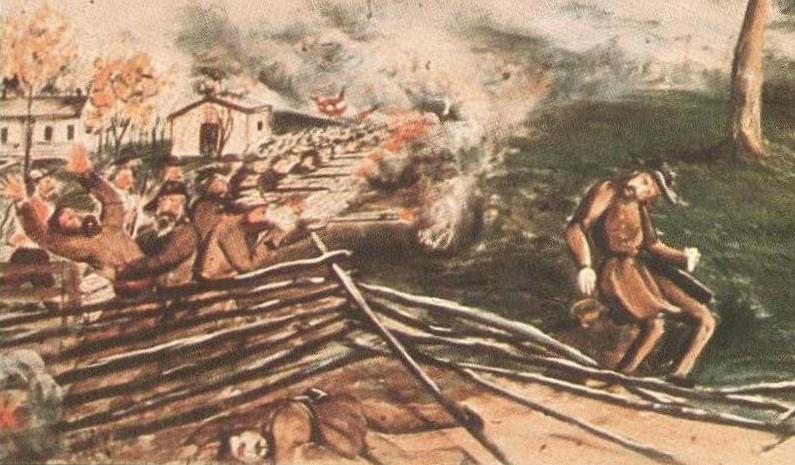
It bears mentioning that many Confederate issue, enlisted suits and privately acquired, officer frock coats and pants were made of brown cloth. Many uniformologists believe that brown Confederate uniforms were solely the by-product of faded, dyed gray cloth, but this is not the case. Contemporary descriptions and surviving uniforms attest to the use of brown cloth, and the post-war, panoramic painting "The Army of the Cumberland, Battle of Perryville" panel, by William D. T. Travis, illustrates this usage well. Travis had accompanied the Federal army as a staff artist for Harper’s Weekly and the New York Illustrated News during the war, and made his panorama from Civil War, on-the-spot sketches and memories. The painting now resides in the Smithsonian Institution.
Having considered some written accounts, we might now turn to surviving uniforms from the region. This is not an exact science, given all the variables involved with the Lower South’s small factory uniforms, but John Dimitry’s jacket may be one of them. It has provenance to early 1862, when Dimitry wore it at the Battle of Shiloh while serving with the Louisiana Crescent Regiment. He was so severely wounded at Shiloh that he was discharged from the army on August 9, 1862. He kept the jacket as a memento of his service. The jacket has nine buttons on the front, shoulder straps, a six-piece body, two-piece sleeves, and one-piece collar. The jacket has no topstitching. The lining is made from unbleached, white cotton sheeting. All the buttons are small, local Confederate staff buttons without backmarks, possibly Tice # CS278As1. The jacket is embellished with wool cord edging around the top of the collar and jacket edges, the shoulder straps, and the on the cuffs (in chevron form). Most of the cord has worn away, and that remaining has oxidized from black to green. The lower front panels have vertical darts sewn in from the bottom edge to draw in the waist. Each cuff has two brass buttons.
The basic, woolen-cotton jeans cloth is its most salient feature, since it appears to have two distinctly different fabrics in its construction, one a little darker than the other. The darker fabric has its nap intact and is a tannish-gray color. The lighter fabric has the nap worn away and is a tan color. In fact, only one fabric was used, the jacket having been incorrectly assembled. The front and back pieces, and right shoulder strap were constructed with the right (top) side of the cloth visible. The sleeve pieces (top and bottom), the collar and side pieces, and the left shoulder strap were constructed with the wrong (bottom) side of the cloth showing. This is apparent when one compares the fabric’s weave on the contrasting surfaces.[91]
The basic, woolen-cotton jeans cloth is its most salient feature, since it appears to have two distinctly different fabrics in its construction, one a little darker than the other. The darker fabric has its nap intact and is a tannish-gray color. The lighter fabric has the nap worn away and is a tan color. In fact, only one fabric was used, the jacket having been incorrectly assembled. The front and back pieces, and right shoulder strap were constructed with the right (top) side of the cloth visible. The sleeve pieces (top and bottom), the collar and side pieces, and the left shoulder strap were constructed with the wrong (bottom) side of the cloth showing. This is apparent when one compares the fabric’s weave on the contrasting surfaces.[91]
The next artifact is undated, but might be placed around the summer of 1862. That is the timeframe that foreign nationals, especially British, were encouraged to leave Confederate military service, and the jacket in question was supposedly worn by an Englishman who left the army and took his uniform as a memento back to England. The soldier is tentatively identified as “Parker” and his jacket has Louisiana pelican buttons (possibly Tice LA203A1). In any case, the jacket’s present owner, Don Troiani, describes it a light gray-brown, all cotton jeans cloth. It has six buttonholes on the front, with five of its pelican buttons still intact. An unusual feature of this jacket is that it is not only machine-stitched, but that many of the seams have machine-topstitching as reinforcement. The body of the jacket is four-piece (two front- and two back-pieces, but the front pieces have darts sewn from the bottom upwards under the sleeves, extending almost to the armpits. These darts occur about where a side piece seam would be placed, and this tailoring reflects an outmoded style used earlier in the nineteenth century. The sleeves are two-piece construction.[92] This early jacket may have been one of the simplified New Orleans factory jackets issued to Louisiana troops.
Another artifact with provenance to the same general timeframe is a pair of trousers worn by William Talran Morris, Company I, Columbia Guards, 38th Mississippi Infantry. The usage of the trousers is easy to pinpoint since Morris enlisted on March 25, 1862 and deserted the army on August 7, 1862. He most likely received them in March, and wore them for the entire, short duration of his service: barely four-and-a-half months. The pants are devoid of buttons and have patches on the knees, the latter indicating extended wear. The all-cotton, jeans cloth trousers have double stripes down each pants leg. The weft being dark-brown (faded from black) and the warp being undyed, natural white, originally giving the effect of an overall gray shade. The tabby weave’s warp and weft each consist of two yarns. The stripes are now a dark brown color but appear to have faded from black. The 13/16-inch wide stripes are woven into fabric itself about three quarters of an inch from the selvedge. The most unusual feature of these pants is the construction of the outseam between the front and rear panels. The seam is joined with virtually no curvature in the pattern, apparently to allow the two stripes to maintain an equal space from top to bottom. As such, the contour of the hip cannot be curved, and the waist opening is not tapered in relation to the legs, but is rather quite wide. There is also no separate waistband. This remarkable tailoring is not found in any other authenticated Confederate trousers.[93]
Another similar, well documented pair of pants stems from the same rough timeframe. These are James A. McKinstry’s trousers. McKinstry served in Company D, 42nd Alabama Infantry, and wore these trousers during the assault on Battery Robinett, Corinth, Missisippi, October 3, 1862. These trousers appear in Don Troiani’s, Regiments and Uniforms of the Civil War, wherein, Troiani describes them as “woven cotton butternut.” They appear in the book image to be a tan color, and have spring bottom cuffs and “V” pockets. The buttons are missing as is the rear adjustment belt, assuming the pants had one to begin with.[94] The pants origins are unknown, but they may have come from a factory in the Lower South. They may have come from the Columbus, Georgia Depot, which is known to have provided the Army of Mississippi with clothing in the fall of 1862. In any case, they represent a very early example of trousers used in the Lower South. It is also worth noting that the pants have spring bottom cuffs. Spring bottoms were popular for their practicality, and the Confederate uniform regulations even prescribed trousers to be, “made loose, and to spread well over the foot.” The spring bottom’s popularity is reflected in a letter by Captain James M. Williams, 21st Alabama Infantry, August 19, 1862, Fort Morgan, Alabama. Williams wrote to his wife, “I wish that you would make me a pair of pants… full in the leg, and large at the foot,…”[95]
Another similar, well documented pair of pants stems from the same rough timeframe. These are James A. McKinstry’s trousers. McKinstry served in Company D, 42nd Alabama Infantry, and wore these trousers during the assault on Battery Robinett, Corinth, Missisippi, October 3, 1862. These trousers appear in Don Troiani’s, Regiments and Uniforms of the Civil War, wherein, Troiani describes them as “woven cotton butternut.” They appear in the book image to be a tan color, and have spring bottom cuffs and “V” pockets. The buttons are missing as is the rear adjustment belt, assuming the pants had one to begin with.[94] The pants origins are unknown, but they may have come from a factory in the Lower South. They may have come from the Columbus, Georgia Depot, which is known to have provided the Army of Mississippi with clothing in the fall of 1862. In any case, they represent a very early example of trousers used in the Lower South. It is also worth noting that the pants have spring bottom cuffs. Spring bottoms were popular for their practicality, and the Confederate uniform regulations even prescribed trousers to be, “made loose, and to spread well over the foot.” The spring bottom’s popularity is reflected in a letter by Captain James M. Williams, 21st Alabama Infantry, August 19, 1862, Fort Morgan, Alabama. Williams wrote to his wife, “I wish that you would make me a pair of pants… full in the leg, and large at the foot,…”[95]
The next uniform to be discussed is a Confederate, depot-issue sack coat. This term requires an explanation because the garment that today’s uniformologists define as a “sack coat” would not have been considered such by the Confederate quartermaster. In fact, neither manufacturers nor quartermasters drew the slightest distinction between the typical, tight fitting jacket and the looser sack coat. They carried both garments in the inventories as “jackets.” Only today do we note slight differences between the depot sack coat and the typical jacket. These nuances included the bottom button being placed at elbow, or naval level: a feature that provided the illusion of a longer garment since there was a wider space between the bottom button and the bottom edge than the typical jacket had. The slightly extended skirt flared over the tops of the hips to accommodate the extra length, but the bottom edge seldom extended below the sleeve cuff. Most of these coats were cut with a simplified, four-piece body, rather than the six-piece body found in most jackets. They were typically made with only four or five buttons (less than many jackets), and usually had at least one exterior pocket. Interestingly, all the surviving sack coats are made of domestic fabric (jeans, satinet, and cassinet), and now appear tan or butternut-colored. All Confederate depot sack coats had the ubiquitous standing collar. All in all, the Confederate depot sack coat was not even a true sack coat. A true sack coat of the period was loose with a fall collar, and its length extended well below the bottom of the cuff. Yet, the Confederate depot sack coat differs just enough from the typical jacket to slightly resemble a sack coat and merit a category of its own.
There are five sack coat type jackets that are of interest in this study. Two have provenance to Georgia or East Tennessee. These include one of these was found by a Union soldier at the Cumberland Gap in the fall of 1862 and kept as a souvenir. This may have been worn by one of Kirby Smith’s Georgia troops and might have been made in Georgia. Another was worn by Union prisoner James Hughes at the Andersonville prison camp. This coat likewise probably came from Georgia. The other three depot sack coats appear to have provenance to the Lower South.[96]
There are five sack coat type jackets that are of interest in this study. Two have provenance to Georgia or East Tennessee. These include one of these was found by a Union soldier at the Cumberland Gap in the fall of 1862 and kept as a souvenir. This may have been worn by one of Kirby Smith’s Georgia troops and might have been made in Georgia. Another was worn by Union prisoner James Hughes at the Andersonville prison camp. This coat likewise probably came from Georgia. The other three depot sack coats appear to have provenance to the Lower South.[96]
The first of these was worn by Private George W. McDill of Company C, 9th Tennessee Infantry. According to family lore, McDill wore the coat when he was wounded and captured at the Battle of Perryville. In this case, the coat was probably issued in Tennessee or Mississippi a few months before the campaign, during late 1862. McDill’s coat is made of woolen-cotton jeans with an unbleached cotton warp and a tannish-gray colored weft, rendering an overall tannish-gray color to the coat. The weave has one weft over two and under one warp, and one warp over one and under two weft. The coat has a four-piece body (two front and two back pieces), two-piece collar, one-piece sleeves, with four front buttonholes, and two exterior, lower pockets in front. The pocket openings are positioned well below the bottom buttonhole. Three of the four Confederate eagle buttons remain intact, Tice # CS275A1, and these have no backmarks. The lining is unbleached osnaburg and the lapel facings are very wide. The hand-stitched coat is sewn with unbleached and light brown thread. There is no topstitching around the body or cuffs, but the collar has topstitching.[97]
The other two are of especially interesting because they are very similar and appear to have been made by the same manufacturer. One is completely without provenance, referred to as the Milwaukee Public Museum coat, and the other was taken home as a souvenir by an Ohio soldier named Purdum, but otherwise nothing is known about it. What is certain is that both coats have nearly identical tailoring and materials, and furthermore, they resemble a jacket in the Smithsonian Institution collection, the U-082 jacket, suggesting that all three came from the same factory, presumably one in Mississippi.
The body of the “Milwaukee” sack coat is made from a coarse, plain weave cloth with no visible nap. The warp is a natural white cotton and the weft a tan wool yarn. The lining is a fine weave osnaburg. It has an exterior pocket at the left breast, but no inside pockets. The inside of collar is two-piece, the outside of collar is one-piece, and there is a patch on under panel of the right sleeve. The bottom edge of the collar components are attached to the neckholes of the basic cloth and lining and folded up to be whipstitched closed along the top edge. It has two-piece sleeves, a four-piece body, and the front lapel bottoms are cut square. The tops of the wide lapel facings curve along the collar, joining with the lining back pieces. The coat has four buttonholes with all four cast Roman “I” buttons (Tice CSI281A) intact. Remarkably, the basic cloth of the sleeves is distinctly different from that in the body. While the sleeve components are a plain weave they are finer than that of the body and have a thick nap remaining intact. Additionally, the right front panel of the coat has a horizontal slit cut in it where the soldier fashioned an additional pocket.[98]
The body of the “Milwaukee” sack coat is made from a coarse, plain weave cloth with no visible nap. The warp is a natural white cotton and the weft a tan wool yarn. The lining is a fine weave osnaburg. It has an exterior pocket at the left breast, but no inside pockets. The inside of collar is two-piece, the outside of collar is one-piece, and there is a patch on under panel of the right sleeve. The bottom edge of the collar components are attached to the neckholes of the basic cloth and lining and folded up to be whipstitched closed along the top edge. It has two-piece sleeves, a four-piece body, and the front lapel bottoms are cut square. The tops of the wide lapel facings curve along the collar, joining with the lining back pieces. The coat has four buttonholes with all four cast Roman “I” buttons (Tice CSI281A) intact. Remarkably, the basic cloth of the sleeves is distinctly different from that in the body. While the sleeve components are a plain weave they are finer than that of the body and have a thick nap remaining intact. Additionally, the right front panel of the coat has a horizontal slit cut in it where the soldier fashioned an additional pocket.[98]
The Purdum sack coat matches both the Milwaukee coat down to a few minor differences. The weave and color of the basic cloth and the lining, and the overall tailoring to include the exterior, left breast pocket and four-piece body, match perfectly. The subtle differences include a shortened body that does not extend all the way to the cuff but is long enough to retain the bottom button at elbow height with a wide space between it and the bottom edge of the coat. The Purdum coat also has a two-piece collar and one-piece sleeves, and it has two remaining mismatched, stamped buttons instead of cast Roman “I” buttons, these being a Federal eagle and a Louisiana pelican. The collar folds upward to be closed along its top edge, just like that of the Milwaukee coat. The Purdum coat is essentially a slightly shortened and simplified version of the Milwaukee coat.[99]
In any case, the quartermaster manufactured very few sack coats, although the cut was very desirable. At least one quartermaster noted that soldiers needed a slightly longer jacket that was loose enough to fit comfortably over the tops of the hips and stay well-tucked under the soldier’s waist belt and accoutrements. Captain E.C. Wharton, Chief of the Houston Clothing Bureau, alluded to this on May 16, 1863. Wharton asked that if imported, ready-made clothing was provided, the jackets be, “…Grey Cloth to come below hips & with pockets.”[100] In this regard, the sack coat foreshadowed a growing trend in military uniforms: the rise of comfortable, practical field clothing instead of tight-fitting, stylish military tunics.
In any case, the quartermaster manufactured very few sack coats, although the cut was very desirable. At least one quartermaster noted that soldiers needed a slightly longer jacket that was loose enough to fit comfortably over the tops of the hips and stay well-tucked under the soldier’s waist belt and accoutrements. Captain E.C. Wharton, Chief of the Houston Clothing Bureau, alluded to this on May 16, 1863. Wharton asked that if imported, ready-made clothing was provided, the jackets be, “…Grey Cloth to come below hips & with pockets.”[100] In this regard, the sack coat foreshadowed a growing trend in military uniforms: the rise of comfortable, practical field clothing instead of tight-fitting, stylish military tunics.
The next uniform, consisting of jacket and trousers, is a mass-produced, factory-made, Confederate soldier suit. It is housed in the Smithsonian Institution and is identified only by its accession and catalog numbers, and by its donor, Charles Bremner Hogg Jackson. The Accession Number is 1980.0399 and Catalog Numbers are U-082 for the jacket, and Catalog Number U-083 for the pants. Although the uniform has no provenance, its tailoring and basic fabric match other artifacts with very strong provenance to Mississippi.
The U-082 jacket’s basic fabric is a plain, woolen-cotton weave, having an overall light brown color. Closer observation shows the cotton warp to have a yellowish-tan cast, and the woolen weft a light grayish tinge. The jacket’s lining is a fine-woven, unbleached white osnaburg. Both the jacket shell and lining have a four-piece body that includes two front and two back pieces, with the usual side pieces omitted. The U-082 facing lapels are very wide. The front has six buttonholes, sewn with light brown thread, and five remaining buttons. The buttons are solid cast, Roman “I” buttons (Tice CSI281A), but they appear to have been cast from white bronze. The seven-eighth inch diameter buttons have no backmarks and the faces are marred by imperfect sand-casting. The collar components were sewn to the shell and lining collar holes and folded upward to be closed along its top edge. Both outer and inner collar components are one-piece construction. The U-082 has one inside, patch-style pocket on the left side, one-piece sleeves, and has no topstitching around the edge of the jacket, the collar, or the cuffs.
The U-082’s similarities with other jackets in the region is noteworthy. The basic fabric weave matches that of the Anderson Depot style jackets, and the previously described Milwaukee and Purdum coats, suggesting that the fabric used for all these jackets came from the same factory, probably in Mississippi. The fabric color closely matches that observed in the Milwaukee and Purdum coats, and the U-082 lining is identical to those of the Milwaukee and Purdum coats, as well. The U-082 construction likewise mirrors the Milwaukee and Purdum coats in in all but length (the U-082 being shorter). It is noteworthy that the Parker and Appler (described hereafter) jackets, with firm provenance to Mississippi in 1862-1863, feature four-piece bodies, as well, and that the Appler jacket tailoring is similar to that of the Milwaukee and U-082 jackets. The U-082 wide facing lapels and upwards-folding collar match perfectly those of the Milwaukee coat (images of the Purdum coat lapels are not available), and the Appler jacket. Finally, the U-082 and Milwaukee jackets have identical buttons.
Nonetheless, subtle differences are noticeable between the U-082 and the aforementioned jackets. The Milwaukee coat body extends to its cuff, and the Purdum coat’s body is longer than the U-082’s. The Milwaukee coat has two-piece sleeves. The Milwaukee and Purdum coats also have topstitching around the edge of the body and collar, a four-button front and an exterior, inset, left breast pocket. Finally, the U-082 was made with a six-button front.
The similarities between the Milwaukee, Purdum and U-082 jackets strongly suggest that they shared a common pattern, and were made by the same manufacturer, using the same materials. They represent a gradual simplification, with minor improvements, to the same basic pattern. The Milwaukee coat represents the earliest variant with the longest body, two-piece sleeves, exterior pocket and four-button front (common to Confederate depot sack coats) with the bottom button placed at elbow level leaving a wide space between itself and the bottom edge. Its facing lapels curve back the lining back pieces. The Purdum coat represents the first simplifications, having a slightly shortened body and one-piece sleeves, but retaining the original button configuration used in the Milwaukee coat. The U-082 represents the final simplifications to a jacket, having a short body, one-piece sleeves, one-piece collar components and a simpler interior, patch pocket. The facing lapels were simplified by being cut straight from the collar to the bottom hem. The U-082 also received an improvement by getting more front buttons that were more evenly spaced towards the bottom of the jacket.
The U-082 jacket’s accompanying U-083 pants share characteristics with garments that have a clear provenance to Mississippi. The U-083 pants’ most notable characteristic is the very pronounced, contrasting brindling in the basic, twill-weave fabric. This is caused by mismatched shading of the weft yarn at random intervals that gives the effect of stripes throughout the length of the fabric. The most prominent weft yarn color is a grayish-tan, which in combination with the whitish-yellow cotton warp, gives the fabric a light tan cast overall. Contrasting with the grayish-tan fill yarns are layers of brownish-gray colored yarns that make up the “stripes.” Neither the weavers nor the uniform manufacturers apparently considered slight variances in weft yarn shade important, for they wove the mismatched yarns into runs of fabric and subsequently cut it into garment components. The yarn may have been dyed gray but is now faded. Regardless, the lighter and darker weft yarns owe their coloration to their natural fleece color, which in some instances was light and others dark. Perhaps the browner stripes are from natural brown-colored fleece fibers (from brown-colored sheep). In any case the light and the dark yarns were woven together indiscriminately, resulting in the striped, brindled fabric.[101] Another distinctive feature of the pants is the pocket construction. It is made similar to a watch pocket with a horizontal opening along the waistband seam. This feature is observed in Nathan Tisdale’s trousers that date to 1865, and a soldier at Bolton’s Depot, Mississippi in November 30, 1863, mentioned this feature, as well. Edwin Fay, of the Louisiana Minden Rangers, asked his wife to make a pair of pants for him that matched a pair of uniform pants that he had recently drawn from the quartermaster in that vicinity. Fay wanted the, “…the pockets to be put right in front, about two inches below the waistband cut right through the cloth in front... An inch and a half below the waistband will do.”[102] It seems that soldiers were fond of the watch style pocket.
The U-082 jacket’s basic fabric is a plain, woolen-cotton weave, having an overall light brown color. Closer observation shows the cotton warp to have a yellowish-tan cast, and the woolen weft a light grayish tinge. The jacket’s lining is a fine-woven, unbleached white osnaburg. Both the jacket shell and lining have a four-piece body that includes two front and two back pieces, with the usual side pieces omitted. The U-082 facing lapels are very wide. The front has six buttonholes, sewn with light brown thread, and five remaining buttons. The buttons are solid cast, Roman “I” buttons (Tice CSI281A), but they appear to have been cast from white bronze. The seven-eighth inch diameter buttons have no backmarks and the faces are marred by imperfect sand-casting. The collar components were sewn to the shell and lining collar holes and folded upward to be closed along its top edge. Both outer and inner collar components are one-piece construction. The U-082 has one inside, patch-style pocket on the left side, one-piece sleeves, and has no topstitching around the edge of the jacket, the collar, or the cuffs.
The U-082’s similarities with other jackets in the region is noteworthy. The basic fabric weave matches that of the Anderson Depot style jackets, and the previously described Milwaukee and Purdum coats, suggesting that the fabric used for all these jackets came from the same factory, probably in Mississippi. The fabric color closely matches that observed in the Milwaukee and Purdum coats, and the U-082 lining is identical to those of the Milwaukee and Purdum coats, as well. The U-082 construction likewise mirrors the Milwaukee and Purdum coats in in all but length (the U-082 being shorter). It is noteworthy that the Parker and Appler (described hereafter) jackets, with firm provenance to Mississippi in 1862-1863, feature four-piece bodies, as well, and that the Appler jacket tailoring is similar to that of the Milwaukee and U-082 jackets. The U-082 wide facing lapels and upwards-folding collar match perfectly those of the Milwaukee coat (images of the Purdum coat lapels are not available), and the Appler jacket. Finally, the U-082 and Milwaukee jackets have identical buttons.
Nonetheless, subtle differences are noticeable between the U-082 and the aforementioned jackets. The Milwaukee coat body extends to its cuff, and the Purdum coat’s body is longer than the U-082’s. The Milwaukee coat has two-piece sleeves. The Milwaukee and Purdum coats also have topstitching around the edge of the body and collar, a four-button front and an exterior, inset, left breast pocket. Finally, the U-082 was made with a six-button front.
The similarities between the Milwaukee, Purdum and U-082 jackets strongly suggest that they shared a common pattern, and were made by the same manufacturer, using the same materials. They represent a gradual simplification, with minor improvements, to the same basic pattern. The Milwaukee coat represents the earliest variant with the longest body, two-piece sleeves, exterior pocket and four-button front (common to Confederate depot sack coats) with the bottom button placed at elbow level leaving a wide space between itself and the bottom edge. Its facing lapels curve back the lining back pieces. The Purdum coat represents the first simplifications, having a slightly shortened body and one-piece sleeves, but retaining the original button configuration used in the Milwaukee coat. The U-082 represents the final simplifications to a jacket, having a short body, one-piece sleeves, one-piece collar components and a simpler interior, patch pocket. The facing lapels were simplified by being cut straight from the collar to the bottom hem. The U-082 also received an improvement by getting more front buttons that were more evenly spaced towards the bottom of the jacket.
The U-082 jacket’s accompanying U-083 pants share characteristics with garments that have a clear provenance to Mississippi. The U-083 pants’ most notable characteristic is the very pronounced, contrasting brindling in the basic, twill-weave fabric. This is caused by mismatched shading of the weft yarn at random intervals that gives the effect of stripes throughout the length of the fabric. The most prominent weft yarn color is a grayish-tan, which in combination with the whitish-yellow cotton warp, gives the fabric a light tan cast overall. Contrasting with the grayish-tan fill yarns are layers of brownish-gray colored yarns that make up the “stripes.” Neither the weavers nor the uniform manufacturers apparently considered slight variances in weft yarn shade important, for they wove the mismatched yarns into runs of fabric and subsequently cut it into garment components. The yarn may have been dyed gray but is now faded. Regardless, the lighter and darker weft yarns owe their coloration to their natural fleece color, which in some instances was light and others dark. Perhaps the browner stripes are from natural brown-colored fleece fibers (from brown-colored sheep). In any case the light and the dark yarns were woven together indiscriminately, resulting in the striped, brindled fabric.[101] Another distinctive feature of the pants is the pocket construction. It is made similar to a watch pocket with a horizontal opening along the waistband seam. This feature is observed in Nathan Tisdale’s trousers that date to 1865, and a soldier at Bolton’s Depot, Mississippi in November 30, 1863, mentioned this feature, as well. Edwin Fay, of the Louisiana Minden Rangers, asked his wife to make a pair of pants for him that matched a pair of uniform pants that he had recently drawn from the quartermaster in that vicinity. Fay wanted the, “…the pockets to be put right in front, about two inches below the waistband cut right through the cloth in front... An inch and a half below the waistband will do.”[102] It seems that soldiers were fond of the watch style pocket.
Subtle brindling is observed in many of the region’s uniforms. The Anderson Depot Hoey and unidentified lieutenant jackets offer examples of this shading, as do the Montgomery Gett 29076 & 29077 Depot jacket and pants. These uniforms date to late 1864 to 1865.[103] Edward W. Crozier’s jacket has more pronounced brindling. Crozier served with the Jefferson Davis Mississippi Artillery in the Department of Alabama, Mississippi and East Louisiana, and the jacket probably dates to 1865. Crozier’s jacket will be discussed at length further in the study.[104] A homemade frock coat made of Mississippi factory cloth, worn by a soldier named MaGee of the 7th Mississippi Infantry, exhibits the same pronounced brindling.[105] Its fabric weave is the same as that of the U-083 pants, as well (woolen-cotton jeans, one woolen weft over two and under one cotton warp, and one cotton warp over one and under two woolen weft). While the brindling does not help date the U-083 pants, it ties the fabric to Mississippi, since MaGee’s family made the coat there and presumably got the fabric from a local factory. Finally, the gray jeans pants of 3rd Lieutenant Gilbert Perry Gordy are distinctly brindled, pointing to the universality of this trait throughout the Lower South. Gordy served in the Chattahoochie Rangers from Columbus, Georgia (Company B, 30th Battalion Georgia State Troops, and Company B, 3rd Georgia Cavalry) from May 6, 1862 to at least December 1863.[106]
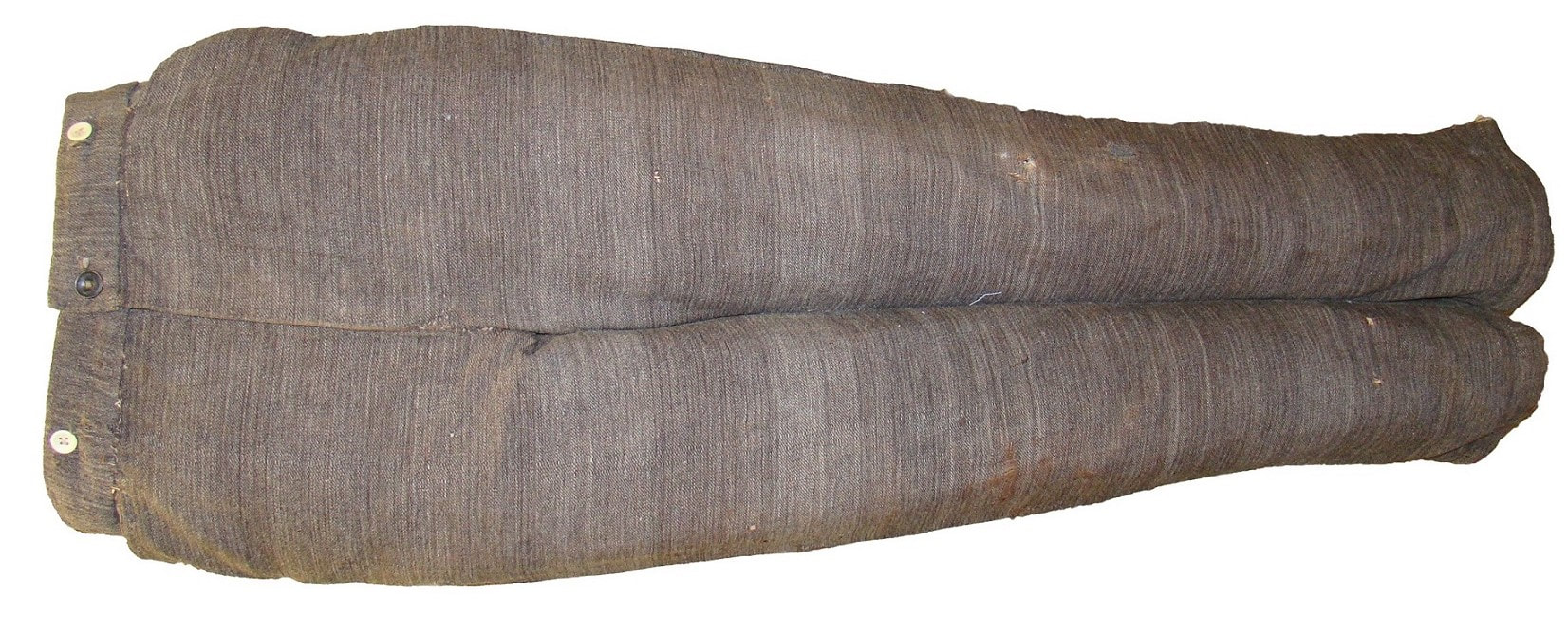
22b. This shows a complete view of Gordy's pants. It is likely that the homemade pants were made of Confederate factory cloth, as was the case with MaGee's coat. Had the yarns been homespun and home-dyed, it is unlikely that there would have been enough variation in the yarn color to create the striations referred to as brindling.
See continuation of this study in Part II: Click here to navigate to the next part...
Acknowledgments:
This study is greatly indebted to numerous institutions that shared their collections of artifacts and photos with me, as well as the scholars whose research formed a firm foundation upon which I could write my own study. To begin with the scholars, Ross Brooks’ ground-breaking study of Confederate quartermaster operations in Tennessee in Clothing of the Tennessee Volunteer, 1861 has changed uniformologists’ understanding of the Confederate Quartermaster. Brooks gave us the first in-depth study of early, Confederate government quartermaster operations, dating from the spring of 1861, that prove how pro-active and quickly the Confederate government established clothing manufacturing operations. Brooks highlighted the viability of the Southern home industry from the very start, which buries the myth that the Confederate quartermaster was not functional until 1862. Harold S. Wilson’s, Confederate Industry: Manufacturers and Quartermasters in the Civil War has proven itself an invaluable resource in this study, as in so many of my uniform studies. My good friend Thomas M. Arliskas has shared numerous insights with me about Confederate uniforms and his book, Cadet Grey and Butternut Brown: Notes on Confederate Uniforms never ceases to be a wellspring of facts relating to the Western Confederate’s clothing. Indeed, Arliskas’ book is the best single study ever having been written on the Confederate uniform, and no follow-on study can be complete without taking it into account. Leslie D. Jensen’s A Survey of Confederate Central Government Quartermaster Issue Jackets and Geoffrey R. Walden’s Confederate “Columbus Depot” Jackets: The Material Evidence remain seminal works since they were the first to define typologies of key uniforms manufactured in the Lower South. Finally, Ron Field’s two studies Charles F. Jackson: A Uniform Supplier of South Carolina, and Clothing the Confederate Soldiers of South Carolina, 1861-1865, Part 1: The State Quartermaster Department proved a godsend for this study. Field’s articles were published just when I was struggling with the Department of South Carolina, Georgia and Florida, having numerous photos, but little in the way of operational history. Field’s research allowed me to put my uniform research into a solid context of quartermaster operations. Other’s research proved valuable, as well. Vicki Betts’ newspaper database has been an invaluable resource in this, as in many of my studies. Michael Rugeley Moore’s The Texas Penitentiary and Textile Production in the Civil War Era proved indispensable in understanding Confederate quartermaster operations in Nashville and New Orleans from 1861 to 1862. Last of all, Bob Williams’ Confederate Quartermaster Stores: Savannah Coastal Defenses, was very useful in understanding quartermaster operations and products in that region.
No study of this type would be complete without an array of artifacts and photos to illustrate the subject matter. Numerous institutions, museum professionals and private collectors have shared their collections and their valuable time with me to round out this study. My thanks go out to them. For this part of the study, these include the Library of Congress, notably the Liljenquist collection; Don Troiani collection; Gary Hendershott Museum Consultants, Little Rock, Arkansas; Museum Director Pat Ricci and Confederate Memorial Hall, New Orleans, Louisiana; Camp Moore collection, Tangipahoa, Louisiana, The Horse Soldier collection, Gettysburg, Pennsylvania; Military Images, Harry Roach and Ron Coddington editors; Martin Callahan collection; Curator of Costumes and Collections, Wayne Phillips, Louisiana State Museum, New Orleans, Louisiana; Museum Curator, Robert Hancock and the American Civil War Museum, Richmond, Virginia; Skip Cryer collection; Lawrence T. Jones, III, Confederate Calendar Works, Austin, Texas; Clint Bryant family collection; Marti A. Funke and the University of Mississippi collection, Oxford, Mississippi; Smithsonian Institution, Washington, DC; Chris Watts family collection; CEO Ray Richey and the Texas Civil War Museum, Fort Worth, Texas; Museum Registrar Tammy Braithwaite and the Pink Palace Museum, Memphis, Tennessee; Museum Curator Albert Muchka and the Milwaukee Public Museum, Milwaukee, Wisconsin; Ross County Historical Society collection, Ohio; Curator Paul Shevchuk, Gettysburg National Park collection, Gettysburg, Pennsylvania; Curator Nan Prince, Mississippi Department of Archives and History collection, Jackson, Mississippi; Richard Greggory Grant, uniform consultant, Pitkin, Louisiana; and finally, Judge James McGlaun, Probate Court of Chattahoochie County, Cusseta, Georgia.
Copyright: All images in this article are copyrighted to the Adolphus Confederate Uniforms website with the exception of those that are part of the Library of Congress collection, the image of The Army of the Cumberland, Battle of Perryville painting by William D. T. Travis (part of the Smithsonian Institution collection), and the uncredited, Camp Douglas prisoner-of-war images.
Bibliography:
[1] Goff, Richard D., Confederate Supply, Duke University Press, Durham, North Carolina, 1969, pp. 70-71.
[2] The chief manufacturing cities fell to the enemy as follows: the Confederates evacuated Nashville on 23 February 1862, and the Federals captured it on 25 February 1862. The ancillary manufacturing center at Memphis fell on 6 June 1862. New Orleans fell to the Federals on 25 April 1862, and the ancillary manufacturing center at Baton Rouge on 9 May 1862.
[3] Brooks, Ross, Clothing of the Tennessee Volunteer, 1861, Company of Military Historians Journal, Volume 46, No. 2, Summer 1994, citations annotated by page, column and position in column (top, middle or bottom). This reference is 68/2m, and 70/2m. (Hereafter, Brooks).
[4] Brooks, 73/1m.
[5] Brooks, 68/2b & 69/1t; 70/2t.
[6] Brooks, 71/2b: 16 August 1861.
[7] Brooks, 71/2b & 72/1m/t.
[8] Brooks, 69/1b & 69/2t.
[9] Brooks, 68/2b.
[10] Moore, Michael Rugeley, The Texas Penitentiary and Textile Production in the Civil War Era, April 1984 for University degree, p. 109, see letter from Hendricks to Murray, 4 January 1864, note 63; and, CSA QM General Myers sought to ship Texas wool to the Cis-Mississippi Confederacy, (hereafter, Moore).
[11] Brooks, 70/1m.
[12] Moore, pp. 134-136.
[13] Brooks, 70/1b.
[14] Brooks, 71/1t.
[15] Brooks, 71/2t and 73/1t.
[16] Brooks, 73/1t&m.
[17] Brooks, 68/1b & 68/2t.
[18] Brooks, 73/2b.
[19] Brooks, 73/1b & 73/2b.
[20] Wilson, Harold S., Confederate Industry: Manufacturers and Quartermasters in the Civil War, University of Mississippi Press, Jackson, 2002, p. 28, (hereafter, Wilson).
[21] Arliskas, Thomas M., Cadet Grey and Butternut Brown: Notes on Confederate Uniforms, Thomas Publications, Gettysburg, PA, pp. 20, note 19, p. 99, Ch 1, Pt 3, (hereafter, Arliskas).
[22] Arliskas, p. 27.
[23] Arliskas, p. 28, n. 6, p. 100.
[24] Arliskas, p. 29, note 12, p. 100, Ch 1, Pt 5; Brooks, Ross, Military Collector & Historian, Journal of the Company of Military Historians, Washington, DC, Vol. 51, No. 2, Summer 1999, p. 80, from the New Orleans Daily Delta, 2 March 1862.
[25] Arliskas, p. 29, notes 13 and 14, p. 100.
[26] Arliskas, p. 29, note 15, page 100.
[27] Arliskas, pp. 29-31, note 16, page 100.
[28] Arliskas, p. 31, note 18, page 100: Bearss, E.C., Unconditional Surrender, the Fall of Fort Donelson, Tennessee Historical Quarterly, March 1962, p. 37.
[29] Arliskas, p. 34, note 29, p. 100.
[30] Arliskas, p. 34, note 34, p. 100: Woodstock [Illinois] Sentinel, soldier’s letter of December 15, 1862.
[31] Watson, William, Life in the Confederate Army, Louisiana State University Press, Baton Rouge and London, 1995, p. 139.
[32] Moore, p. 29.
[33] Tunnard, W.H., A Southern Record: The History of the Third Regiment Louisiana Infantry, Morningside Bookshop, Dayton, Ohio, 1998, p. 92.
[34] Confederate Papers Relating to Citizens or Business Firms, Microfilm Publication 346, Roll 428, War Department Collection of Confederate Records, Record Group 109, National Archives, Washington D.C., (hereafter, CSA Citizens, with appropriate name and roll), Hebrard & Co.
[35] CSA Citizens, Levy, Simon & Co., Roll 584.
[36] CSA Citizens, M. Godchaux, Frere & Co., Roll 358.
[37] CSA Citizens, Joseph N. Robert & Co., Roll 870.
[38] CSA Citizens, N.C. Folger & Son, Roll 313.
[39] CSA Citizens, Belden & Eames, Roll 55.
[40] CSA Citizens, Bauer & Co., Roll 49.
[41] CSA Citizens, Frost & Co., Roll 327.
[42] CSA Citizens, Fiquet & Boulet, Roll 304.
[43] Chance, Joseph E., From Shiloh to Vicksburg: The Second Texas Infantry, Eakin Press, Austin, Texas, 1984, p. 24, dates of the regiments movements; and, “Some Confederate War Incidents,” General J.C. Moore, Confederate Veteran, Volume XII, March 1904, p. 116.
[44] Moore, pp. 134-135.
[45] Camp Moore, located near the Mississippi border in East Louisiana on a major rail line, was the largest training camp in the state. There were at least sixteen other training camps around the state, and many of these would also have received the so-called “Camp Moore” style uniform, as well.
[46] The 5th Louisiana frock coat is courtesy of Don Troiani.
[47] Confederate Quartermaster General, Colonel Abraham C. Meyers, mandated the universal adoption of the jacket before the official uniform regulations were even published. On May 31, 1861, Meyers called for the quartermaster in New Orleans to furnish jackets rather than tunics, asking that 5,000 gray jackets and pants to be furnished, “…or any color you can get…” On 5 June he again asked that jackets and trousers be manufactured as the standard Confederate uniform. See Colonel A.C. Myers, Confederate Quartermaster General, to Captain John M. Galt, AQM New Orleans, May 31 and June 5, 1861, Letters and Telegrams Sent, Confederate Quartermaster General’s Office, National Archives, Record Group 109.7.3. Galt’s responses are in Register of Letters Received, Confederate Quartermaster General’s Office, National Archives, Record Group 109.7.3.
[48] The O’Brien jacket is courtesy of Confederate Memorial Hall, New Orleans, Louisiana, (hereafter Confederate Memorial Hall); War Department Collection of Confederate Records, Record Group 109, National Archives, Washington DC, Compiled Service Records of Confederate Soldiers from Louisiana, M320, Roll 295, 18th Louisiana Infantry Regiment, Patrick O’Brien, (hereafter, the service records are annotated as “CSR” with the state). Author examined the trousers 19-20 November 2010 and 12 February 2015.
[49] The Pittman trousers are courtesy of Confederate Memorial Hall; CSR Louisiana, M320, Roll 43, 1st Louisiana Heavy Artillery, Enos Pittman. Author examined the trousers 19-20 November 2010 and 12 February 2015.
[50] Artifact and image are courtesy of the Horse Soldier antique store, Gettysburg, Pennsylvania.
[51] Brooks, Ross, Military Collector & Historian, Journal of the Company of Military Historians, Washington, DC, Vol. 51, No. 2, Summer 1999, p. 80, from the Cincinnati Commercial and the New Orleans Daily Delta, 15 March 1862.
[52] Brooks, Ross, Military Collector & Historian, Journal of the Company of Military Historians, Washington, DC, Vol. 51, No. 2, Summer 1999; Fields, Ron, Brassey’s History of Uniforms: American Civil War Confederate Army, Brassey’s Ltd, London, 1996, p. 55.
[53] Military Images, Volume VII, No. 2, September-October 1985, back cover, Kean Wilcox collection.
[54] Military Images, Volume XII No. 2, September-October 1990 front cover, Martin Callahan collection. According to another owner of this image, Roy Mantle, the image was taken prior to November 1861, see Warren K. Tice, Uniform Buttons of the United States, 1776-1865, Thomas Publications, Gettysburg, PA, 1997, p. 287, (hereafter, Tice).
[55] The Kernion hat is courtesy of the Louisiana State Museum, New Orleans, Louisiana, (hereafter, Louisiana State Museum); CSR Louisiana, M320, Roll 324, A.L.H. Kernion, 22nd/23rd Louisiana Infantry. Author examined the hat on 12 November 2010. Mosler painting courtesy of the American Civil War Museum, Richmond, Virginia, (hereafter, ACWM).
[56] The two unidentified Confederates are from the Library of Congress, Liljenquist collection; the Daniel G. Lambert image is in the Camp Moore collection; and, the Amasa V. Going image is in Military Images, Volume XVI September-October 1994, p. 36, see also Portraits of Conflict: A Photographic History of Louisiana in the Civil War, University of Arkansas Press, Fayetteville, Arkansas, 1990, p. 10, J. Dale West collection, (hereafter, Portraits of Conflict Louisiana, with page and notation).
[57] Milligan, Edward S., Military Collector & Historian, Journal of the Company of Military Historians, Washington, DC, Vol. 53, No. 3, Fall 2001, p. 137.
[58] Image courtesy of Skip Cryer, West Louisiana and Fort Polk Cultural Resources.
[59] Michael Thomas Bryant image is courtesy of his descendent, the great-great-grandson Clint Bryant. Interestingly, Private Bryant wears a cap with dark band and a pelican waist belt plate.
[60] Portrait of William H. Jenkins and father courtesy of Confederate Memorial Hall collection. Martin served in the 7th Louisiana Infantry and his father, James Martin, was a captain in the Algiers Battalion, Louisiana Militia.
[61] Regrettably, the author was not able to see the backmarks on the Seymour jacket buttons, since it would have involved loosening the jacket from the exhibit form that it was mounted on, and it would have risked loosening the fragile button stitch from the jacket.
[62] The Seymour jacket and pants are in the Confederate Memorial Hall collection. Author examined the jacket and pants on 9 August 2002 and 15 December 2015.
[63] Confederate Memorial Hall accession registrations include: 001.019 and 001.020 for Colonel William Seymour, two cadet gray, double-breasted frock coats; and, 001.034a & .034c for Isaac Seymour, jacket and pants.
[64] Image courtesy of Lawrence T. Jones III, Confederate Calendar, October 1992, Confederate Calendar Works, Austin, Texas, (hereafter, Confederate Calendar with appropriate date).
[65] Image courtesy of Lawrence T. Jones III,Confederate Calendar, March 1991; CSR Louisiana, M320, Roll 286, R. McMichael.
[66] Moore, p. 29.
[67] Moore, p. 53.
[68] Refence muster rolls for the 11th Texas Infantry, 3rd Texas Infantry and 13th Texas Cavalry Dismounted, see War Department Collection of Confederate Records, Record Group 109, National Archives, Washington DC. Specific examples include: December 1862, the 11th Texas Infantry Battalion, Companies C & F reported having clothing that was “Good but not uniform” in their muster rolls; the 3rd Texas Infantry Regiment muster rolls comments for clothing on 30 June, 31 August and 31 October 1862 note that the companies have either “good” or “indifferent” clothing, and it is known that they had true uniforms: either Federal or Confederate of various types; the 13th Texas Dismounted Cavalry Regiment had inspector remarks on 30 April “indifferent & 1 [company] inferior,” and on 30 June, “good,” “moderate,” “indifferent” or “inferior.”
[69] Memphis Daily Appeal, Grenada, Mississippi, August 14, 1862, p. 1, c. 8, Civil War Newspaper Transcriptions, Vicki Betts, http://www.uttyl.edu/vbetts/
[70] Cockrell, Thomas D. and Ballard, Michael B., editors, A Mississippi Rebel in the Army of Northern Virginia: The Civil War Memoirs of Private David Holt, Louisiana State University Press, Baton Rouge, 1995, p. 64.
[71] CSA Citizens, Edward McGehee, Roll 629; Edward McGehee’s factory was named the Wilkinson Manufacturing Company, located in Woodville, Wilkinson County, Mississippi. It was commonly referred to as the Woodville factory or McGehee’s factory. Federal troops destroyed the factory circa July 1863.
[72] Cockrell, Thomas D. and Ballard, Michael B., editors, A Mississippi Rebel in the Army of Northern Virginia: The Civil War Memoirs of Private David Holt, Louisiana State University Press, Baton Rouge, 1995, p. 65.
[73] The 1st Mississippi Artillery jacket is courtesy of Don Troiani.
[74] CSA Citizens, Roll 166, Clark & Joseph, September 25, 1862, Jackson, Mississippi.
[75] Artifact courtesy of the University of Mississippi; information from Marti A. Funke, University of Mississippi, Oxford, Mississippi; and CSR Mississippi, M269, Roll 21, W.D. Howell, 3rd Mississippi Cavalry.
[76] Wilson, p. 193; CSA Citizens, James M. Wesson, Mississippi Manufacturing Company, Rolls 694 and 1091, (research courtesy of Will MacDonald, Mississippi). Wesson’s factory was located in Bankston, Choctaw County, Mississippi, and was also referred to as the Bankston Mill, the Choctaw Mill and Wesson’s factory. The mill was destroyed by Federal forces on December 30, 1864.
[77] CSA Citizens, Thomas Green, Roll 376; Green’s factory was also known as the Pearl River Mill, the Thomas Green Mill, and it may be the “Jackson Manufactory” mentioned in some sources, if this name is not referring to the Jackson State penitentiary mill. In any case, the factory was destroyed by Federal forces during the 14-16 May 1863 enemy occupation.
[78] Wilson, pp. 24-25.
[79] Wilson, pp. 40-41.
[80] American Civil War Museum, Catalog # 0985.00.00030b, swatch of uniform cloth made by the Prattville Manufacturing Company, Alabama, donated by Captain H. W. Henry, Company K, 22nd Alabama Infantry.
[81] Confederate Citizens file, M346, Roll 818: Citizen records, Daniel Pratt; and, Business records, Prattville Manufacturing Company, Alabama.
[82] CSA Citizens, Cossit, Hill & Co., Roll 197 for coat & pants goods, 864 yards @ $0.75; 949 yards @ $1.00; 300 yards @ $1.75; 200 yards @ $2.00.
[83] Folmar, John Kent, Editor, From That Terrible Field: Civil War Letters of James M. Williams, Twenty-First Alabama Infantry Volunteers, The University of Alabama Press, Tuscaloosa, 1981, page numbers not available.
[84] W.H.A. Cox Letters, 18th Alabama Infantry, http://www.flemingmultimedia.com/Personal/CSA/letters.html.
[85] Memphis Daily Appeal [From the Correspondence of the Charleston Courier], May 30, 1862, p. 1, c. 5, Civil War Newspaper Transcriptions, Vicki Betts, http://www.uttyl.edu/vbetts/
[86] Brooks, Ross, Military Collector & Historian, Journal of the Company of Military Historians, Washington, DC, Vol. 50, No. 3, Fall 1998, Sterling Price’s Division, 1862, p. 127, from the New Orleans Daily True Delta, 30 March 1862, page 1, column 3, Letter from Corinth, 21 March 1862.
[ix] Brooks, Ross, Military Collector & Historian, Journal of the Company of Military Historians, Washington, DC, Vol. 51, No. 2, Summer 1999
[87] Memphis Daily Appeal [Grenada, Mississippi], July 2, 1862, p. 1, c. 1, Civil War Newspaper Transcriptions by Vicki Betts, http://www.uttyl.edu/vbetts/
[88] Howell, Jr, H. Grady, Going to Meet the Yankees: A History of the ‘Bloody Sixth’ Mississippi Infantry, C.S.A., Chickasaw Bayou Press, Jackson, Mississippi, 1981, p. 120 (see note 21, p. 127: CSR Mississippi, M269, Rolls 155-159).
[89] Daniel Johnson papers, 9th Kentucky Cavalry, US, courtesy of Kurt Holman-Parks, Park Historian, Perryville National Battlefield.
[90] From the original Civil War letters of George Asbury Bruton, 19th Louisiana Infantry, edited by Richard H. Holloway, Historian, Alexandria, Louisiana, 1988.
[91] The Dimitry jacket is courtesy of the ACWM collection; CSR Louisiana, M320, Roll 382, Company C, Crescent Regiment, Louisiana Infantry, J.B.S. Dimitry.
[92] The Parker jacket is courtesy of Don Troiani; service records are inconclusive.
[93] The Morris trousers are courtesy of Chris Watts, Columbia, Mississippi; CSR Mississippi, M269, Roll 64, Company I, 38th Mississippi Cavalry, T.T. Morris, (originally infantry). Author examined the trousers on 10 December 2016.
[94] Coats, Earl J., McAfee, Michael J. and Troiani, Don, Don Troiani’s Regiments and Uniforms of the Civil War, Stackpole Books, Mechanicsburg, PA & China, 2002, p. 119, artifact courtesy of James Vance.
[95] From That Terrible Field: Civil War Letters of James M. Williams, Twenty-First Alabama Infantry Volunteers, Edited by John Kent Folmar, The University of Alabama Press, Tuscaloosa, 1981, page numbers not available.
[96] The Cumberland Gap coat is in the Texas Civil War Museum collection, Fort Worth, Texas (hereafter, TCWM) and the images are courtesy of Heritage Auctions and the author. Author examined the jacket on 19 February 2016. The Hughes coat is part of the New York State Military Museum collection and its provenance was provided by this institution.
[97] The McDill jacket is courtesy of the Pink Palace Museum collection, Memphis, Tennessee, and on exhibit at the Mud Island Museum, Memphis, Tennessee. Since I was only able to view the coat through the glass of the vitrine, I have relied on Les Jensen’s notes for many of the coat’s details. Author examined the jacket on 14 September and 4 October 2016. The coat was worn by Private George W. McDill, Company C, 9th Tennessee Infantry, “The Southern Confederates,” CSR Tennessee, M268, Roll 154, G.W. McDill.
[98] The “Milwaukee” artifact is part of the Milwaukee Public Museum collection, and formerly of the Chicago Historical Society, Libby Prison Collection. It is without provenance, listed as “Confederate Blouse, Catalog Number H39010-26109.” Tom Arliskas made the initial observations of the coat, first hand, on 8 March 2018, and the author subsequently used the Arliskas images to elaborate on these observations.
[99] The Purdum coat resides in the Ross County Historical Society, Ohio.
[100] Report of Captain E.C. Wharton, Chief Quartermaster, District of Texas, December 22, 1863, File 113-J.41, Estimate for Clothing and Clothing Material for 2nd Year Commencing October 8, 1863, Eastern Mil Sub District of Texas, E.C. Wharton, Captain & AQM, Houston, Texas, May 16, 1863, (reports from 89-J.41 through 158-J.41), Captain E.C. Wharton, Confederate Inspection Reports, M935, Roll 8, War Department Collection of Confederate Records, Record Group 109, National Archives, Washington DC. (Hereafter, Wharton followed by report number).
[101] Smithsonian Institution, Washington, DC (hereafter, SI), uniform of jacket and trousers from the Charles Bremner Hogg Jackson collection, without provenance, identified to its catalog numbers U-082 and U-083. The collar construction could not be observed since it was encased in conservation netting. Author examined the jacket and trousers in May 1996, and on 16 December 2010.
[102] Fay, Edwin, This Infernal War: The Confederate Letters of Edwin H. Fay, Edited by Bell Irvin Wiley with the assistance of Lucy E. Fay, University of Texas Press, Austin, 1958, pp. 370.
[103] Several Montgomery and Anderson Depot uniforms exhibit varying degrees of brindling. Of the Montgomery jackets and pants, there are the Gett 29076 & 29077 artifacts in the Gettysburg National Park collection, Gettysburg, Pennsylvania, author examined the jacket and trousers on 17 December 2010; the SI 1980.0399.0921 jacket (catalog number U081) in the SI collection, Washington, DC, author examined the jacket on 16 December 2010; the Stone jacket in the Sam Higginbotham collection, Orange, Virginia, author examined the jacket on 17 October 2013; and, the Mook jacket in the National Battlefield Park collection of Wilson’s Creek, Missouri, author examined the jacket on 31 October 1998. Anderson jackets with brindling include the Hoey and the First Lieutenant jackets in the Louisiana State Museum collection, New Orleans, Louisiana (hereafter, LSM), author examined these jackets on 12 November 2010, 14 November 2014 and 27 October 2015; and, the Buck jacket in a private collection, author examined the jacket on 27 July 2015. Further details and images are available in the author’s article Confederate Depot Uniforms of the Department of Alabama, Mississippi and East Louisiana, 1864-1865.
[104] The Crozier jacket is courtesy of the ACWM.
[105] The MaGee coat is courtesy of the Mississippi Department of Archives and History, (hereafter, MDAH), Jackson, Mississippi. Author examined the coat on 12 September 2011.
[106] The Gordy uniform is courtesy of the Office of the Probate Judge, Chattahoochee County Courthouse, Cusseta, Georgia. CSR Georgia, M266, Roll 17, Company B, 3rd Georgia Cavalry; records pertaining to Gordy’s service in the 30th Battalion Georgia State Troops are not available.
Acknowledgments:
This study is greatly indebted to numerous institutions that shared their collections of artifacts and photos with me, as well as the scholars whose research formed a firm foundation upon which I could write my own study. To begin with the scholars, Ross Brooks’ ground-breaking study of Confederate quartermaster operations in Tennessee in Clothing of the Tennessee Volunteer, 1861 has changed uniformologists’ understanding of the Confederate Quartermaster. Brooks gave us the first in-depth study of early, Confederate government quartermaster operations, dating from the spring of 1861, that prove how pro-active and quickly the Confederate government established clothing manufacturing operations. Brooks highlighted the viability of the Southern home industry from the very start, which buries the myth that the Confederate quartermaster was not functional until 1862. Harold S. Wilson’s, Confederate Industry: Manufacturers and Quartermasters in the Civil War has proven itself an invaluable resource in this study, as in so many of my uniform studies. My good friend Thomas M. Arliskas has shared numerous insights with me about Confederate uniforms and his book, Cadet Grey and Butternut Brown: Notes on Confederate Uniforms never ceases to be a wellspring of facts relating to the Western Confederate’s clothing. Indeed, Arliskas’ book is the best single study ever having been written on the Confederate uniform, and no follow-on study can be complete without taking it into account. Leslie D. Jensen’s A Survey of Confederate Central Government Quartermaster Issue Jackets and Geoffrey R. Walden’s Confederate “Columbus Depot” Jackets: The Material Evidence remain seminal works since they were the first to define typologies of key uniforms manufactured in the Lower South. Finally, Ron Field’s two studies Charles F. Jackson: A Uniform Supplier of South Carolina, and Clothing the Confederate Soldiers of South Carolina, 1861-1865, Part 1: The State Quartermaster Department proved a godsend for this study. Field’s articles were published just when I was struggling with the Department of South Carolina, Georgia and Florida, having numerous photos, but little in the way of operational history. Field’s research allowed me to put my uniform research into a solid context of quartermaster operations. Other’s research proved valuable, as well. Vicki Betts’ newspaper database has been an invaluable resource in this, as in many of my studies. Michael Rugeley Moore’s The Texas Penitentiary and Textile Production in the Civil War Era proved indispensable in understanding Confederate quartermaster operations in Nashville and New Orleans from 1861 to 1862. Last of all, Bob Williams’ Confederate Quartermaster Stores: Savannah Coastal Defenses, was very useful in understanding quartermaster operations and products in that region.
No study of this type would be complete without an array of artifacts and photos to illustrate the subject matter. Numerous institutions, museum professionals and private collectors have shared their collections and their valuable time with me to round out this study. My thanks go out to them. For this part of the study, these include the Library of Congress, notably the Liljenquist collection; Don Troiani collection; Gary Hendershott Museum Consultants, Little Rock, Arkansas; Museum Director Pat Ricci and Confederate Memorial Hall, New Orleans, Louisiana; Camp Moore collection, Tangipahoa, Louisiana, The Horse Soldier collection, Gettysburg, Pennsylvania; Military Images, Harry Roach and Ron Coddington editors; Martin Callahan collection; Curator of Costumes and Collections, Wayne Phillips, Louisiana State Museum, New Orleans, Louisiana; Museum Curator, Robert Hancock and the American Civil War Museum, Richmond, Virginia; Skip Cryer collection; Lawrence T. Jones, III, Confederate Calendar Works, Austin, Texas; Clint Bryant family collection; Marti A. Funke and the University of Mississippi collection, Oxford, Mississippi; Smithsonian Institution, Washington, DC; Chris Watts family collection; CEO Ray Richey and the Texas Civil War Museum, Fort Worth, Texas; Museum Registrar Tammy Braithwaite and the Pink Palace Museum, Memphis, Tennessee; Museum Curator Albert Muchka and the Milwaukee Public Museum, Milwaukee, Wisconsin; Ross County Historical Society collection, Ohio; Curator Paul Shevchuk, Gettysburg National Park collection, Gettysburg, Pennsylvania; Curator Nan Prince, Mississippi Department of Archives and History collection, Jackson, Mississippi; Richard Greggory Grant, uniform consultant, Pitkin, Louisiana; and finally, Judge James McGlaun, Probate Court of Chattahoochie County, Cusseta, Georgia.
Copyright: All images in this article are copyrighted to the Adolphus Confederate Uniforms website with the exception of those that are part of the Library of Congress collection, the image of The Army of the Cumberland, Battle of Perryville painting by William D. T. Travis (part of the Smithsonian Institution collection), and the uncredited, Camp Douglas prisoner-of-war images.
Bibliography:
[1] Goff, Richard D., Confederate Supply, Duke University Press, Durham, North Carolina, 1969, pp. 70-71.
[2] The chief manufacturing cities fell to the enemy as follows: the Confederates evacuated Nashville on 23 February 1862, and the Federals captured it on 25 February 1862. The ancillary manufacturing center at Memphis fell on 6 June 1862. New Orleans fell to the Federals on 25 April 1862, and the ancillary manufacturing center at Baton Rouge on 9 May 1862.
[3] Brooks, Ross, Clothing of the Tennessee Volunteer, 1861, Company of Military Historians Journal, Volume 46, No. 2, Summer 1994, citations annotated by page, column and position in column (top, middle or bottom). This reference is 68/2m, and 70/2m. (Hereafter, Brooks).
[4] Brooks, 73/1m.
[5] Brooks, 68/2b & 69/1t; 70/2t.
[6] Brooks, 71/2b: 16 August 1861.
[7] Brooks, 71/2b & 72/1m/t.
[8] Brooks, 69/1b & 69/2t.
[9] Brooks, 68/2b.
[10] Moore, Michael Rugeley, The Texas Penitentiary and Textile Production in the Civil War Era, April 1984 for University degree, p. 109, see letter from Hendricks to Murray, 4 January 1864, note 63; and, CSA QM General Myers sought to ship Texas wool to the Cis-Mississippi Confederacy, (hereafter, Moore).
[11] Brooks, 70/1m.
[12] Moore, pp. 134-136.
[13] Brooks, 70/1b.
[14] Brooks, 71/1t.
[15] Brooks, 71/2t and 73/1t.
[16] Brooks, 73/1t&m.
[17] Brooks, 68/1b & 68/2t.
[18] Brooks, 73/2b.
[19] Brooks, 73/1b & 73/2b.
[20] Wilson, Harold S., Confederate Industry: Manufacturers and Quartermasters in the Civil War, University of Mississippi Press, Jackson, 2002, p. 28, (hereafter, Wilson).
[21] Arliskas, Thomas M., Cadet Grey and Butternut Brown: Notes on Confederate Uniforms, Thomas Publications, Gettysburg, PA, pp. 20, note 19, p. 99, Ch 1, Pt 3, (hereafter, Arliskas).
[22] Arliskas, p. 27.
[23] Arliskas, p. 28, n. 6, p. 100.
[24] Arliskas, p. 29, note 12, p. 100, Ch 1, Pt 5; Brooks, Ross, Military Collector & Historian, Journal of the Company of Military Historians, Washington, DC, Vol. 51, No. 2, Summer 1999, p. 80, from the New Orleans Daily Delta, 2 March 1862.
[25] Arliskas, p. 29, notes 13 and 14, p. 100.
[26] Arliskas, p. 29, note 15, page 100.
[27] Arliskas, pp. 29-31, note 16, page 100.
[28] Arliskas, p. 31, note 18, page 100: Bearss, E.C., Unconditional Surrender, the Fall of Fort Donelson, Tennessee Historical Quarterly, March 1962, p. 37.
[29] Arliskas, p. 34, note 29, p. 100.
[30] Arliskas, p. 34, note 34, p. 100: Woodstock [Illinois] Sentinel, soldier’s letter of December 15, 1862.
[31] Watson, William, Life in the Confederate Army, Louisiana State University Press, Baton Rouge and London, 1995, p. 139.
[32] Moore, p. 29.
[33] Tunnard, W.H., A Southern Record: The History of the Third Regiment Louisiana Infantry, Morningside Bookshop, Dayton, Ohio, 1998, p. 92.
[34] Confederate Papers Relating to Citizens or Business Firms, Microfilm Publication 346, Roll 428, War Department Collection of Confederate Records, Record Group 109, National Archives, Washington D.C., (hereafter, CSA Citizens, with appropriate name and roll), Hebrard & Co.
[35] CSA Citizens, Levy, Simon & Co., Roll 584.
[36] CSA Citizens, M. Godchaux, Frere & Co., Roll 358.
[37] CSA Citizens, Joseph N. Robert & Co., Roll 870.
[38] CSA Citizens, N.C. Folger & Son, Roll 313.
[39] CSA Citizens, Belden & Eames, Roll 55.
[40] CSA Citizens, Bauer & Co., Roll 49.
[41] CSA Citizens, Frost & Co., Roll 327.
[42] CSA Citizens, Fiquet & Boulet, Roll 304.
[43] Chance, Joseph E., From Shiloh to Vicksburg: The Second Texas Infantry, Eakin Press, Austin, Texas, 1984, p. 24, dates of the regiments movements; and, “Some Confederate War Incidents,” General J.C. Moore, Confederate Veteran, Volume XII, March 1904, p. 116.
[44] Moore, pp. 134-135.
[45] Camp Moore, located near the Mississippi border in East Louisiana on a major rail line, was the largest training camp in the state. There were at least sixteen other training camps around the state, and many of these would also have received the so-called “Camp Moore” style uniform, as well.
[46] The 5th Louisiana frock coat is courtesy of Don Troiani.
[47] Confederate Quartermaster General, Colonel Abraham C. Meyers, mandated the universal adoption of the jacket before the official uniform regulations were even published. On May 31, 1861, Meyers called for the quartermaster in New Orleans to furnish jackets rather than tunics, asking that 5,000 gray jackets and pants to be furnished, “…or any color you can get…” On 5 June he again asked that jackets and trousers be manufactured as the standard Confederate uniform. See Colonel A.C. Myers, Confederate Quartermaster General, to Captain John M. Galt, AQM New Orleans, May 31 and June 5, 1861, Letters and Telegrams Sent, Confederate Quartermaster General’s Office, National Archives, Record Group 109.7.3. Galt’s responses are in Register of Letters Received, Confederate Quartermaster General’s Office, National Archives, Record Group 109.7.3.
[48] The O’Brien jacket is courtesy of Confederate Memorial Hall, New Orleans, Louisiana, (hereafter Confederate Memorial Hall); War Department Collection of Confederate Records, Record Group 109, National Archives, Washington DC, Compiled Service Records of Confederate Soldiers from Louisiana, M320, Roll 295, 18th Louisiana Infantry Regiment, Patrick O’Brien, (hereafter, the service records are annotated as “CSR” with the state). Author examined the trousers 19-20 November 2010 and 12 February 2015.
[49] The Pittman trousers are courtesy of Confederate Memorial Hall; CSR Louisiana, M320, Roll 43, 1st Louisiana Heavy Artillery, Enos Pittman. Author examined the trousers 19-20 November 2010 and 12 February 2015.
[50] Artifact and image are courtesy of the Horse Soldier antique store, Gettysburg, Pennsylvania.
[51] Brooks, Ross, Military Collector & Historian, Journal of the Company of Military Historians, Washington, DC, Vol. 51, No. 2, Summer 1999, p. 80, from the Cincinnati Commercial and the New Orleans Daily Delta, 15 March 1862.
[52] Brooks, Ross, Military Collector & Historian, Journal of the Company of Military Historians, Washington, DC, Vol. 51, No. 2, Summer 1999; Fields, Ron, Brassey’s History of Uniforms: American Civil War Confederate Army, Brassey’s Ltd, London, 1996, p. 55.
[53] Military Images, Volume VII, No. 2, September-October 1985, back cover, Kean Wilcox collection.
[54] Military Images, Volume XII No. 2, September-October 1990 front cover, Martin Callahan collection. According to another owner of this image, Roy Mantle, the image was taken prior to November 1861, see Warren K. Tice, Uniform Buttons of the United States, 1776-1865, Thomas Publications, Gettysburg, PA, 1997, p. 287, (hereafter, Tice).
[55] The Kernion hat is courtesy of the Louisiana State Museum, New Orleans, Louisiana, (hereafter, Louisiana State Museum); CSR Louisiana, M320, Roll 324, A.L.H. Kernion, 22nd/23rd Louisiana Infantry. Author examined the hat on 12 November 2010. Mosler painting courtesy of the American Civil War Museum, Richmond, Virginia, (hereafter, ACWM).
[56] The two unidentified Confederates are from the Library of Congress, Liljenquist collection; the Daniel G. Lambert image is in the Camp Moore collection; and, the Amasa V. Going image is in Military Images, Volume XVI September-October 1994, p. 36, see also Portraits of Conflict: A Photographic History of Louisiana in the Civil War, University of Arkansas Press, Fayetteville, Arkansas, 1990, p. 10, J. Dale West collection, (hereafter, Portraits of Conflict Louisiana, with page and notation).
[57] Milligan, Edward S., Military Collector & Historian, Journal of the Company of Military Historians, Washington, DC, Vol. 53, No. 3, Fall 2001, p. 137.
[58] Image courtesy of Skip Cryer, West Louisiana and Fort Polk Cultural Resources.
[59] Michael Thomas Bryant image is courtesy of his descendent, the great-great-grandson Clint Bryant. Interestingly, Private Bryant wears a cap with dark band and a pelican waist belt plate.
[60] Portrait of William H. Jenkins and father courtesy of Confederate Memorial Hall collection. Martin served in the 7th Louisiana Infantry and his father, James Martin, was a captain in the Algiers Battalion, Louisiana Militia.
[61] Regrettably, the author was not able to see the backmarks on the Seymour jacket buttons, since it would have involved loosening the jacket from the exhibit form that it was mounted on, and it would have risked loosening the fragile button stitch from the jacket.
[62] The Seymour jacket and pants are in the Confederate Memorial Hall collection. Author examined the jacket and pants on 9 August 2002 and 15 December 2015.
[63] Confederate Memorial Hall accession registrations include: 001.019 and 001.020 for Colonel William Seymour, two cadet gray, double-breasted frock coats; and, 001.034a & .034c for Isaac Seymour, jacket and pants.
[64] Image courtesy of Lawrence T. Jones III, Confederate Calendar, October 1992, Confederate Calendar Works, Austin, Texas, (hereafter, Confederate Calendar with appropriate date).
[65] Image courtesy of Lawrence T. Jones III,Confederate Calendar, March 1991; CSR Louisiana, M320, Roll 286, R. McMichael.
[66] Moore, p. 29.
[67] Moore, p. 53.
[68] Refence muster rolls for the 11th Texas Infantry, 3rd Texas Infantry and 13th Texas Cavalry Dismounted, see War Department Collection of Confederate Records, Record Group 109, National Archives, Washington DC. Specific examples include: December 1862, the 11th Texas Infantry Battalion, Companies C & F reported having clothing that was “Good but not uniform” in their muster rolls; the 3rd Texas Infantry Regiment muster rolls comments for clothing on 30 June, 31 August and 31 October 1862 note that the companies have either “good” or “indifferent” clothing, and it is known that they had true uniforms: either Federal or Confederate of various types; the 13th Texas Dismounted Cavalry Regiment had inspector remarks on 30 April “indifferent & 1 [company] inferior,” and on 30 June, “good,” “moderate,” “indifferent” or “inferior.”
[69] Memphis Daily Appeal, Grenada, Mississippi, August 14, 1862, p. 1, c. 8, Civil War Newspaper Transcriptions, Vicki Betts, http://www.uttyl.edu/vbetts/
[70] Cockrell, Thomas D. and Ballard, Michael B., editors, A Mississippi Rebel in the Army of Northern Virginia: The Civil War Memoirs of Private David Holt, Louisiana State University Press, Baton Rouge, 1995, p. 64.
[71] CSA Citizens, Edward McGehee, Roll 629; Edward McGehee’s factory was named the Wilkinson Manufacturing Company, located in Woodville, Wilkinson County, Mississippi. It was commonly referred to as the Woodville factory or McGehee’s factory. Federal troops destroyed the factory circa July 1863.
[72] Cockrell, Thomas D. and Ballard, Michael B., editors, A Mississippi Rebel in the Army of Northern Virginia: The Civil War Memoirs of Private David Holt, Louisiana State University Press, Baton Rouge, 1995, p. 65.
[73] The 1st Mississippi Artillery jacket is courtesy of Don Troiani.
[74] CSA Citizens, Roll 166, Clark & Joseph, September 25, 1862, Jackson, Mississippi.
[75] Artifact courtesy of the University of Mississippi; information from Marti A. Funke, University of Mississippi, Oxford, Mississippi; and CSR Mississippi, M269, Roll 21, W.D. Howell, 3rd Mississippi Cavalry.
[76] Wilson, p. 193; CSA Citizens, James M. Wesson, Mississippi Manufacturing Company, Rolls 694 and 1091, (research courtesy of Will MacDonald, Mississippi). Wesson’s factory was located in Bankston, Choctaw County, Mississippi, and was also referred to as the Bankston Mill, the Choctaw Mill and Wesson’s factory. The mill was destroyed by Federal forces on December 30, 1864.
[77] CSA Citizens, Thomas Green, Roll 376; Green’s factory was also known as the Pearl River Mill, the Thomas Green Mill, and it may be the “Jackson Manufactory” mentioned in some sources, if this name is not referring to the Jackson State penitentiary mill. In any case, the factory was destroyed by Federal forces during the 14-16 May 1863 enemy occupation.
[78] Wilson, pp. 24-25.
[79] Wilson, pp. 40-41.
[80] American Civil War Museum, Catalog # 0985.00.00030b, swatch of uniform cloth made by the Prattville Manufacturing Company, Alabama, donated by Captain H. W. Henry, Company K, 22nd Alabama Infantry.
[81] Confederate Citizens file, M346, Roll 818: Citizen records, Daniel Pratt; and, Business records, Prattville Manufacturing Company, Alabama.
[82] CSA Citizens, Cossit, Hill & Co., Roll 197 for coat & pants goods, 864 yards @ $0.75; 949 yards @ $1.00; 300 yards @ $1.75; 200 yards @ $2.00.
[83] Folmar, John Kent, Editor, From That Terrible Field: Civil War Letters of James M. Williams, Twenty-First Alabama Infantry Volunteers, The University of Alabama Press, Tuscaloosa, 1981, page numbers not available.
[84] W.H.A. Cox Letters, 18th Alabama Infantry, http://www.flemingmultimedia.com/Personal/CSA/letters.html.
[85] Memphis Daily Appeal [From the Correspondence of the Charleston Courier], May 30, 1862, p. 1, c. 5, Civil War Newspaper Transcriptions, Vicki Betts, http://www.uttyl.edu/vbetts/
[86] Brooks, Ross, Military Collector & Historian, Journal of the Company of Military Historians, Washington, DC, Vol. 50, No. 3, Fall 1998, Sterling Price’s Division, 1862, p. 127, from the New Orleans Daily True Delta, 30 March 1862, page 1, column 3, Letter from Corinth, 21 March 1862.
[ix] Brooks, Ross, Military Collector & Historian, Journal of the Company of Military Historians, Washington, DC, Vol. 51, No. 2, Summer 1999
[87] Memphis Daily Appeal [Grenada, Mississippi], July 2, 1862, p. 1, c. 1, Civil War Newspaper Transcriptions by Vicki Betts, http://www.uttyl.edu/vbetts/
[88] Howell, Jr, H. Grady, Going to Meet the Yankees: A History of the ‘Bloody Sixth’ Mississippi Infantry, C.S.A., Chickasaw Bayou Press, Jackson, Mississippi, 1981, p. 120 (see note 21, p. 127: CSR Mississippi, M269, Rolls 155-159).
[89] Daniel Johnson papers, 9th Kentucky Cavalry, US, courtesy of Kurt Holman-Parks, Park Historian, Perryville National Battlefield.
[90] From the original Civil War letters of George Asbury Bruton, 19th Louisiana Infantry, edited by Richard H. Holloway, Historian, Alexandria, Louisiana, 1988.
[91] The Dimitry jacket is courtesy of the ACWM collection; CSR Louisiana, M320, Roll 382, Company C, Crescent Regiment, Louisiana Infantry, J.B.S. Dimitry.
[92] The Parker jacket is courtesy of Don Troiani; service records are inconclusive.
[93] The Morris trousers are courtesy of Chris Watts, Columbia, Mississippi; CSR Mississippi, M269, Roll 64, Company I, 38th Mississippi Cavalry, T.T. Morris, (originally infantry). Author examined the trousers on 10 December 2016.
[94] Coats, Earl J., McAfee, Michael J. and Troiani, Don, Don Troiani’s Regiments and Uniforms of the Civil War, Stackpole Books, Mechanicsburg, PA & China, 2002, p. 119, artifact courtesy of James Vance.
[95] From That Terrible Field: Civil War Letters of James M. Williams, Twenty-First Alabama Infantry Volunteers, Edited by John Kent Folmar, The University of Alabama Press, Tuscaloosa, 1981, page numbers not available.
[96] The Cumberland Gap coat is in the Texas Civil War Museum collection, Fort Worth, Texas (hereafter, TCWM) and the images are courtesy of Heritage Auctions and the author. Author examined the jacket on 19 February 2016. The Hughes coat is part of the New York State Military Museum collection and its provenance was provided by this institution.
[97] The McDill jacket is courtesy of the Pink Palace Museum collection, Memphis, Tennessee, and on exhibit at the Mud Island Museum, Memphis, Tennessee. Since I was only able to view the coat through the glass of the vitrine, I have relied on Les Jensen’s notes for many of the coat’s details. Author examined the jacket on 14 September and 4 October 2016. The coat was worn by Private George W. McDill, Company C, 9th Tennessee Infantry, “The Southern Confederates,” CSR Tennessee, M268, Roll 154, G.W. McDill.
[98] The “Milwaukee” artifact is part of the Milwaukee Public Museum collection, and formerly of the Chicago Historical Society, Libby Prison Collection. It is without provenance, listed as “Confederate Blouse, Catalog Number H39010-26109.” Tom Arliskas made the initial observations of the coat, first hand, on 8 March 2018, and the author subsequently used the Arliskas images to elaborate on these observations.
[99] The Purdum coat resides in the Ross County Historical Society, Ohio.
[100] Report of Captain E.C. Wharton, Chief Quartermaster, District of Texas, December 22, 1863, File 113-J.41, Estimate for Clothing and Clothing Material for 2nd Year Commencing October 8, 1863, Eastern Mil Sub District of Texas, E.C. Wharton, Captain & AQM, Houston, Texas, May 16, 1863, (reports from 89-J.41 through 158-J.41), Captain E.C. Wharton, Confederate Inspection Reports, M935, Roll 8, War Department Collection of Confederate Records, Record Group 109, National Archives, Washington DC. (Hereafter, Wharton followed by report number).
[101] Smithsonian Institution, Washington, DC (hereafter, SI), uniform of jacket and trousers from the Charles Bremner Hogg Jackson collection, without provenance, identified to its catalog numbers U-082 and U-083. The collar construction could not be observed since it was encased in conservation netting. Author examined the jacket and trousers in May 1996, and on 16 December 2010.
[102] Fay, Edwin, This Infernal War: The Confederate Letters of Edwin H. Fay, Edited by Bell Irvin Wiley with the assistance of Lucy E. Fay, University of Texas Press, Austin, 1958, pp. 370.
[103] Several Montgomery and Anderson Depot uniforms exhibit varying degrees of brindling. Of the Montgomery jackets and pants, there are the Gett 29076 & 29077 artifacts in the Gettysburg National Park collection, Gettysburg, Pennsylvania, author examined the jacket and trousers on 17 December 2010; the SI 1980.0399.0921 jacket (catalog number U081) in the SI collection, Washington, DC, author examined the jacket on 16 December 2010; the Stone jacket in the Sam Higginbotham collection, Orange, Virginia, author examined the jacket on 17 October 2013; and, the Mook jacket in the National Battlefield Park collection of Wilson’s Creek, Missouri, author examined the jacket on 31 October 1998. Anderson jackets with brindling include the Hoey and the First Lieutenant jackets in the Louisiana State Museum collection, New Orleans, Louisiana (hereafter, LSM), author examined these jackets on 12 November 2010, 14 November 2014 and 27 October 2015; and, the Buck jacket in a private collection, author examined the jacket on 27 July 2015. Further details and images are available in the author’s article Confederate Depot Uniforms of the Department of Alabama, Mississippi and East Louisiana, 1864-1865.
[104] The Crozier jacket is courtesy of the ACWM.
[105] The MaGee coat is courtesy of the Mississippi Department of Archives and History, (hereafter, MDAH), Jackson, Mississippi. Author examined the coat on 12 September 2011.
[106] The Gordy uniform is courtesy of the Office of the Probate Judge, Chattahoochee County Courthouse, Cusseta, Georgia. CSR Georgia, M266, Roll 17, Company B, 3rd Georgia Cavalry; records pertaining to Gordy’s service in the 30th Battalion Georgia State Troops are not available.
